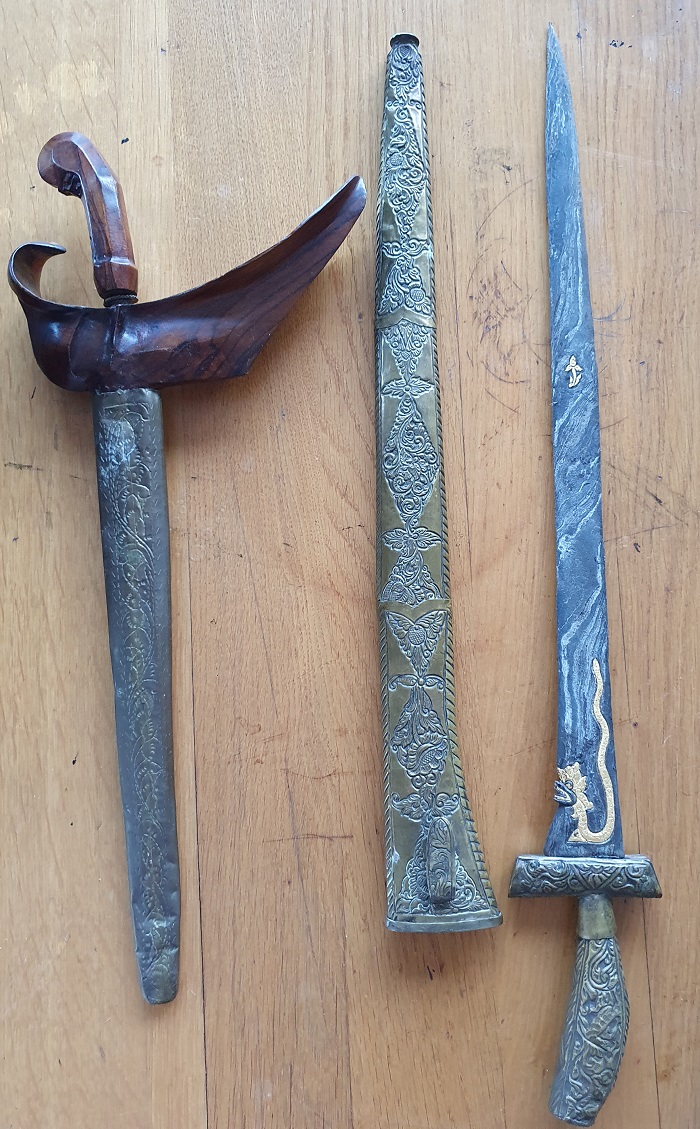Indonesische Spiritualiteit
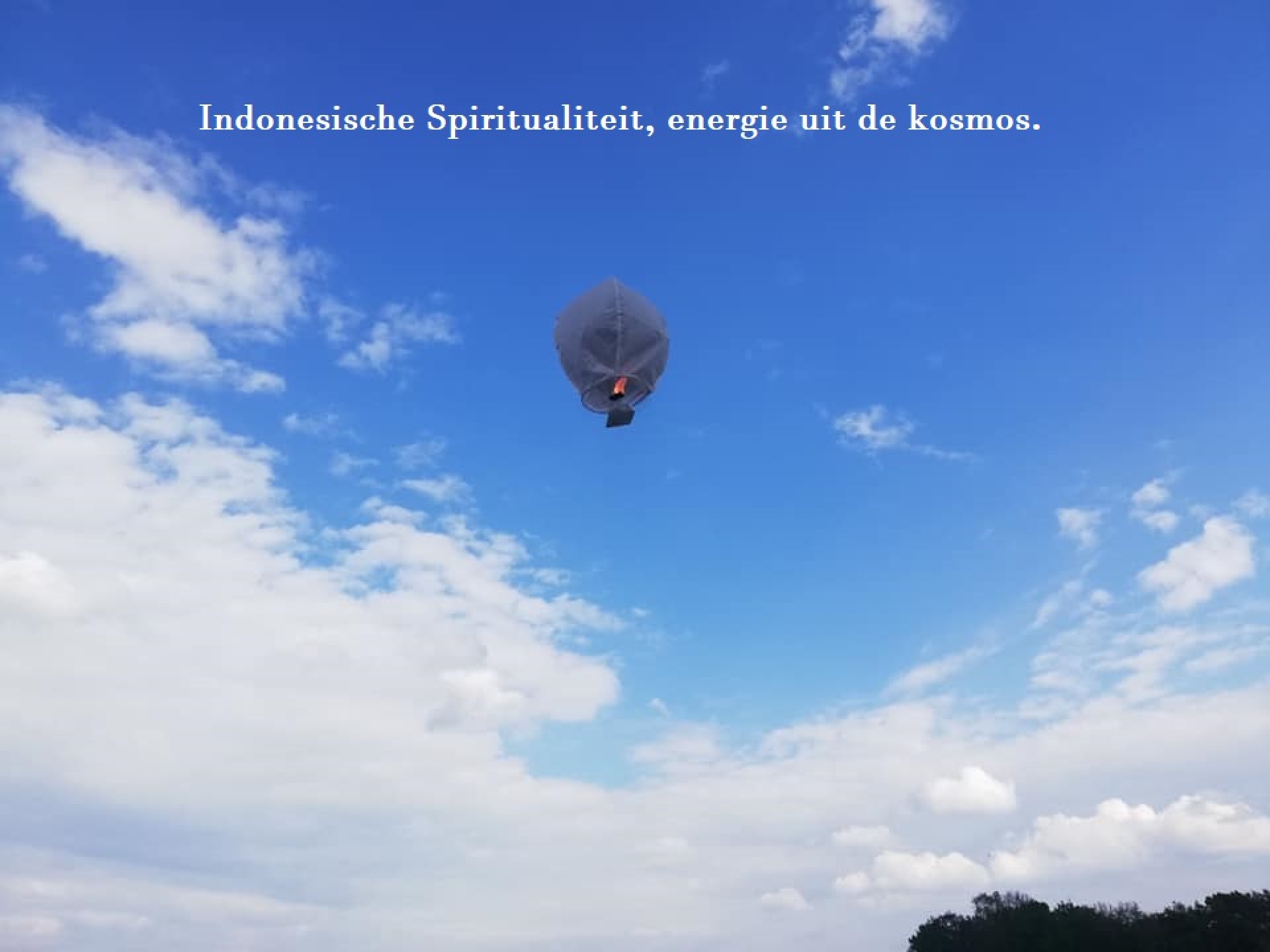
My keris pusaka my life

I am born in the Nehterlands, but 100% Indonesian. My mother is born in Bandung and my father is born in Yogjakarta. Like me there are 2.000.000 people who have their roots in Indonesia, and we
are the biggest etnic group in the Netherlands.
For us the Indonesian culture is very important, because that is our identity as Indo!
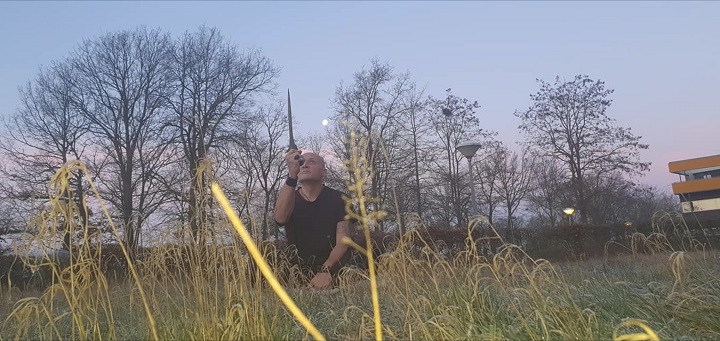
I live in Europe, but i am so proude of my Javanese origine. My father is born in Yogjakarta, but my grand grand father was a Wedono from east Java, Prajekan.
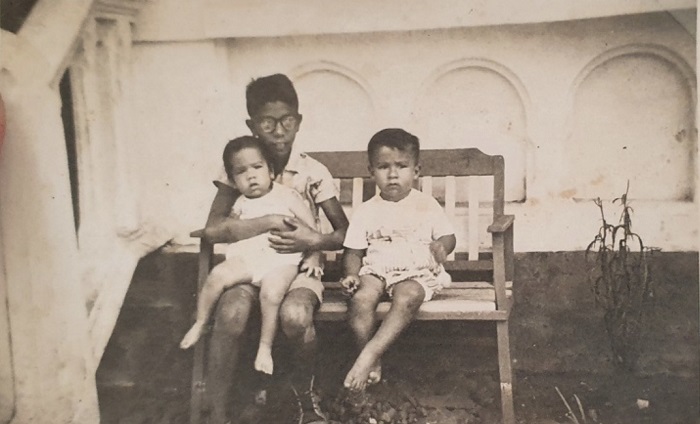
Beautiful picture of my father and his brothers in Jogyakarta.
My mother is born in Bandung
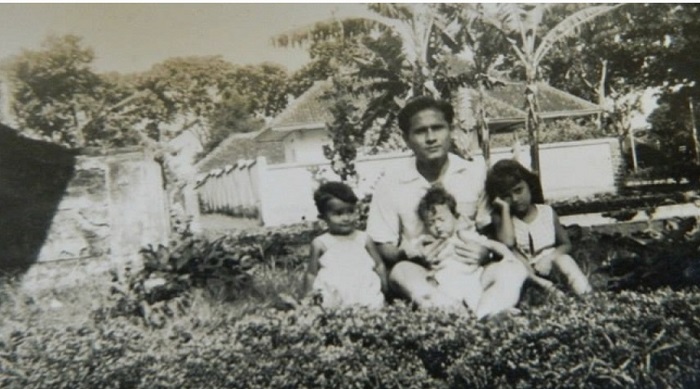
Beautiful picture of my mother with my uncles and my grandfather.
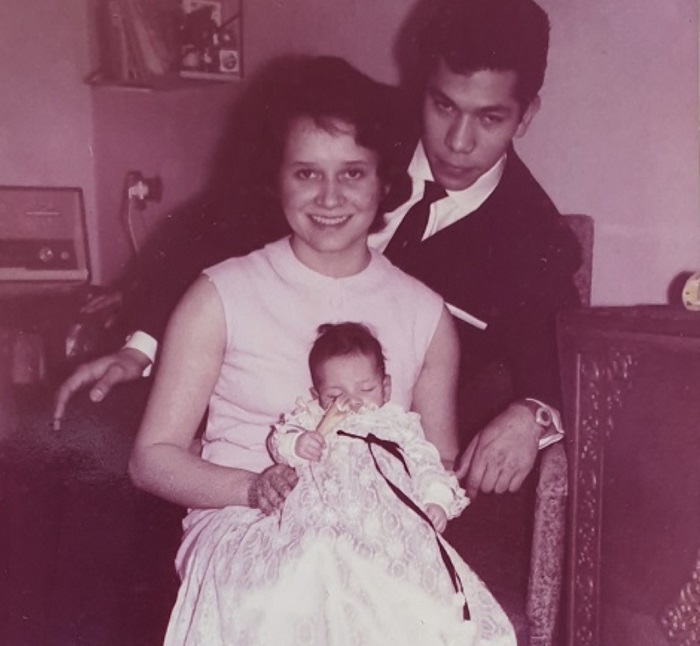
Me and my parents..
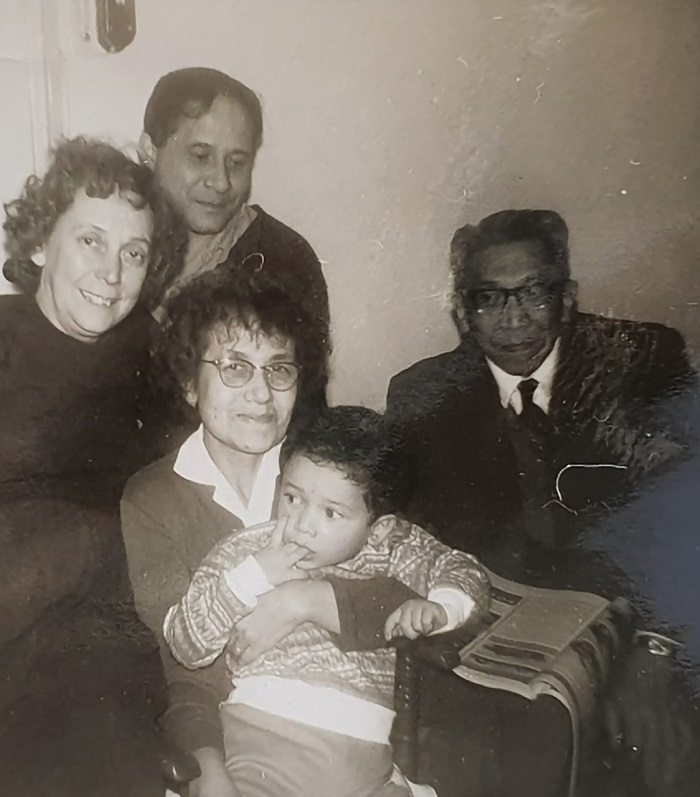
I love this picture with on the left my grand parents Opa Willy and Oma Marceline and on the right Opa Dolf and Oma Annie, who told me al those beautiful stories of the keris.
Let me tel you a littlebit about my life and of my keris...uripku.
I got my fathers keris in 1995, unfortunatly my father passed away much to early in 23 november 1996. I remember very good when i had the keris in my hands once, the keris opened himself for me by shaking firm in my hands...
He was there and never left. This is were it started.
When i got a pusaka keris from my father in the '90s i used a very old Gatotkaca tempat keris and that was the start of a spiritual journey.
This is the oldest picture i could find of my fathers keris, in 1998 in my home in Arnhem.
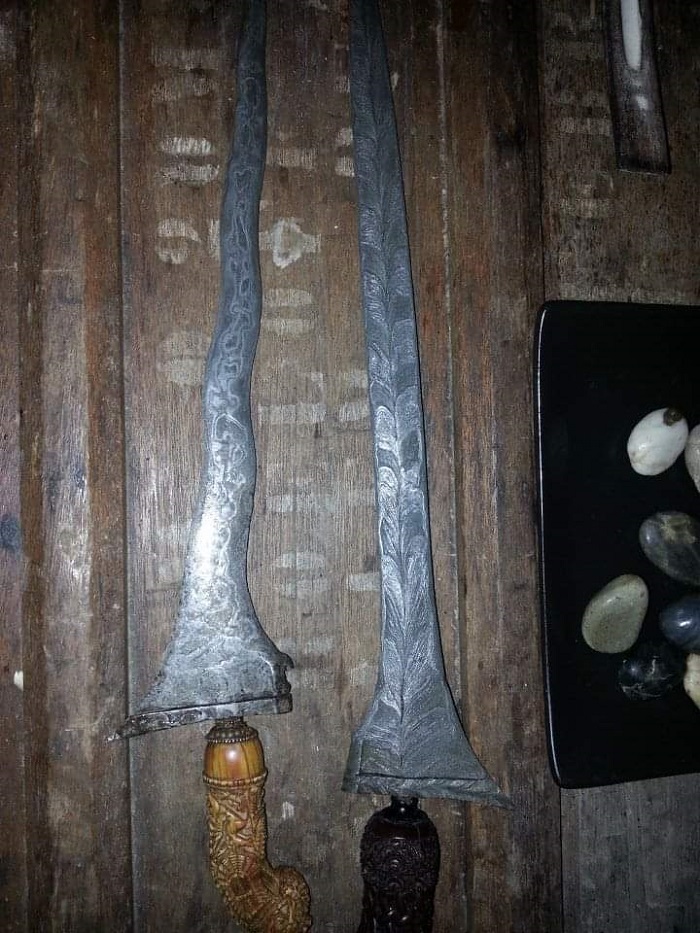
My very old tempat keris with an image Gatotkaca of the Mahabarata carved in wood, and a very old keris patrem from Yogjakarta.

If you take good care of your keris, more keris come on your way. And i don't mean that you buy a keris, but the keris is handed over to you. A given keris is there for you for life, you don't sell those keris because that brings misfortune. I know people who did, and their whole life is upside down....
A keris you buy by Mas Kawin you can sell. So after the first keris, the second didn't wait long to come.

My Candhi Omah from 2004 to 2015. I lived in a farm then, having lots of cattle, especially lots of game chickens.
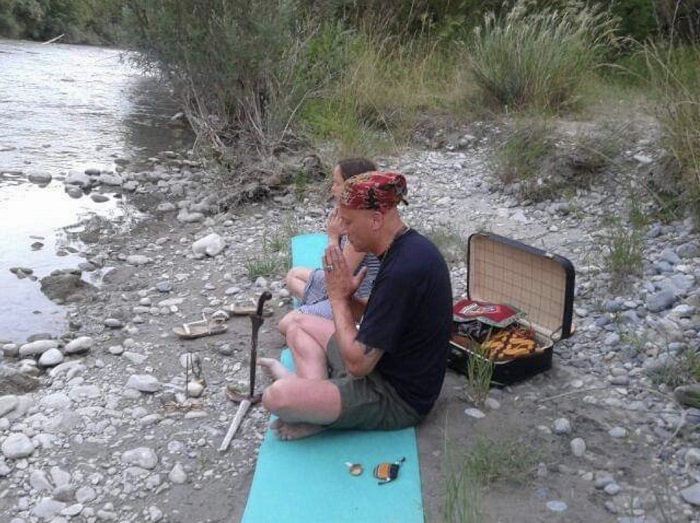
Meditation in the Gorge du Verdon 2009
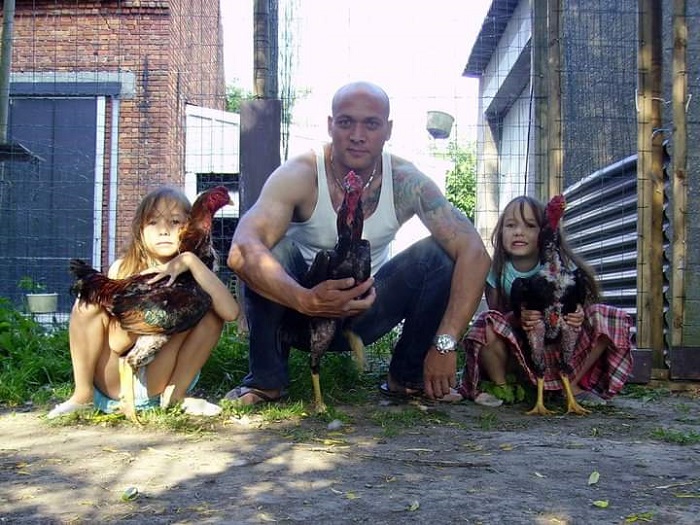
Breeding gamecock is also a typical Indonesian hobby. In the north of France, fighting is legal, but the European tradition is fighting with weapons. We fight the natural way, the way they fight in the jungle. Do not do to an animal what you don't do your self!
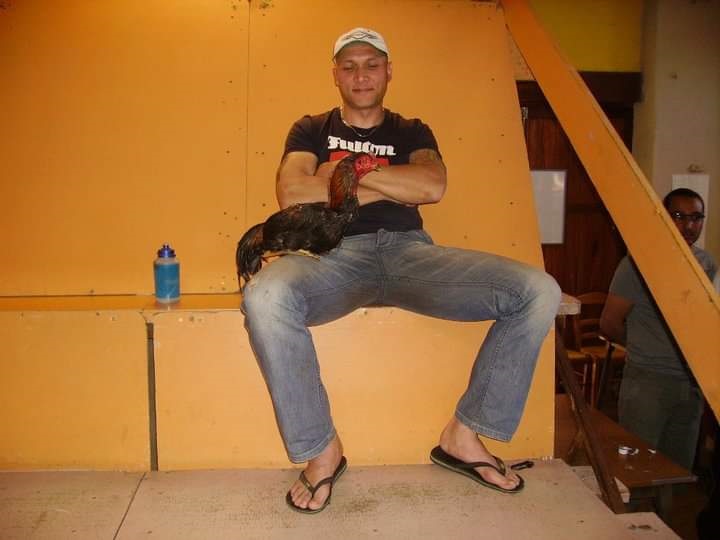
Toghether in the pit, just before the contest.

An other old picture of my daughters.
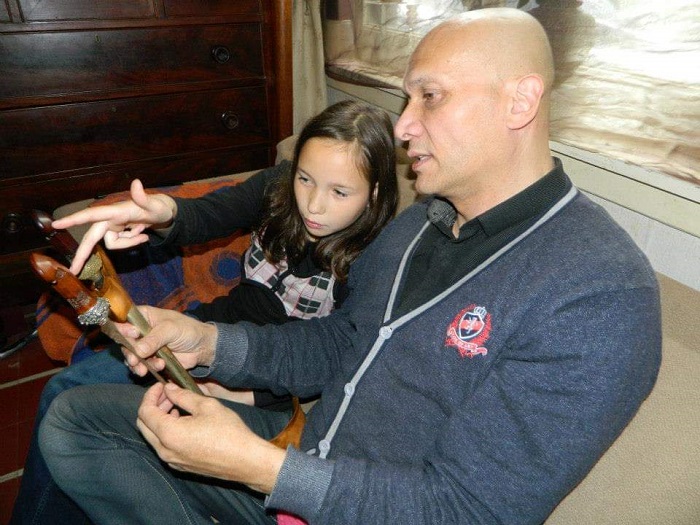
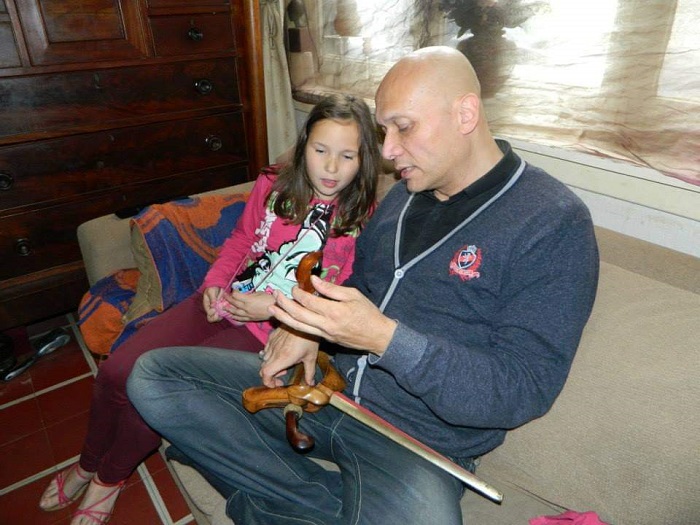

In this apartment in the center of the city, i had less space, so i had my Mandir in a niche facing the west. You should always face the east, the place were the sun comes up, creating new chances. But sometimes you have to deal with reality. 2015 2017.
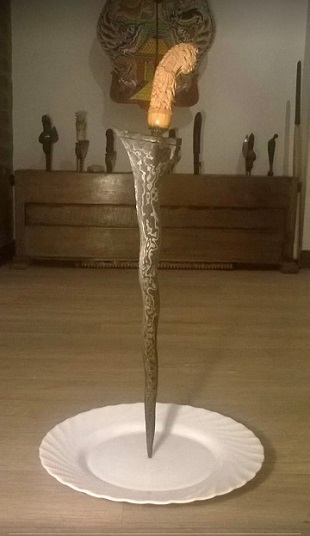

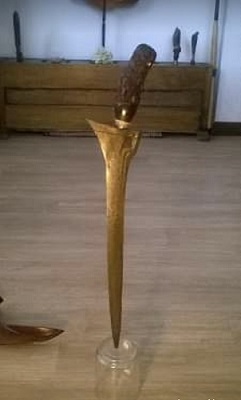 Berdiri, the art of balancing.
Berdiri, the art of balancing.
This was a nice house, in the middle of a forest in a wooden chalet from 2017 until 2019
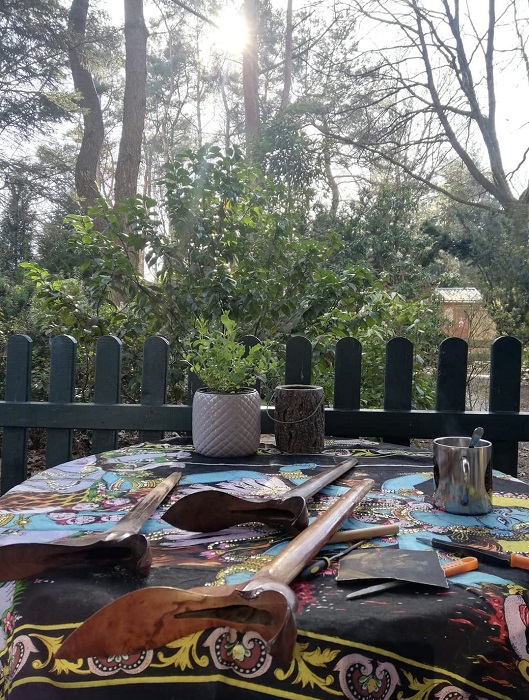
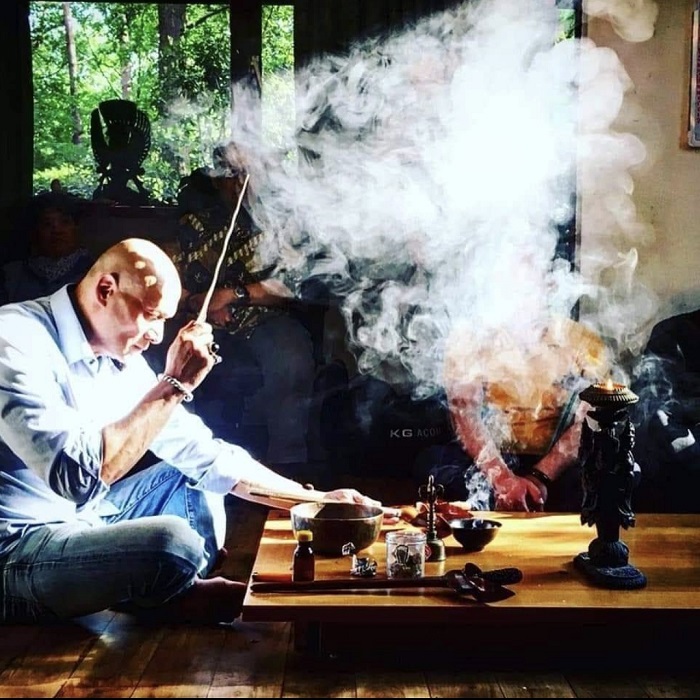
Lots of kumpulan there in Diessen.

2019 i lived in an old police office, in the center of Tilburg.
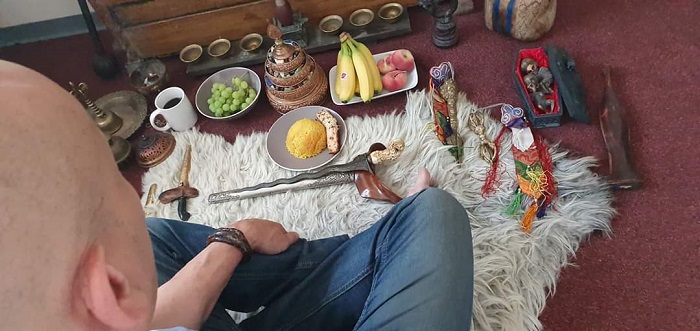
Old picture of Jumat Kliwon.

This was my biggest Mandir, i lived in a big garage here with lots of space in Oss. I even held a big keris event there in my own house.
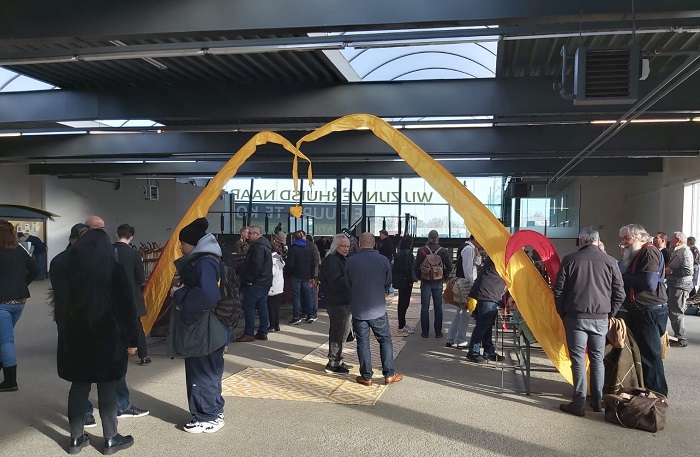
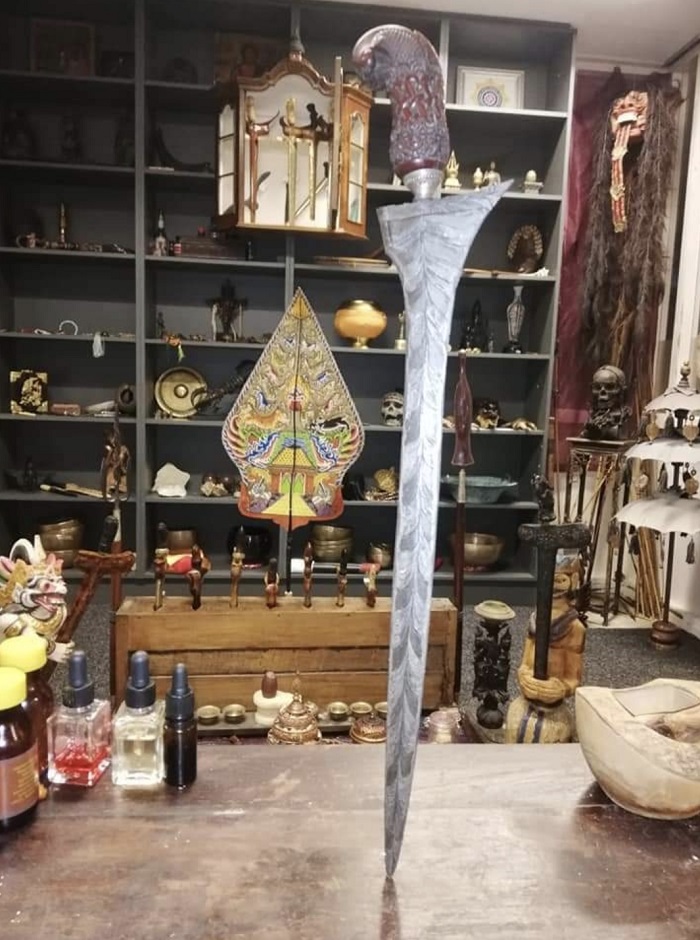
My most important keris pusaka.
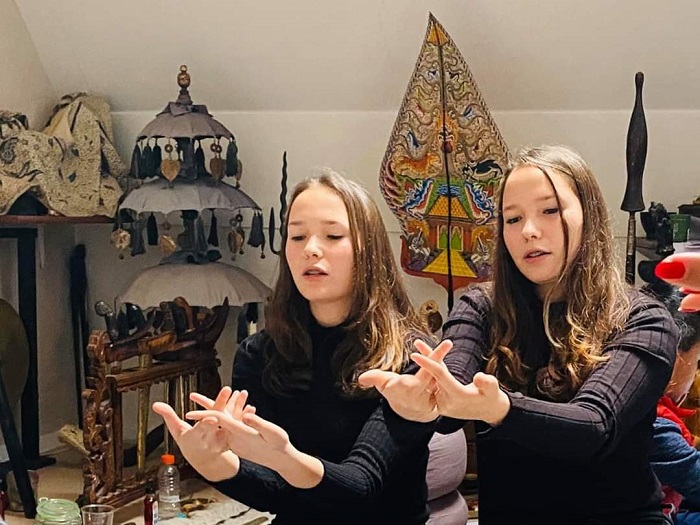
My daughters doing the Mandala mudra, the lingam in 2020

This was a very nice place to live in Nijmegen in a big building. I lived there during the Corona lock downs, but this is were my work with the keris really came to a climax.
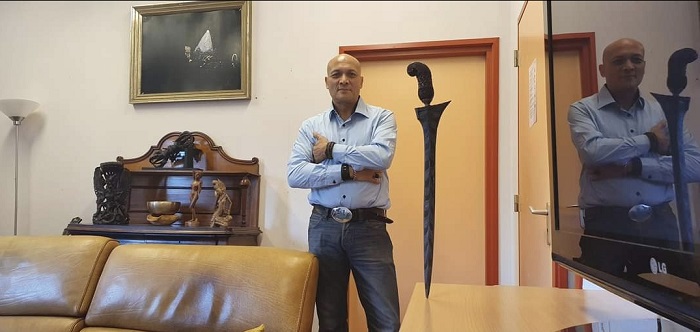
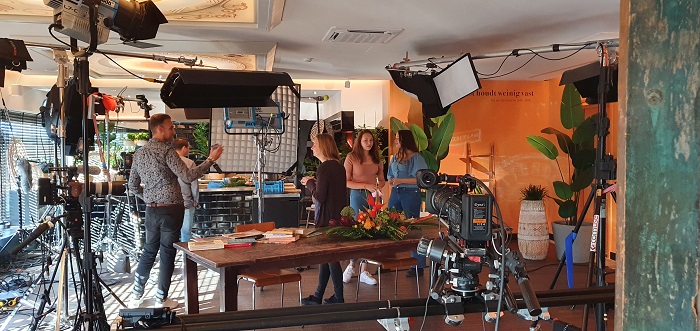
My daughters Yanou and Marceline being interviewed about their relationship with the keris during the national Indonesia memorial. Even now after already 3 generations, Indonesia is still in their harts.

There is a time to grow, a time to bloom and a time to harvest. Now it is time to harvest. Spending more time with my family, my private life, my keris. My Mandir from 2021 until 2022

This i my Mandir from november 2022.
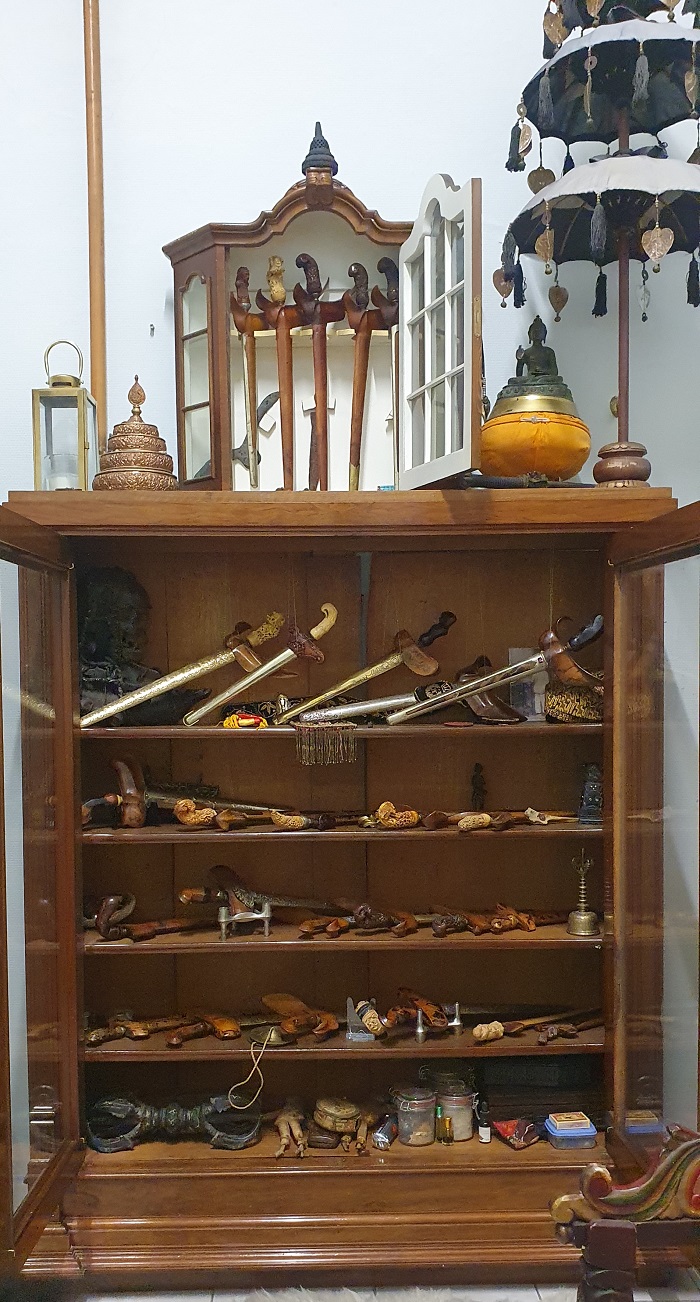
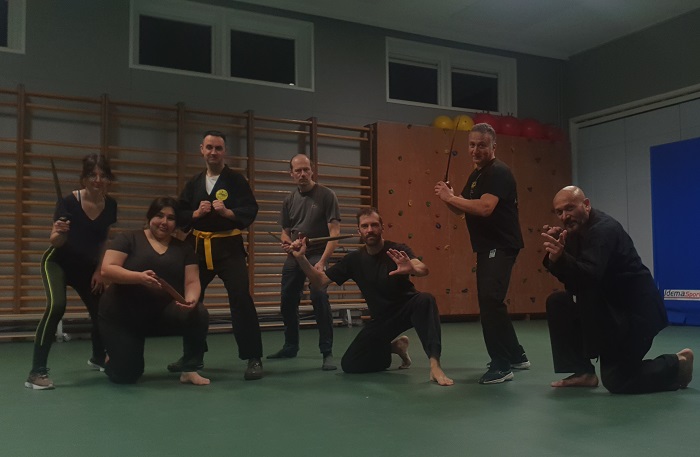
Of course training in martial arts is an important part in my life, harimau bongkot pencak silat. So thankfull that it is still possible.
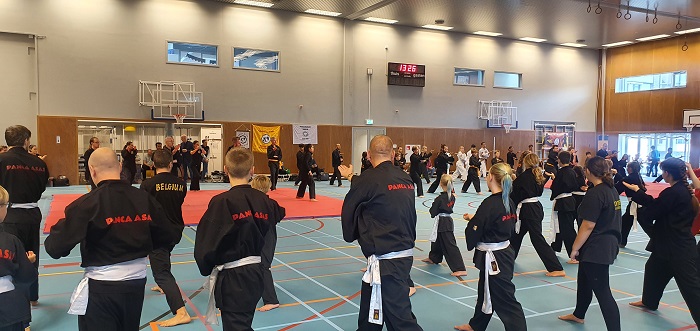
Pencak Silat festival in Amersfoort.
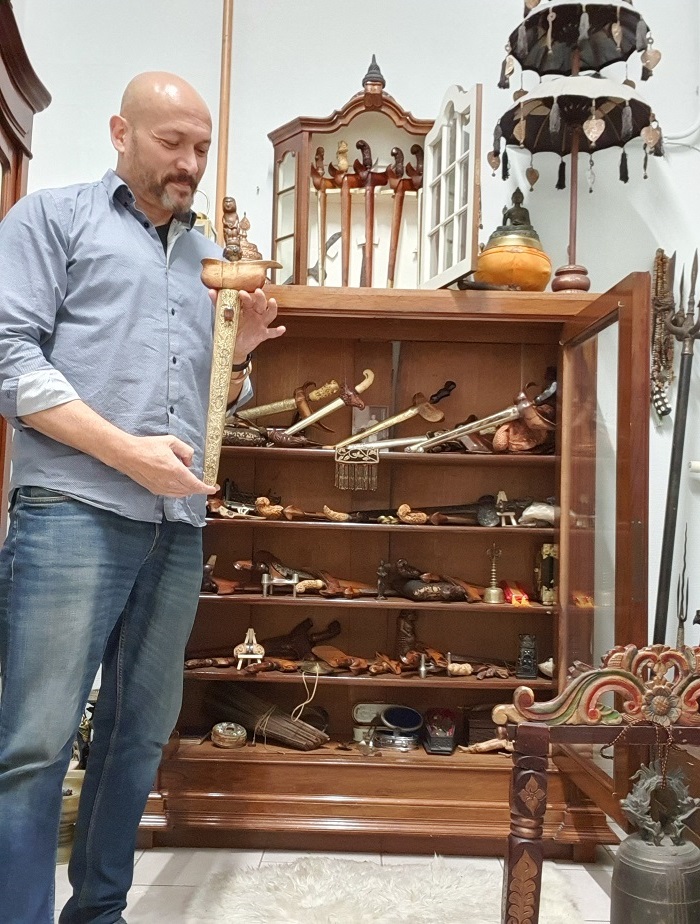
There are 3 types of keris:
Keris Ageman, the costume keris, beautifull made with a great dapur and clear pamor. These keris are realy pieces of art. Because they are worn with a costume, they have all the signs of the corrct era, place than belongs to the costume. Allmost all books are writen about the Ageman keris. These are also the keris that collectors want,and are given as gift. The keris are made from iron and nickle to show a great pamor pathern. These keris are usualy made without an energy.
.png)
Nice article were is clear that even before Gronemann keris could be bought in the Keraton, they speak about 5000 guilders here. Beautiful handcrafted keris were specialy made as gift to important people, and Empu's were even stimulated to make replika's from old famouse keris. These keris were not made with an energy. You still find these keris, you can see that they were never worn, and they look like going back in time for 100dreds of years.
Keris Tayuhan, the holy keris. These keris are very rare! These keris are made from holy metal, and not from contrasting metal. They are made layered, have a mostly straight blade, and because of the holy iron, and not iron and nickle, no clear pamor! These keris have an energy, needs a lot of attention to keep the energy alive, and no, they don't sleep when they are neglected, that is a story sellers tell you.... There is not much writen about these keris, and knowledge about these keris are handed over verbaly from parent to child. These keris must be called by there specific name! And need to be energeticaly loaded by sajen.
These keris have a simple dress, are mostly hidden in a high place above the heads of people because people can get ill, and have a simple but very well made blade with no clear pamor.
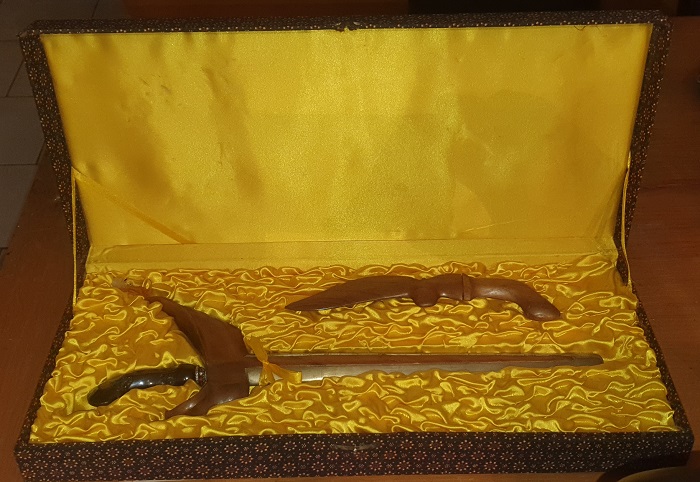
A real keris pusaka with an Isi ior Tuah s traditionaly stored in a closed box and kept on the highes place in the house, far above the heads of the people because people can get ill. This is only needed for a Tayuhan keris, an Ageman keris can be stored in a keris stand or nice on the wall.
What you usually see in Europe is that people approach the keris as an Ageman keris, without dividing the keris into the right group. Something that does happen in Indonesia. Danger is then that a very good keris, perfectly made for it's purpose, will be misjudged by not following this sub devision. I even know about very respected collectors, who have a great Tayuhan keris in a beautiful dress, who took the blade out and changed it to a beautifull made Ageman keris....ignorance!
I love keris!
The Netherlands is definitely the second largest keris country in the world.
Where does the interest in the keris of the Dutch come from? Lots of Dutch married Indonesians and lots of keris came in their family like this. At this moment there are around 1.000.000 Indo's in the Netherlands, people who's origine lays in Indonesia. Many Dutch people also had good functions in Indonesia, in the military or in the goverment, and so received very beautiful kerises donated by princes and kings, as thanks and friendship.
Around 1900 it was Isaac Gronemann who put a lot of work into preserving Empu's craft, sponsoring Empu's and trying to promote the keris as an art object among his acquaintances.
Where does the interest in the keris of the Dutch come from? Lots of Dutch married Indonesians and lots of keris came in their family like this. At this moment there are around 1.000.000 Indo's in the Netherlands, people who's origine lays in Indonesia. Many Dutch people also had good functions in Indonesia, in the military or in the goverment, and so received very beautiful kerises donated by princes and kings, as thanks and friendship.
Around 1900 it was Isaac Gronemann who put a lot of work into preserving Empu's craft, sponsoring Empu's and trying to promote the keris as an art object among his acquaintances.
At that time only pusaka kerises were made for the Priayi and most of the Empus worked as blacksmiths, in order to be able to earn money. The keris was not popular then and they got out of job
because nobody ordered keris anny more.
When World War II started, the political situation ended the open worship of the keris. The Japanese were also afraid of the keris, which often helped my family, and many valuable keris were
hidden, such as Knaud's keris. The Knaud keris is an intereesting old keris given by Paku Alaman when dokter and dukun Mr Knaud healed his son.
In the period 1940 until 1950, many Indos fled to the Netherlands, they naturally took their valuable kerisses with them. In the period 1945 to 1950, kerises were also confiscated by Dutch
soldiers, and they could buy a keris for 25 guilders, after which the money went into the group cashier.
In the period 1950 to 1998 many people with kerises were prosecuted, and again many people left to the Netherlands with their kerises. The period Suharto and Sukarno is known as a violent
period with more than 1,000,000 dead in only 1964 alone. These too were often people who owned kerises, those kerises were also sent a lot to the Netherlands for safety reasons.
My family also only left for the Netherlands after 1950.
When the book "The world of the Javanese keris" was written in the 1970s, there weren't even more Empus to be found. For a fee, Empu Yosopangarso and Djeno forged a keris, the craft of Empu had
almost disappeared because there were no more orders to forge keris.
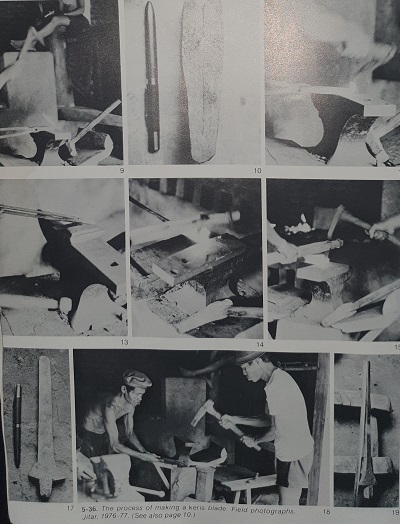 Pictrures shot 1976
Pictrures shot 1976
 Pictrures shot 1976
Pictrures shot 1976
The German Dieter Drescher has also been important in bringing Empu's craft back to the attention. And now after 2000 the keris in Indonesia and the Netherlands is again in the spotlight and in
Indonesia there are again Empus who traditionally forge keris. Unfortunately, there are also blacksmiths who, due to the situation that arose, copy and sell many kerises as old ...
In the Netherlands live about 2,000,000 people with their roots in Indonesia, and although the integration in the Netherlands was not really easy, we were allowed to keep kerises and we were
not prosecuted like our family members in Indonesia.
Right now the keris is very popular in the Netherlands. There are the collectors, the most active group. You have got the Pencak Silat group who use the keris as a weapon. And there are the people who have the pusaka heirlooms who keep their keris, and not only the keris as an art form but also the esoteric part of the keris.
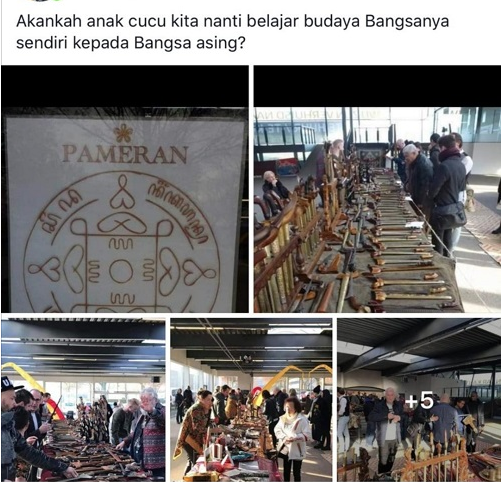
Pictures of the Pameran keris pusaka Belanda.
Right now the keris is very popular in the Netherlands. There are the collectors, the most active group. You have got the Pencak Silat group who use the keris as a weapon. And there are the people who have the pusaka heirlooms who keep their keris, and not only the keris as an art form but also the esoteric part of the keris.
Pictures of the Pameran keris pusaka Belanda.
Unfortunatly there are some people in Indonesia who destroy the keris, see the keris and the keepers as stupid and the energy from the keris as haram. But there is now a bigger group who wants to
preserve the keris and the traditions of the keris. And since 2017 finaly Kejawen is accepted as officila religion in Indonesia and people are alowed to put Kejawen in their pasport as official
religion. Before 2017 they mostly called them selves Moslim because they were not insured en almost put outside the society...
And NO, most keris in the Netherlands are NOT stolen, the Dutch goverment has some confiscated keris who should go back to the rightfull owner. Most keris in the Netherlands are brought here as heirlooms, comming from their own familie or gotten as gifts. Stil there are lots of keris, all from the periode before 1940, we don't have keris smith here..
And NO, most keris in the Netherlands are NOT stolen, the Dutch goverment has some confiscated keris who should go back to the rightfull owner. Most keris in the Netherlands are brought here as heirlooms, comming from their own familie or gotten as gifts. Stil there are lots of keris, all from the periode before 1940, we don't have keris smith here..
When i was very young my grand mother Anny Deelken always told me beautiful stories about that beautiful and mistik country Indonesia.
2.jpg)
Me and my grandmother Annie, she also took care of the family keris Kiayi Slamet during WW2.
2.jpg)
Me and my grandmother Annie, she also took care of the family keris Kiayi Slamet during WW2.
She also told me the stories about my grand grand mother who was an Indonesian prinses raden adjeng Augustine Setjodiredjo.
"When you grow up, you are going to get a keris" she told me...
I worked in the antique buisiness for many many years, and specialised in restoring antique and determinating old real antique versus fake old made antique. I always had a keris in my house. But i'm not a collector like most lovers of the keris.
With every object you always have different interest parties. Let's take a car. There is the main group, the people who just buy a car and use it to drive daily. Then you have the sporters, who use the car for rallies. And there are the collectors of the car.
With the keris it's just the same. The biggest group are the users of the keris. Then you have the sporters who use the keris as a weapon, en there are the collectors of the keris. Three different groups with different uses of the keris.
I noticed that it is very difficult for someone to think out of their box. If you collect it is very difficult to understand that there is more then collecting keris...
A collector would prefer an old car with only 10,000 km on the odometer, knows everything about the year of manufacture, equipment manufacturer, etc. I am a "car driver". With me, it should be easy to use and work when I ask. So it is with the keris, I am only interested in the pusakas with energy, and follow the traditions, which most collectors do not do either.
Most of my friends they read almost every book about the keris and their Tangguh, dapur, pamor. I cannot force me to read these books. But give me a book about spirituality, ed Veda's, Kejawen etc. i cannot stop reading and probably loose my sleep!!!
I meditate with the keris, keep all official days like Jumat Kliwon and Tumpek Landep and sacrifice for the kerises. Most collectors can tell you every historical detail of the keris, the kerises look flawless to most and have are more beeing displayed as preserved. I store them so that the energy is preserved ....
I worked in the antique buisiness for many many years, and specialised in restoring antique and determinating old real antique versus fake old made antique. I always had a keris in my house. But i'm not a collector like most lovers of the keris.
With every object you always have different interest parties. Let's take a car. There is the main group, the people who just buy a car and use it to drive daily. Then you have the sporters, who use the car for rallies. And there are the collectors of the car.
With the keris it's just the same. The biggest group are the users of the keris. Then you have the sporters who use the keris as a weapon, en there are the collectors of the keris. Three different groups with different uses of the keris.
I noticed that it is very difficult for someone to think out of their box. If you collect it is very difficult to understand that there is more then collecting keris...
A collector would prefer an old car with only 10,000 km on the odometer, knows everything about the year of manufacture, equipment manufacturer, etc. I am a "car driver". With me, it should be easy to use and work when I ask. So it is with the keris, I am only interested in the pusakas with energy, and follow the traditions, which most collectors do not do either.
Most of my friends they read almost every book about the keris and their Tangguh, dapur, pamor. I cannot force me to read these books. But give me a book about spirituality, ed Veda's, Kejawen etc. i cannot stop reading and probably loose my sleep!!!
I meditate with the keris, keep all official days like Jumat Kliwon and Tumpek Landep and sacrifice for the kerises. Most collectors can tell you every historical detail of the keris, the kerises look flawless to most and have are more beeing displayed as preserved. I store them so that the energy is preserved ....
MY HERTITAGE
My Grand grand mother, 4 generations back, was Raden Ayu Siti Soetari. Siti means doughter of the Sultan of Jogjakarta, sultan HB 7.
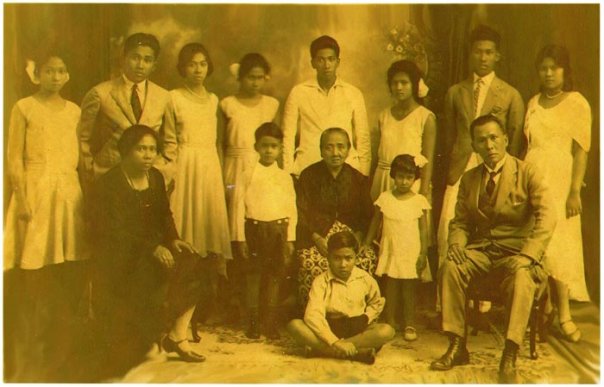
Old family picture with in the middle Raden Ajoe Siti Soetari and on the left Raden Ajeng Augustine Setjodiredjo.
My grandfather 4 generations back was Raden Mas Setjodiredjo, Doktor Jawa and Wedono from Prajekant, Situbondo, one of the prinses of Besuki. The Radens from Situbondo came from the keraton of
Sumenep
Blambangan was the only part of Java that stayed Hindu and was never concered by Mataram. It were the Dutch who conviscated Blambangan, and after some revolt they gave the east of Java under
control of Sumenep.
My grand grand grand father was Doktor Jawa Raden Mas Setjo di Redjo, Wedono and Javanese dokter from east Java, Panarukan, Wedono from Prajekan.


My grand grand father with his typical Madurese headdress Krentong Rekerek.
During World War 2 my grandparents were send to a Japanese concentration camp,and all Priayi from east Java, Panarukan, were killed by the Japanese army.
Japanese executed the entire Priyaji of Basuki in 1945, which marked the end of the Dynasty ...
Via the magazine De Vrije Pers, the Investigation Service for the Dead (O.D.O.) reported on September 1, 1949:
Panaroekan, 1949.
“The mass arrest of these Priaji’s at the time aroused great turmoil and is still a much debated topic in Priaji circles today. (Javanese nobility - JP) Only recently, the Investigation Service
of the Deceased succeeded in bringing some clarity to this controversial affair.
The investigations showed that the Indonesian government officials were first deported to Banjoewangi. After being interrogated by the Kenpeitai for a few months, they were quietly transported to
Surabaya at the beginning of November 1944, where they were locked up in the Werfstraat prison. On November 28 and 29, 1944, the Japanese Court of Justice pronounced the death sentence on these
officials. In the early morning hours on December 3, 1944, they were put into trucks leaving the prison of unknown destination.
By a sharp questioning of the Japanese war criminals detained in the Tjipinang prison in Batavia, it has now been established that Bodjonegoro was the final destination of the trucks. In the dark
djati forests around Bodjonogoro on December 3, 1944, at dawn, the firing squad of the infamous Ohara unit sounded. These shots ended the lives of these Indonesian government officials. On the
spot they were buried in a mass grave. The names of those executed were obtained from an eyewitness who was locked up as a prisoner in the Werfstraat prison at the time of the removal of the
administrative officials.
On 3 december 1944, the Japanese Ohara corps killed all nobility from Panarukan in the forrest of Bodjonogoro.
In remembrance:
In remembrance:
Bagoes Bambang Soetopo Soedibio Koesoemo, Regent from Panaroekan;
Abdoelkadir Sosro Amidjojo, Wedono from Panaroekan;
R. Soedarsono, Wedono-kotta Sitoebondo;
R. Ismangoen Danoesoebroto alias Soerjadi, wedono from Asembagoes;
Mohamad Saleh Hardjowidjojo, Wedono from Wonosari;
R. Ngabei Mohamad Joesoef Joedodihardjo, Assistent-Wedono from Tegalampel;
Soekirno Hadiwinoto, Assistent-Wedono van Asembagoes;
R. Madiroso Koesoemowidjoio. Assistent-Wedono from Kendit;
Kjai Abdoelgani Singoatmodjo, Assistent-Wedono from Sitoebondo;
Baharoedin Soemodiredjo, Assistent-Wedono from Panaroekan;
R. Soepradi Soeriokoesoemo, Assistent-Wedono from Djangkar;
Djojosoetikno, Assistent-Wedono from Kapongan;
Moestopo Patmodiredjo, Assistent-Wedono from Banjoepoetih;
Mohamad Imam Soerowidjojo, Assistent-Wedono from Ardjasa;
Dasri, Assistent-Wedono van Besoeki;
M. Endin Soemodipoetro, Assistent-Wedono van Soebah;
R. Soepangat Prawiro Hadiwinoto, Assistent-Wedono van Pandji;
Tajidin Soemosoebroto, gepensioneerd Assistent-Wedono from Tjoerahdami;
Tajipi, gepensioneerd Wedono from Tangbatang (Madoera);
R. Soetjipto Martokoesoemo, Commies-Redacteur of the Secretarie from Regentschapsraad van Panarukan;
R. Soedarsono. Ambtenaar P.T.T. te Sitoebondo;
Sainoedin alias Sosrosoeseno. Writer of the Djaksa-office te Sitoebondo;
R. Mohamad Zainal alias Kromosastro, Mantri-goeroe, desa Treboengan te Sitoebondo;
Abdoel Madjid, Lightwaiter te Panaroekan,
Mas Santrijo Djojoatmoko. Hoofdoppasser of the Regent of Panarukan;
Ponidjan, Managerof thet Hotel te Sitoebondo;
Tajidi, Mantri Passerwezen te Sitoebondo;
Arnawi alias P. Soetri alias Reksokario, Desaheadof Pasirputih;
Go Kiem Ho, Wijkmeester te Sitoebondo; en
Kyan Chin Kei.
The Ohara corp also murdered:
Saheroen Soemodiredjo, Assistent-Wedono van Mlandingan, killed in captivity te Mlandingan (Besoeki);
Ang Tjwan Khing, Handelaar te Panaroekan, geexcecuted te Antjol;
Kariowisastro alias Hanapi, Desahoofd te Mimbaän, killed in captivity te Banjoewangi,
Endin, Spoorwegarbeider te Diember, killed in captivity te Banjoewangi;
Pak Saemi, Waker van de Regentschapspasanggrahan te Pasirpoetih, killed in captivity te Banjoewangi;
Sech Saleh bin Salin, Procureurbeambte (?-JP) te Sitoebondo, killed in captivity te Banjoewangi;
Imamoedin, son of Hoofdpengoeloe te Sitoebondo, killed in captivity te Banjoewangi.
What do we know about the resistance of Sudibiokoesoemo and his followers? Nothing, except that the O.D.O. assumed that there had been actual resistance, and that Soedibiokoesoemo was in the
lead.
Incidentally, it need not have meant much. The Japanese were aware of the growing dissatisfaction among the Javanese population about the economic decline and the lack of commitments to
independence. Sporadic reports of Allied victories in the Pacific made them particularly suspicious. There were fears that the Allies would land on the coast of East Java. Everything that seemed
suspicious was examined to the bone.
Panaroukan, t.t.v. Operation Product, July 1947.
The Panaroekan affair must be placed in a long line of mass arrests in East Java from the end of 1943.
In December 1943, 71 Moluccans in Surabaya were suspected of firing flares to attract the attention of Allied aircraft. All but one were executed in mid-1944.
In May 1944, shortly after an Allied bombing raid on Surabaya, about fifty Moluccans were again arrested, suspected of signaling. Also arrested this month was M. Basoeki Poerwowidjojo, assistant
wedono of Mangli (Djember regency), along with Pa Soedarmo, Adjoeng's head, and P. Sarkam, head of Adjoeng's kampong police. Basoeki was accused, among other things, of having lit fires in the
shapes of a "V" (Victory) and a "W" (Wilhelmina) on one of the dark evenings. On December 15, 1944, he was sent by the Kenpeitai from Djember to Batavia to appear before the Council of War. In
January 1945 he was executed in Antjol.
In November 1944 ex-Dampit boys were arrested, as well as two NEFIS agents who landed near Panaroekan.
The PETA arrests in Blitar took place in January 1945. Also in the first half of 1945 there was a raid among the Indonesian officials of the Besuki residence. These officials were also accused of
undermining authority. The first victim of Kenpeitai arbitrariness fell to the Regent of Bondowoso, R. Mohammad Safioedin, also named Atmosoedirdjo, who immediately after his arrest was so
mistreated that he died during questioning.
The fate of this group became known to us because in 1948, while one of the cases against members of the Kempeitai headquarters was being handled, a driver stated that he was aware of mass
executions in Bodjonegoro. When Japanese residing in the Tjipinang prison in Batavia were once again put to the test, it turned out that in February 1944 a group of 62 people from Madura had been
executed in Bodjonegoro, in mid-1944 the group of Moluccans from the rocket affair from Surabaya, and therefore , in December 1944, 30 persons from Panaroekan and surroundings.
Lots of lineage from the priyayi from east Java left Indonesia and fled to the Netherlands, taking their most pressiouse possessions with them.
My family lost the valuable pusaka's during that time, but my grand mother told me the legend of the keris: "a keris always looks for his family to come back to...".
When growing older, my father got a keris from uncle Piet, and when my father past away i got the keris what changed my life completely.
When searching for the family heirloom i met very much descendants of the east Javanese priyayi, and some of the kerisses were donated to musea, some still kept and taken care for as pusaka, and
some donated the keris to me, because they wanted their keris beeing fed and honoured as presiouse family heirlooms, just to keep the tradition alive.
https://javapost.nl/2013/12/11/de-onwrikbare-trouw-van-soedibiokoesoemo
ATTENTION, i am looking for old Wedono keris from east Java, belonging to the Priayi of east Java. I like to get all family keris back in the family since most of the Priayi beeing killed in 3 december 1944.
https://javapost.nl/2013/12/11/de-onwrikbare-trouw-van-soedibiokoesoemo
ATTENTION, i am looking for old Wedono keris from east Java, belonging to the Priayi of east Java. I like to get all family keris back in the family since most of the Priayi beeing killed in 3 december 1944.
I am so proud to take care of those beautiful heirlooms of east Java, in memory of my Indonesian origin...
My keris and pusaka keris
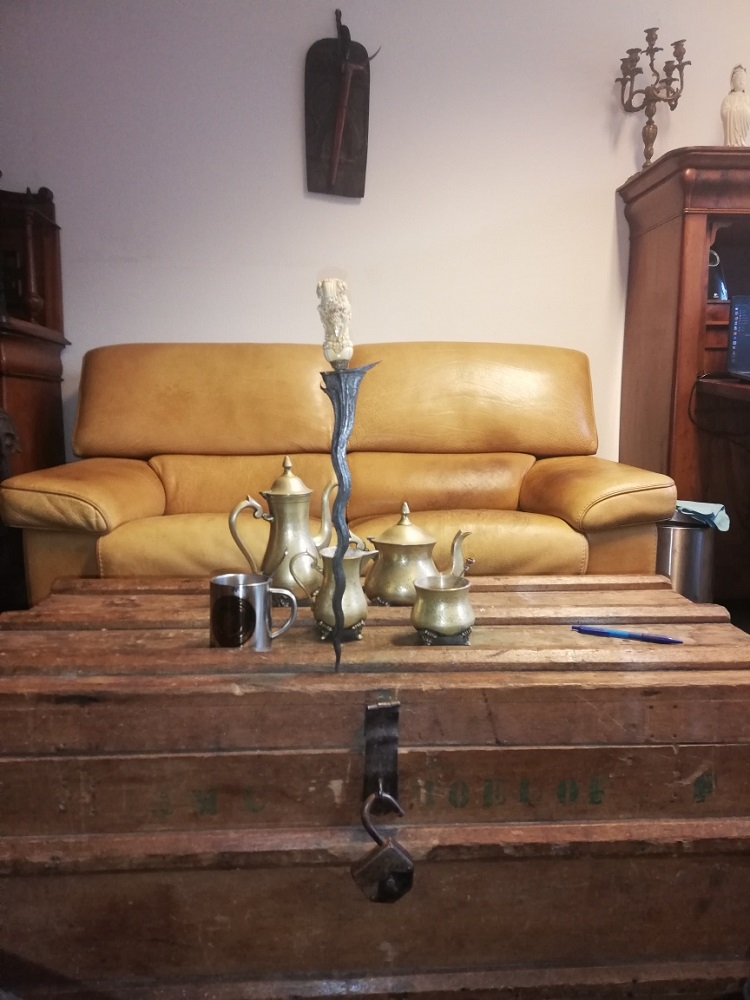
My most important keris, the keris from my father.
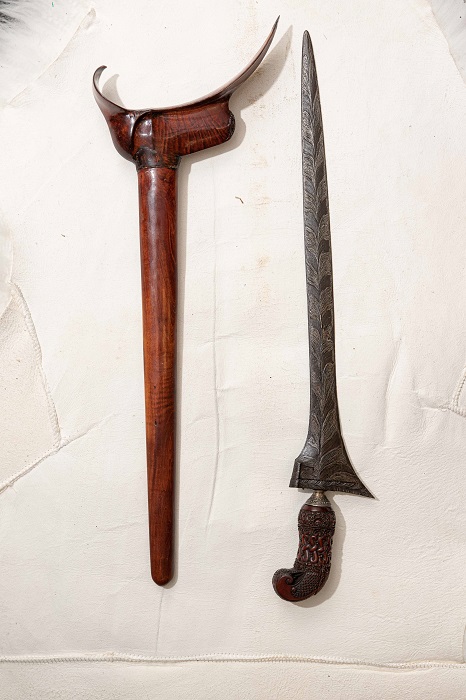
Keris name: Kiayi Senang Hati, the keris from my father..
Pamor: Ron Genduru, Bulu Ayam Wengkon.
Dapur: Tilam Upih
Tanguh: Blambangan 18th century
Hilt: Kembang Temu
Mendak: Angkup Randuh type silver carved
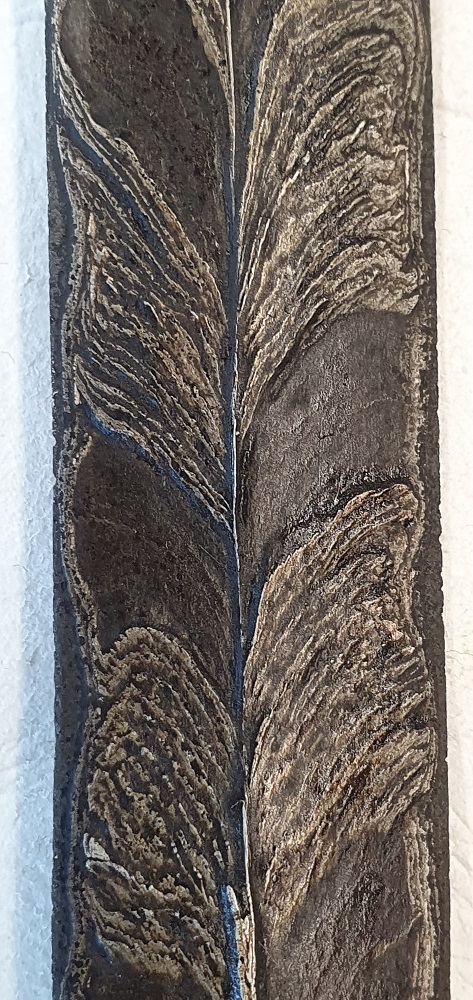
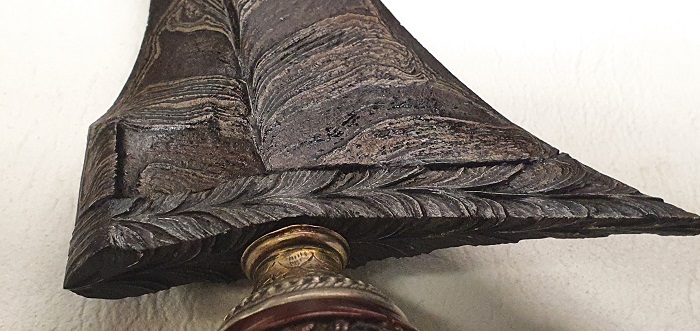
Keris east Java, pusaka heirloom, for protection. Rojogondolo. The spirit of this keris visits you in your sleep and gives you messages from above...
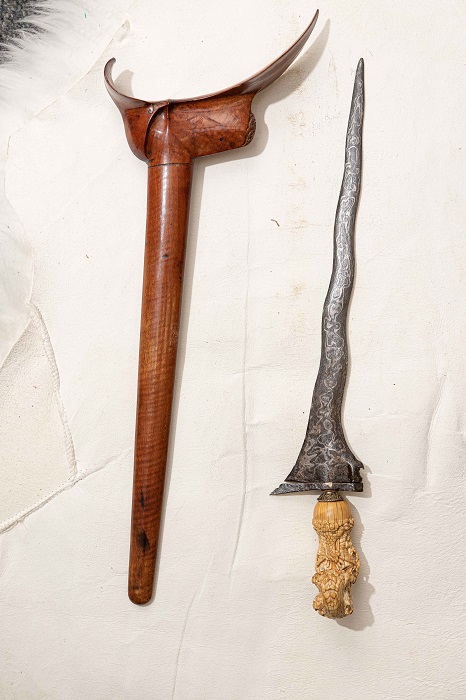
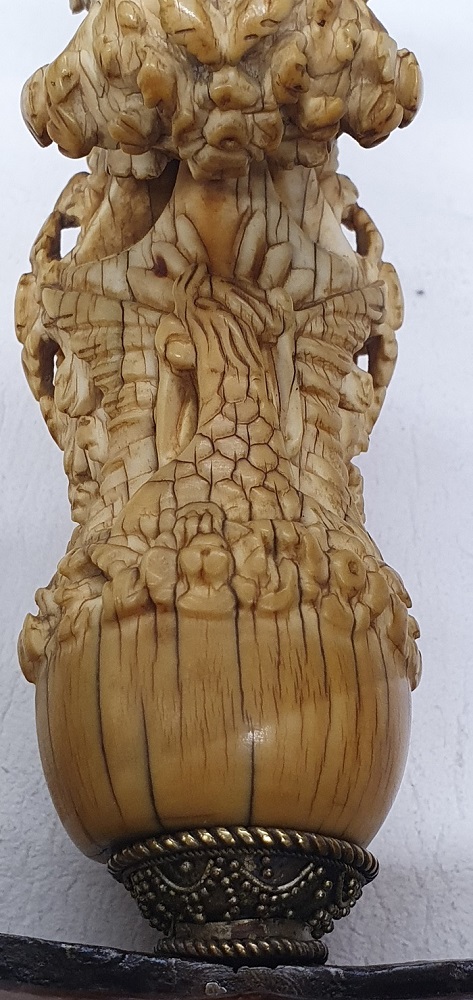
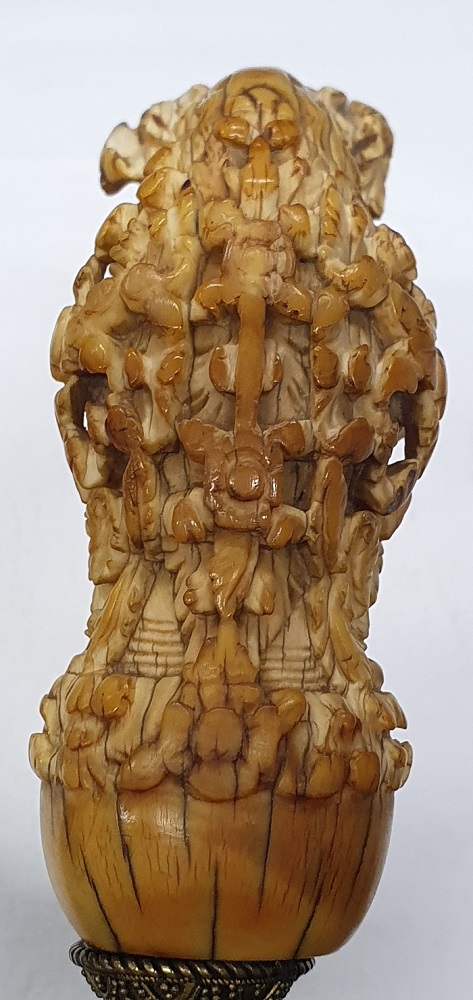
Keris east Java, pusaka heirloom, to ward off unwanted events, against negativity, ghosts, dangerouse animals. This keris gives you spiritual power. The spirit of this keris travels. Very active keris.
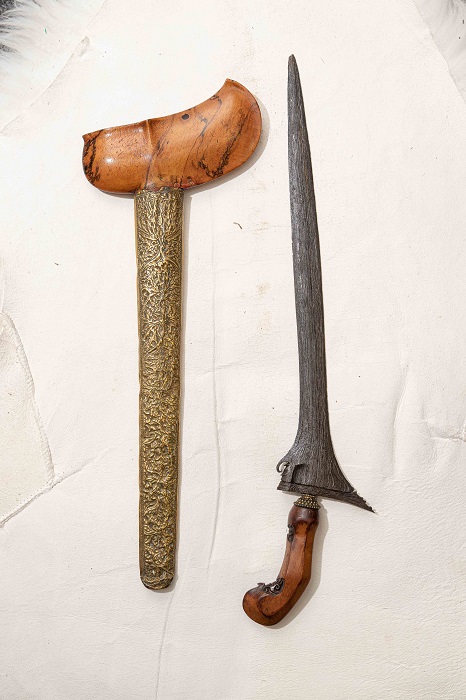
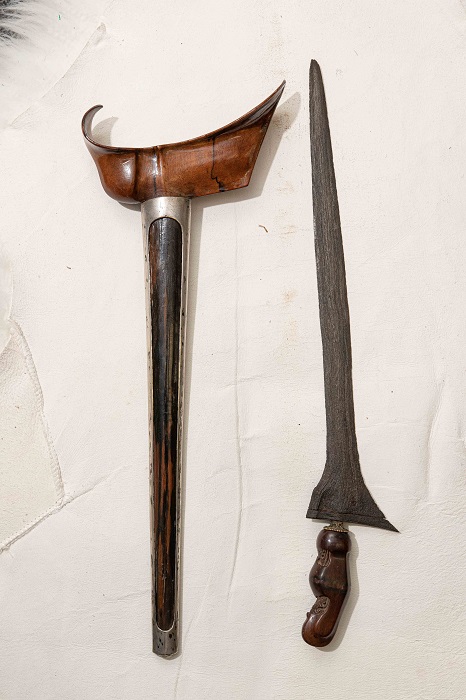
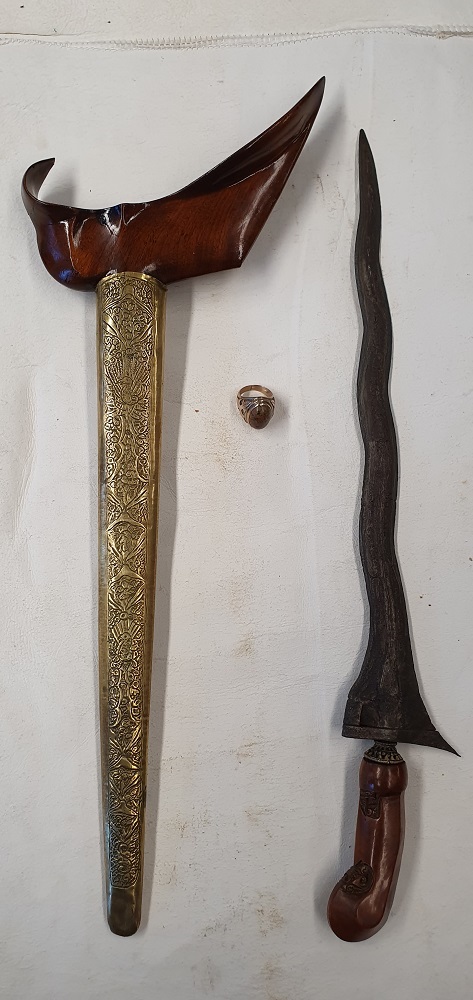
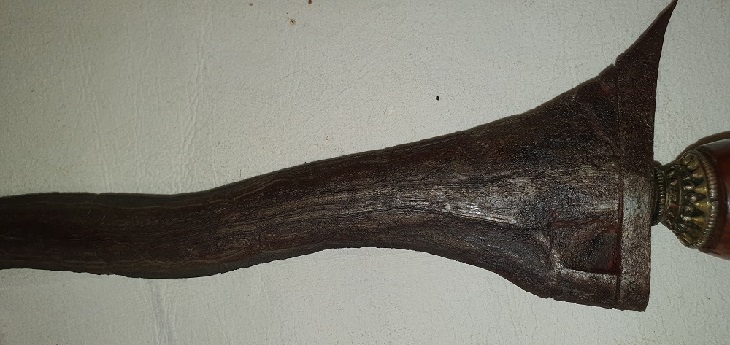
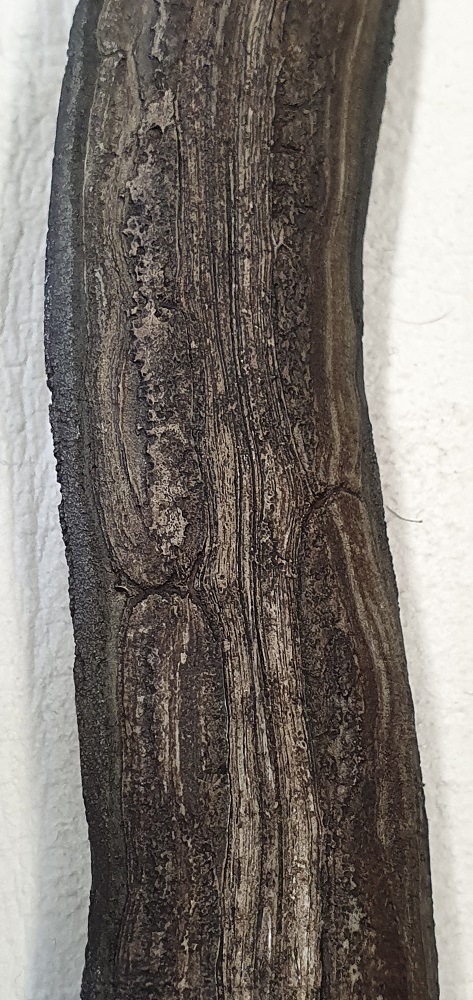
Keris east Java, pusaka heirloom, High keris, 13 luk, nobility, good leadership, good relations with every one.
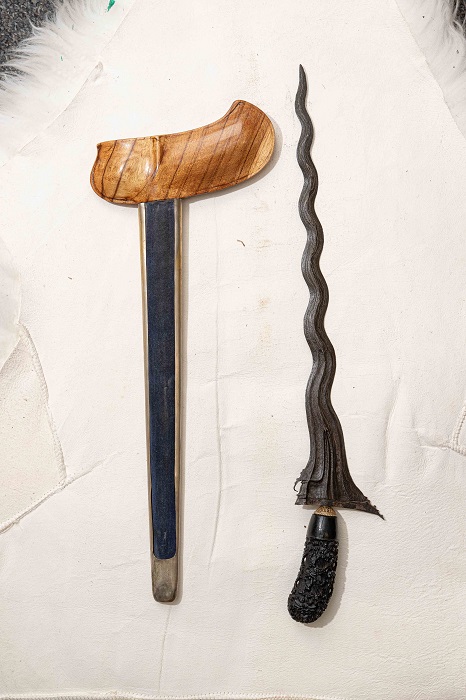
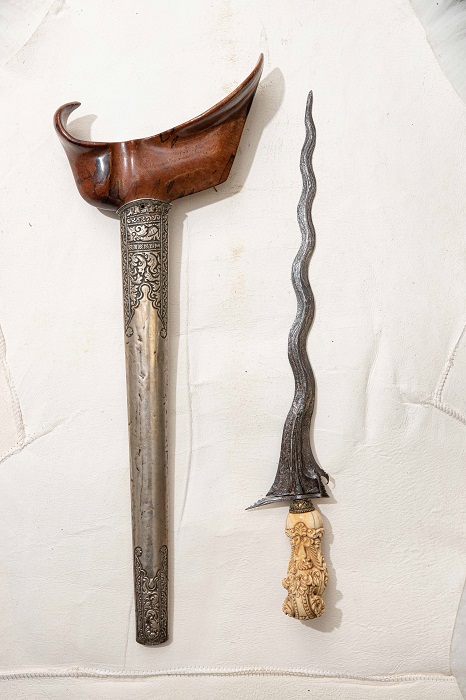
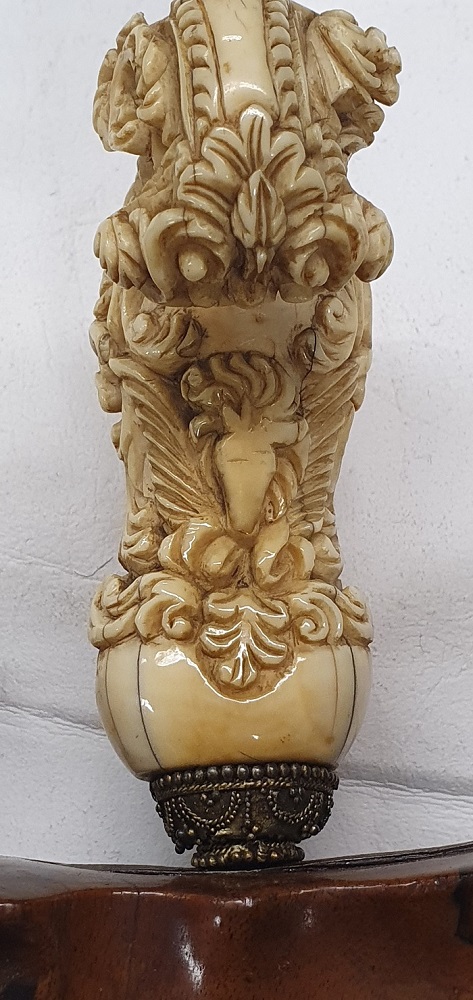

Keris east Java, spiritual keris, Ratu Kidul, the queen of all the spirits.
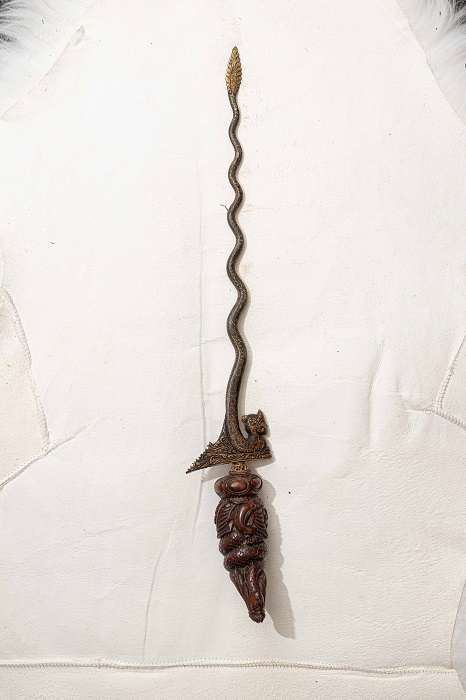
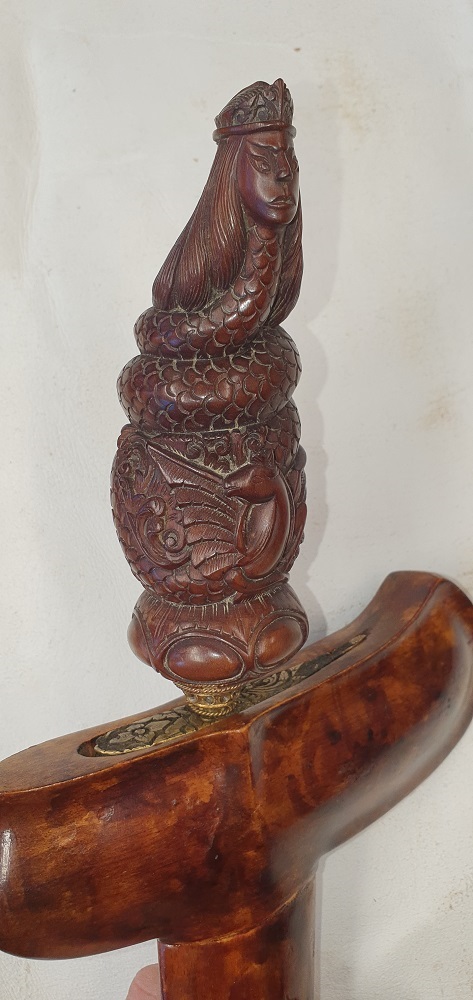
Keris Yogjakarta, pusaka heirloom. High Keraton keris, from an army officer. Very active spiritual keris.
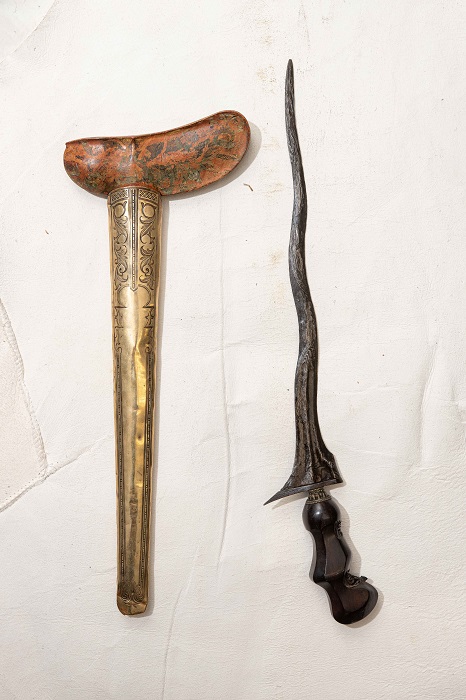
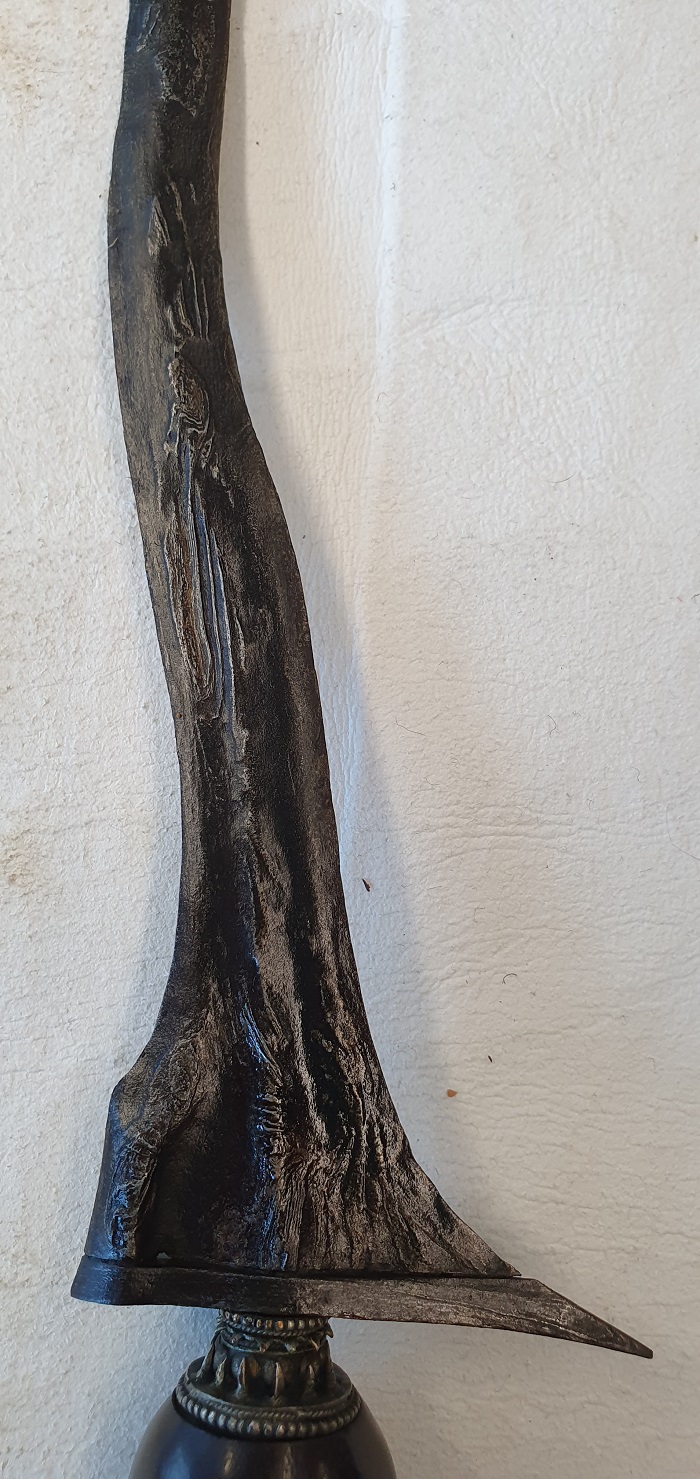
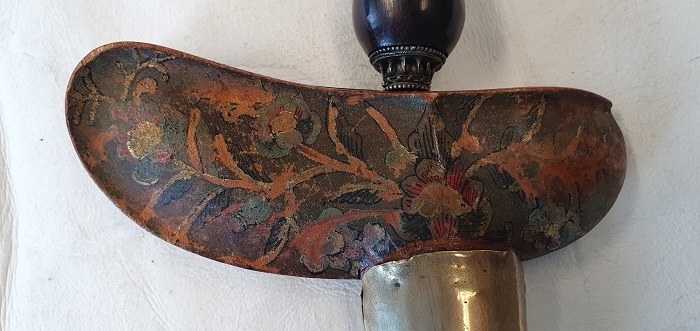
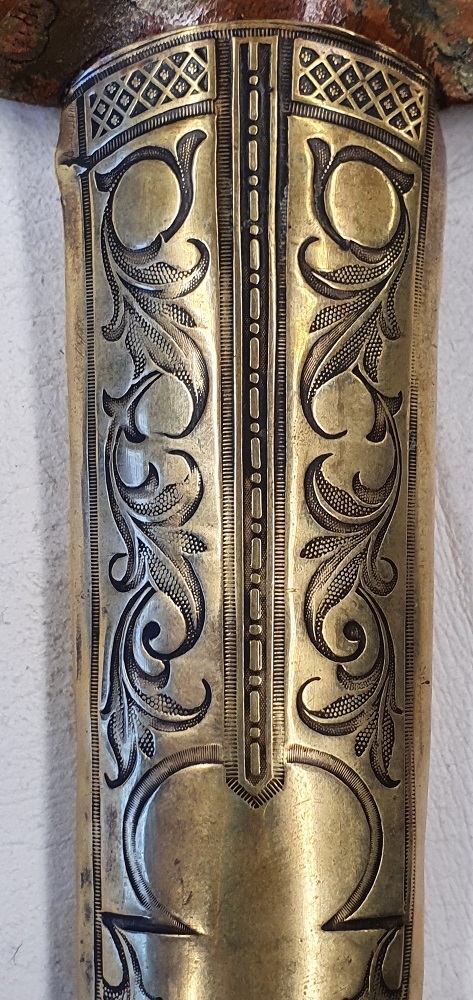
Keris Solo, pusaka heirloom. old spiritual keris for meditation and as oracle.

Keris name: Kiayi Jansen
Pamor: Nggajih
Dhapur: Sempana 7 luk
Tangguh: Pajajaran 12th century
Hilt Surakarta style Yudowinatan type with mendak and selut

Keris Yogjakarta, Pandawa Lima, the Pandawa brothers from the Mahabarata.
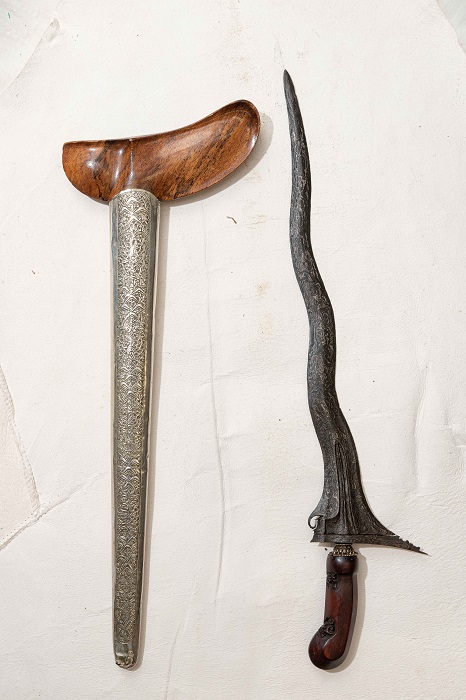
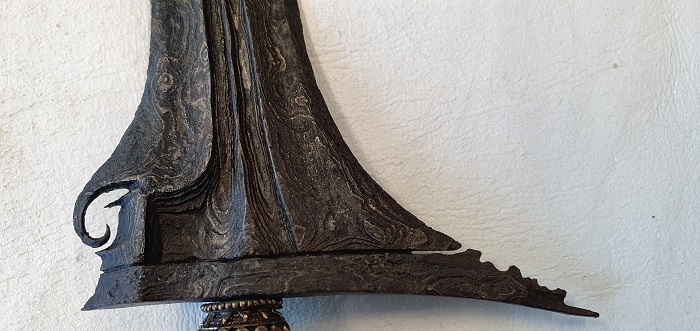
Keris east Java. pusaka heirloom. Absorbs negative energy. Mistical keris.
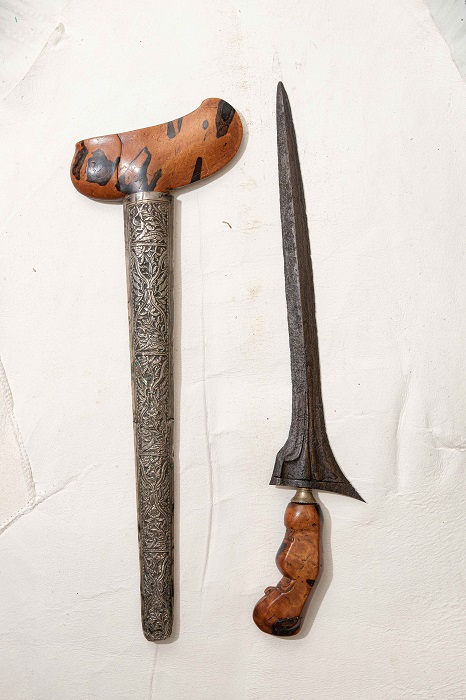
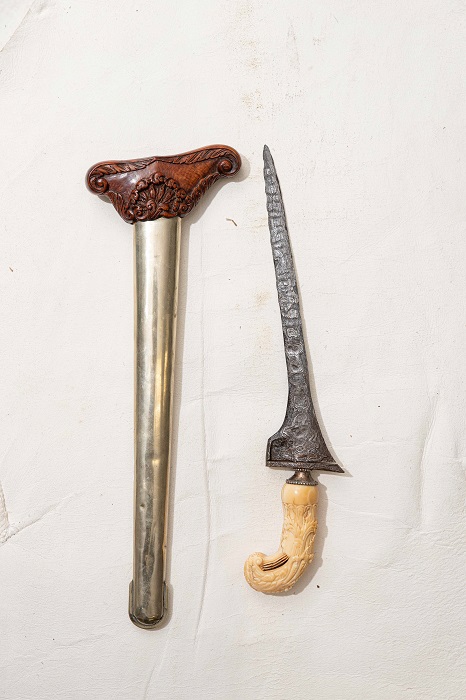
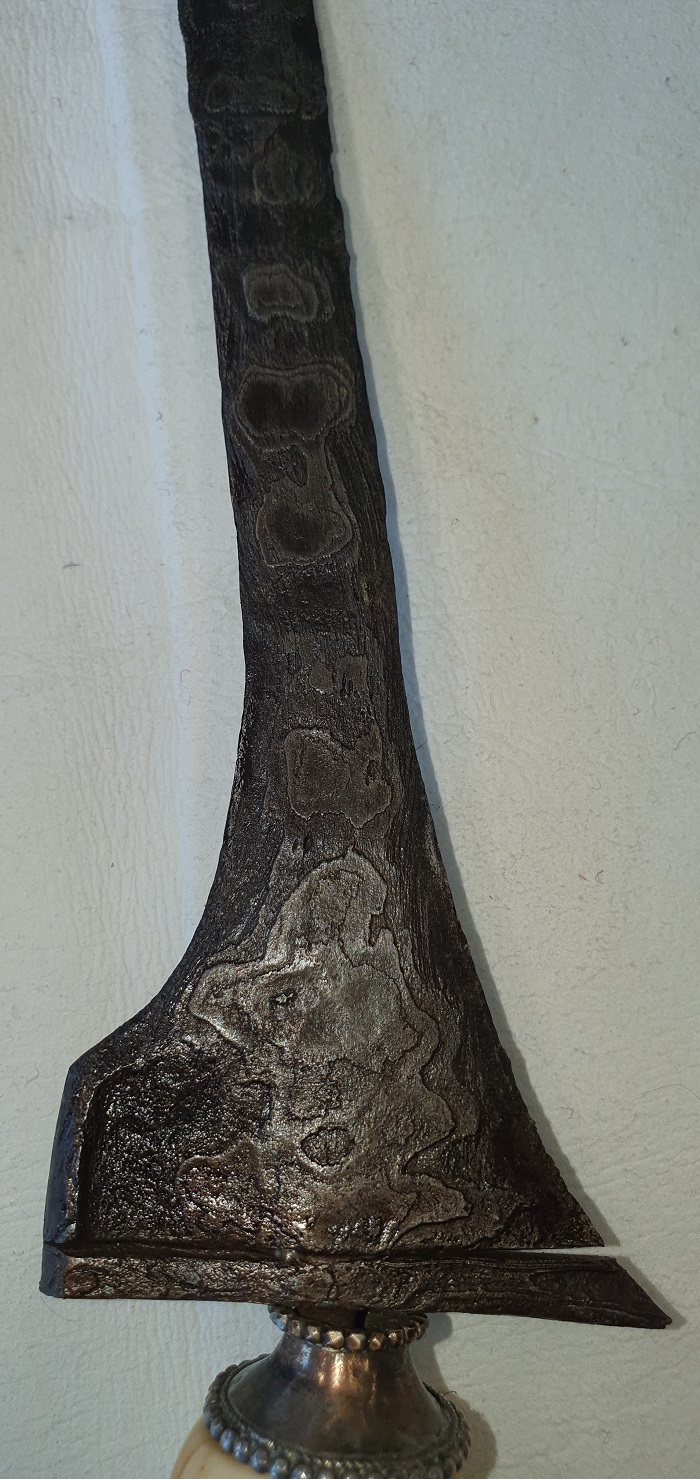

Keris east Java, Protection and good health. Magical powers. Protection in crisis.
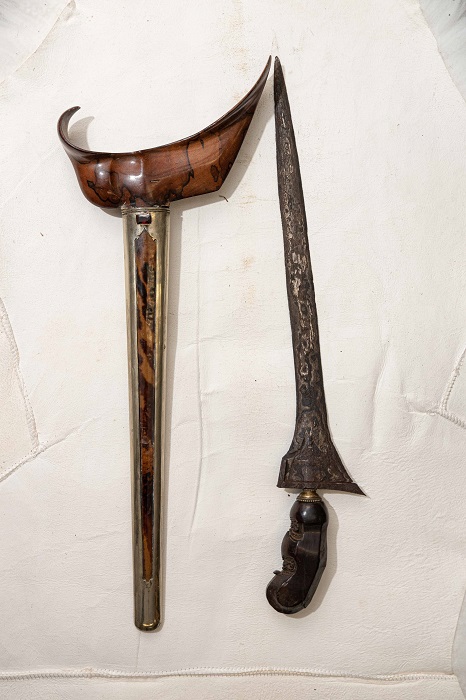
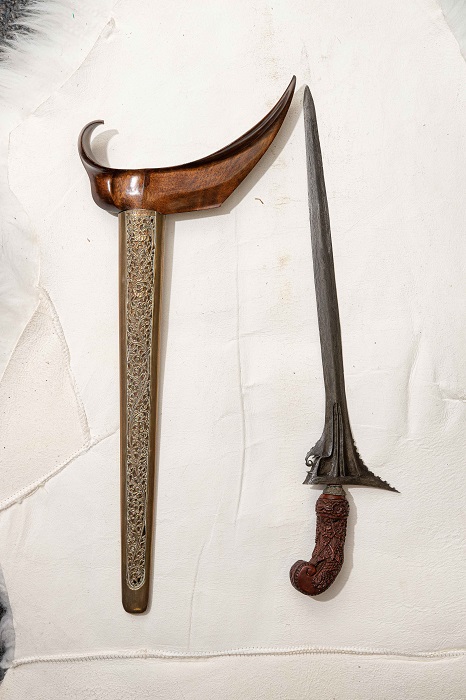
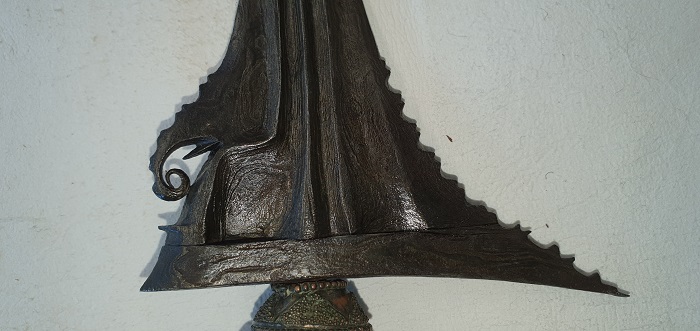
Keris east Java, Leadership, good relations, spirituality. Gives magical powers.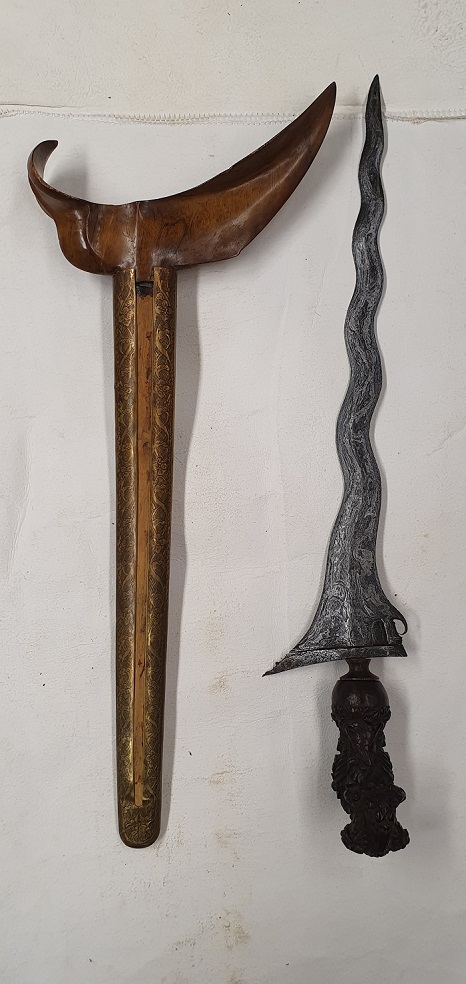
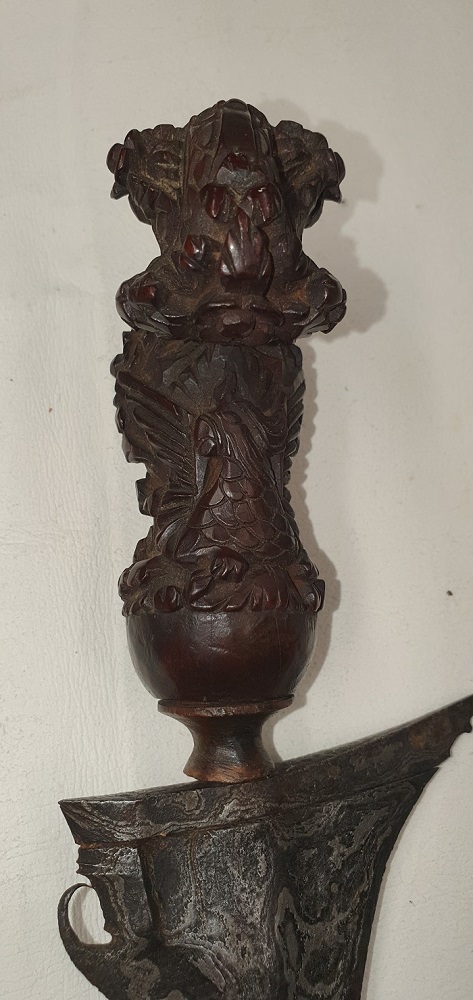
Keris Yogjakarta, kinatah mas, popularity, good health, safety, leadership.
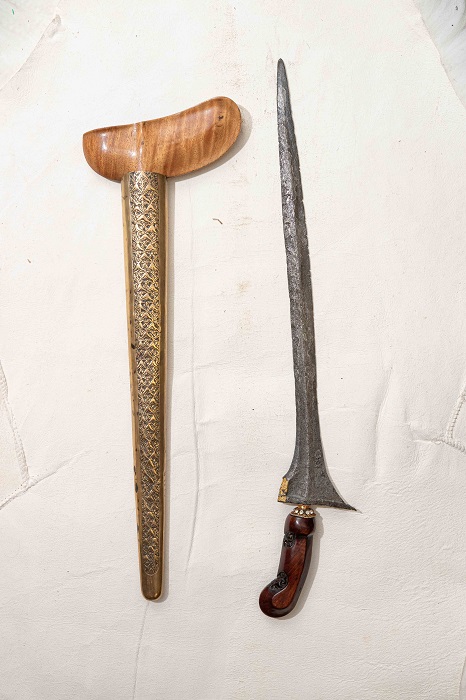
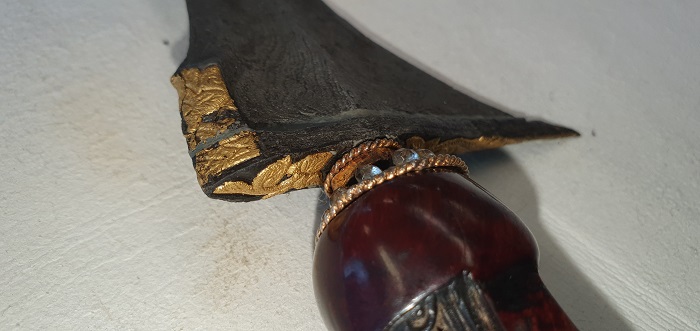
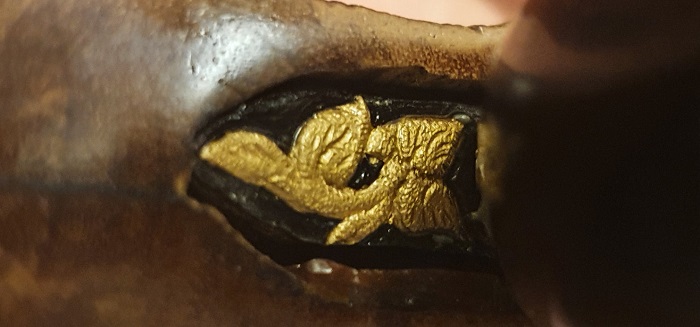

Keris Solo, pusaka heirloom, gives positive magical power, good for protection. Very active spirit!
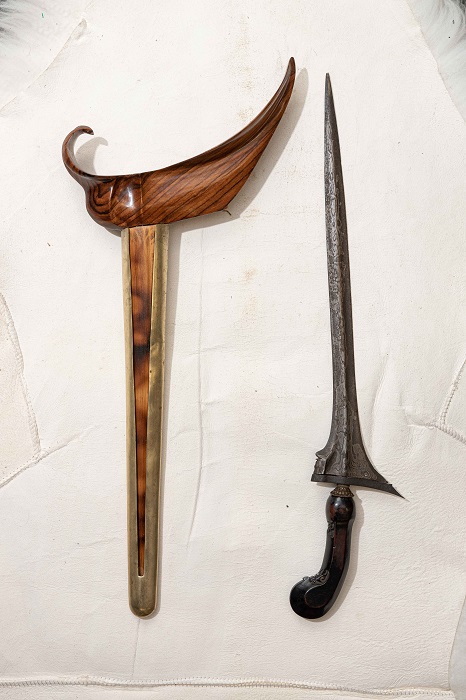
![]()
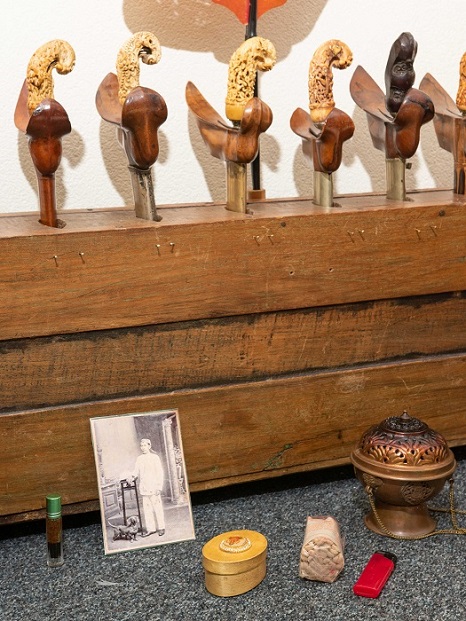
Keris east Java, spiritual power, protection, very active spirit. Gives determination and power.
Keris Jogjakarta, pusaka heirloom. For luck and good health
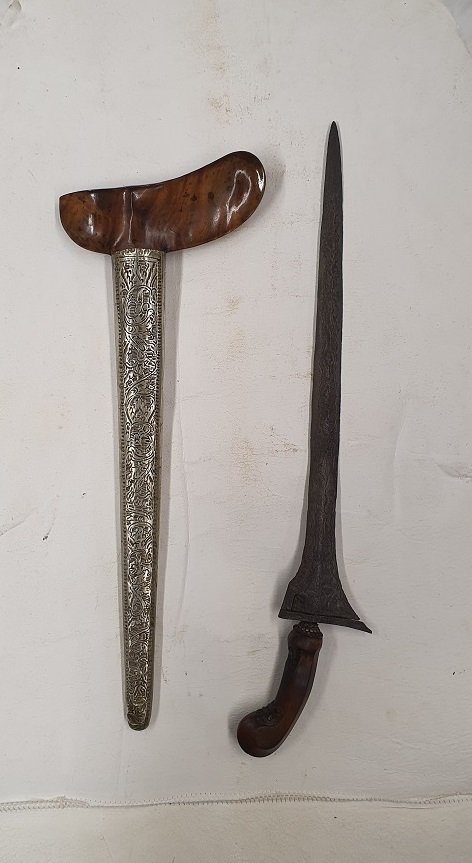
Keris name: Kiayi Begja
Pamor: Beras Wutah
Dapur: Tilam Upih
Tangguh: Jogjakarta 18th century
Hilt: Jogja style, Paku Alaman.
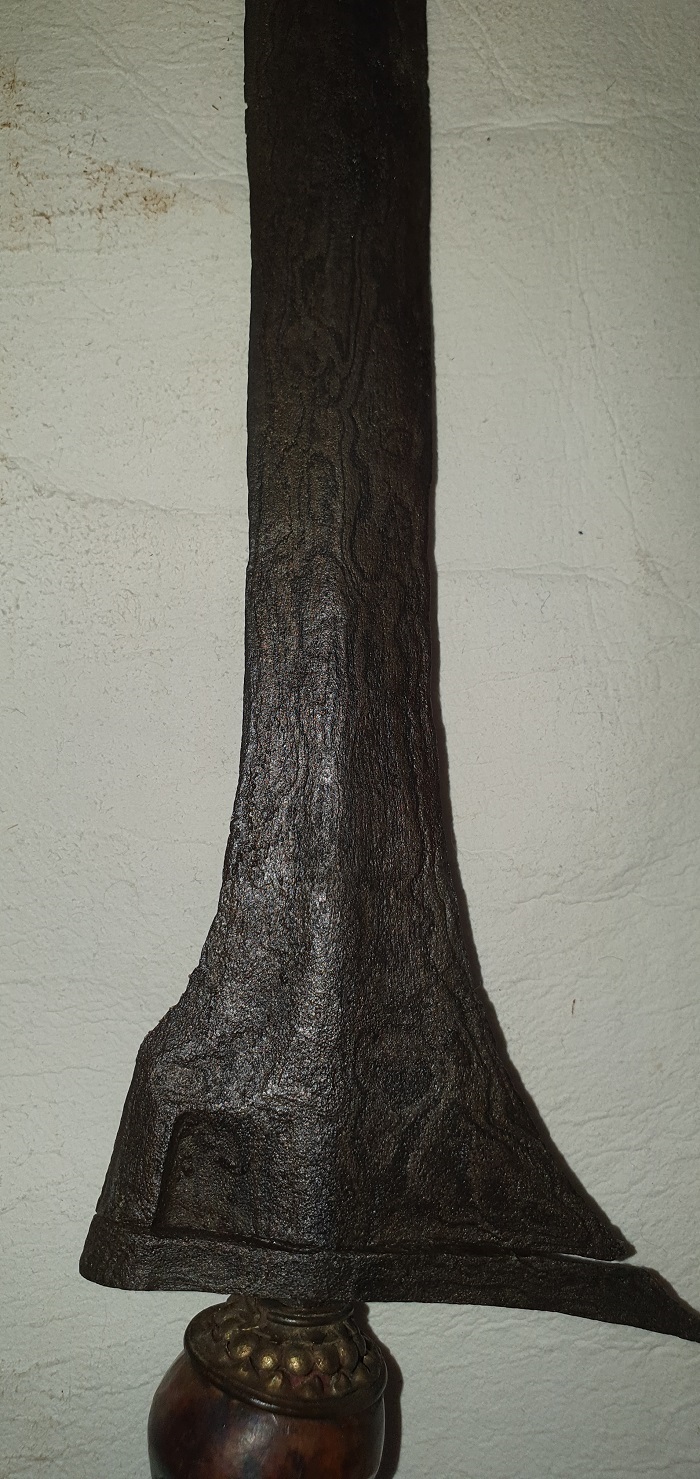
Keris Surakarta, pusaka heirloom. spiritual high keris 15 luk, gives great mistical power! A keris with 15 luk or more should surpass everything...
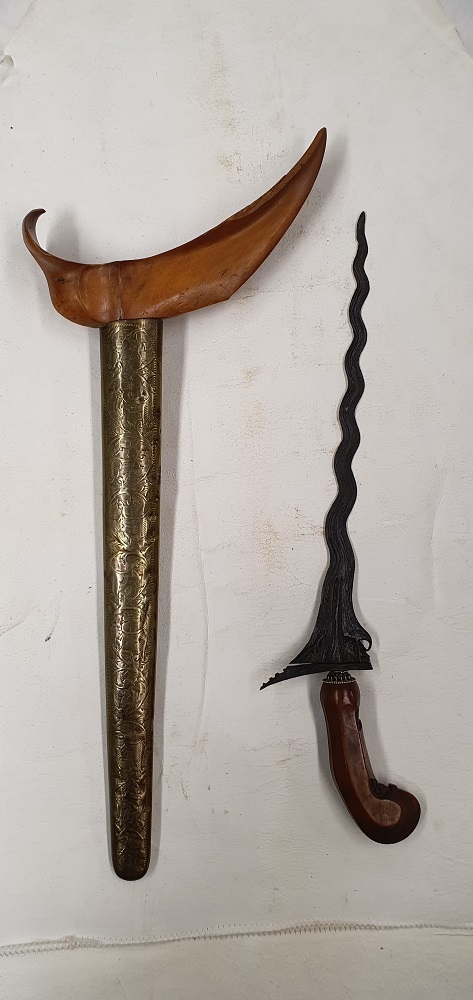
Keris name: Kiayi Om Herman
Pamor: pedaringan kebak
Dapur: Parung Sari 15 luk
Tangguh: Demak 16th century
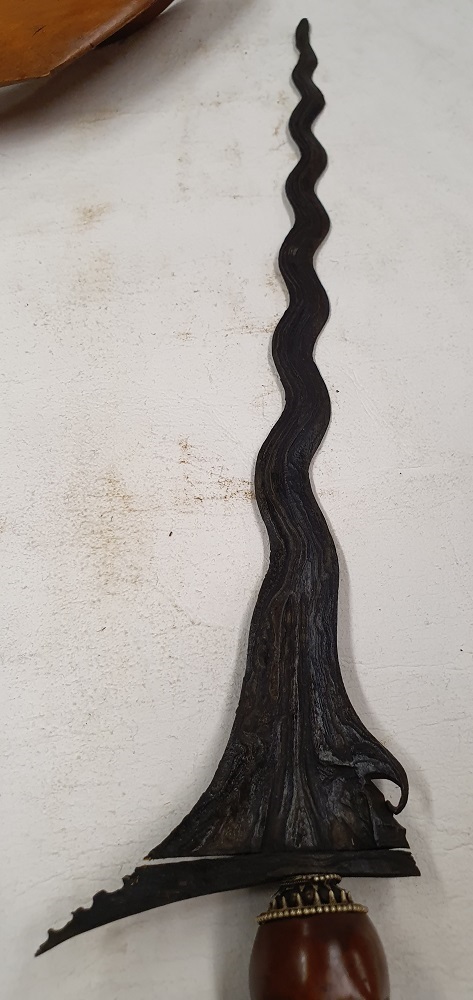
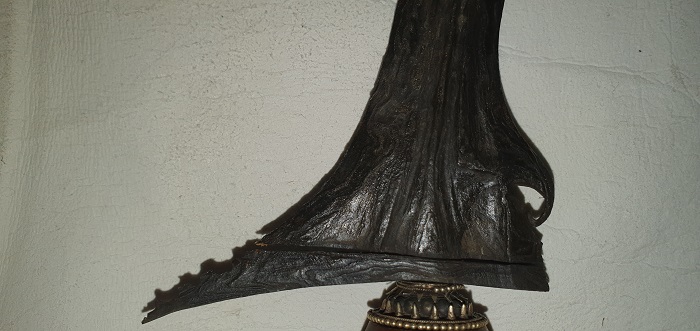
Keris east Java, Goodluck, protection,
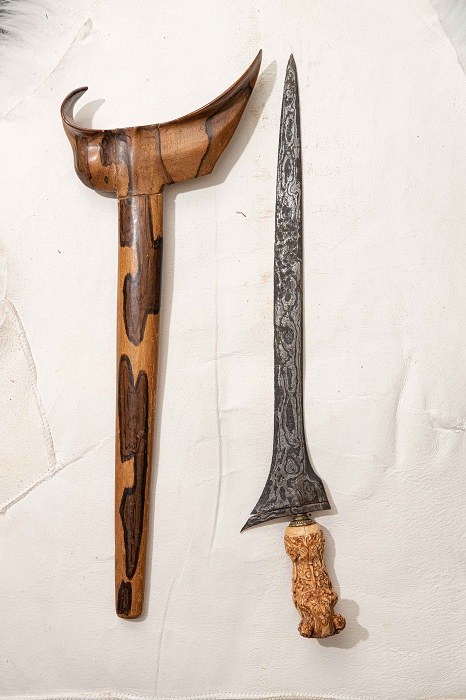
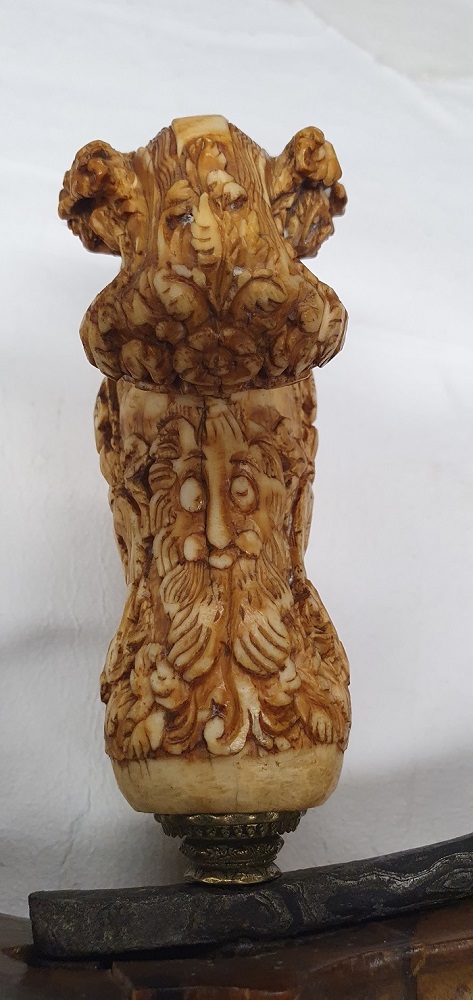
The lion
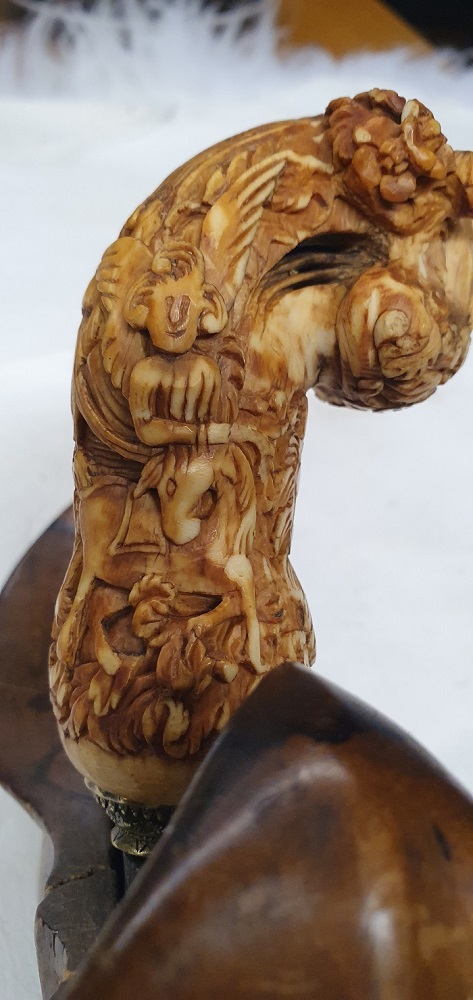
The angel and the horse...
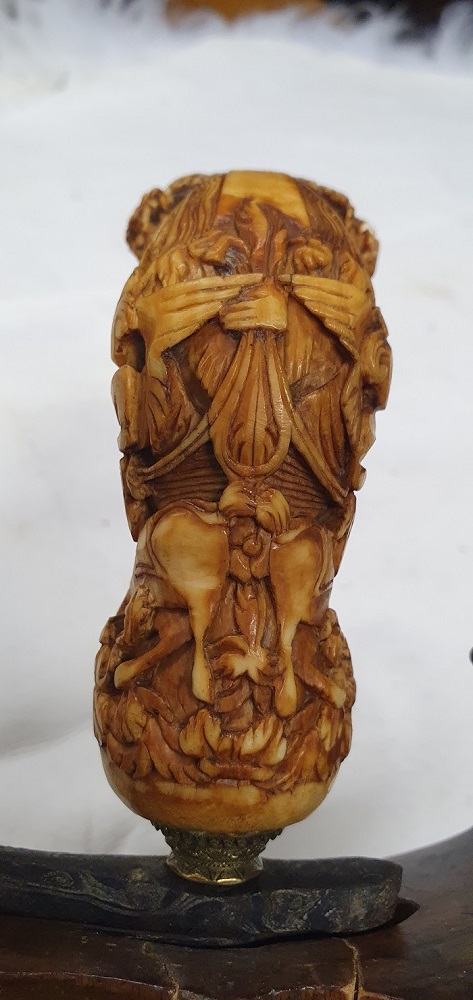
Keris east Java, protection against negativity and enemies.
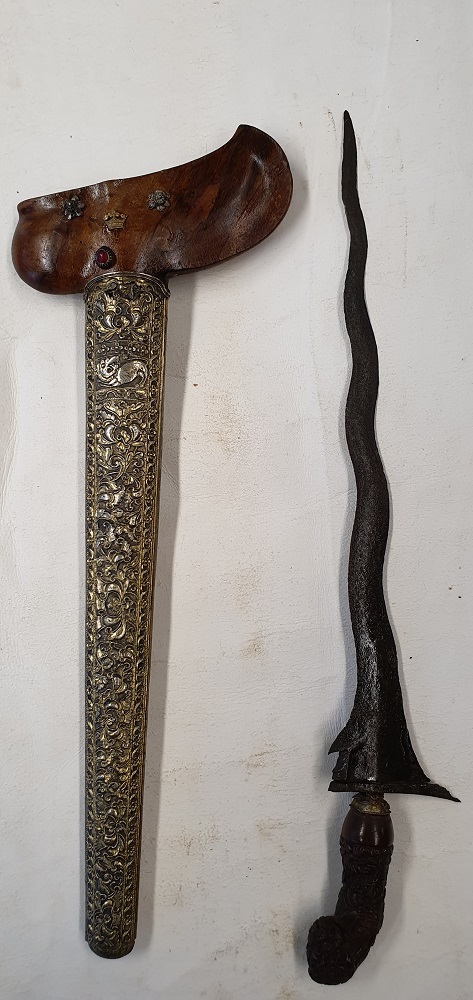
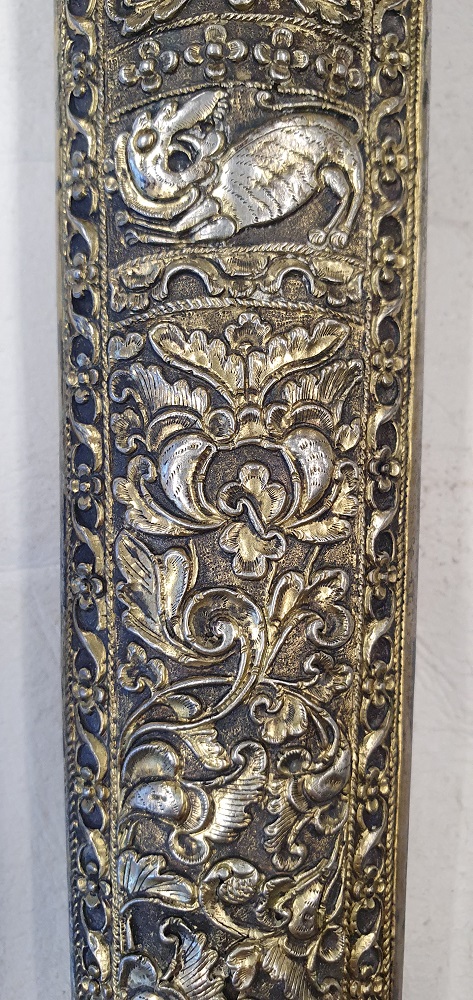
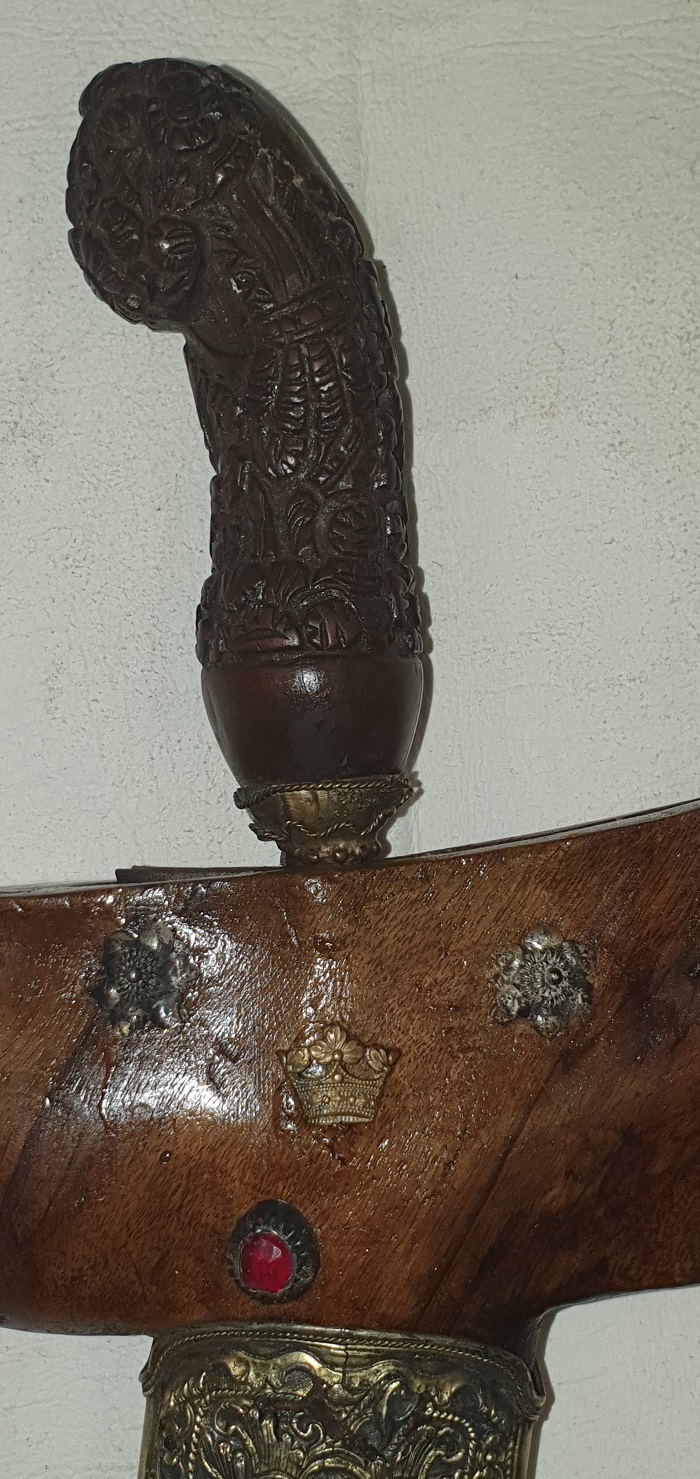
Keris east Java, pusaka heirloom, high nobility keris. Kembang kacang bungkem.
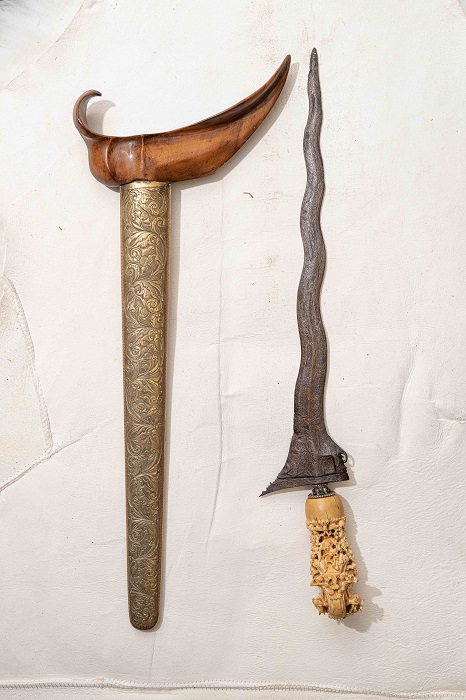
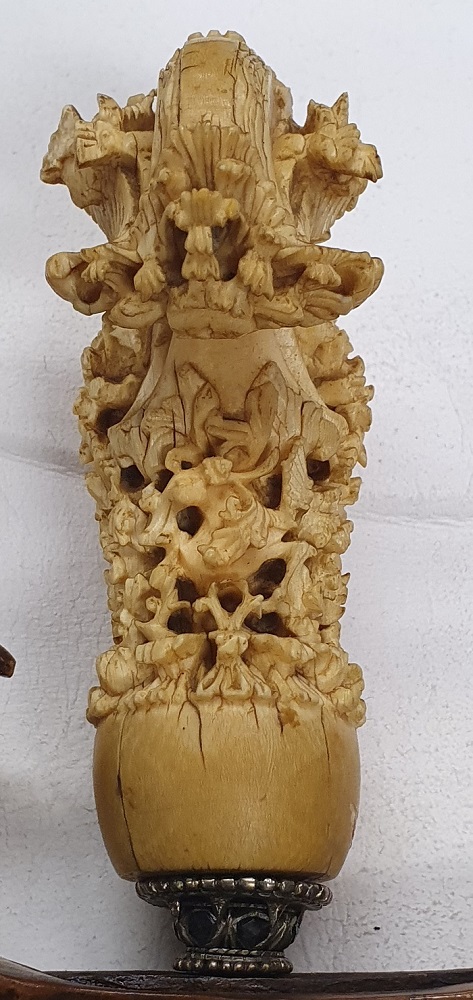
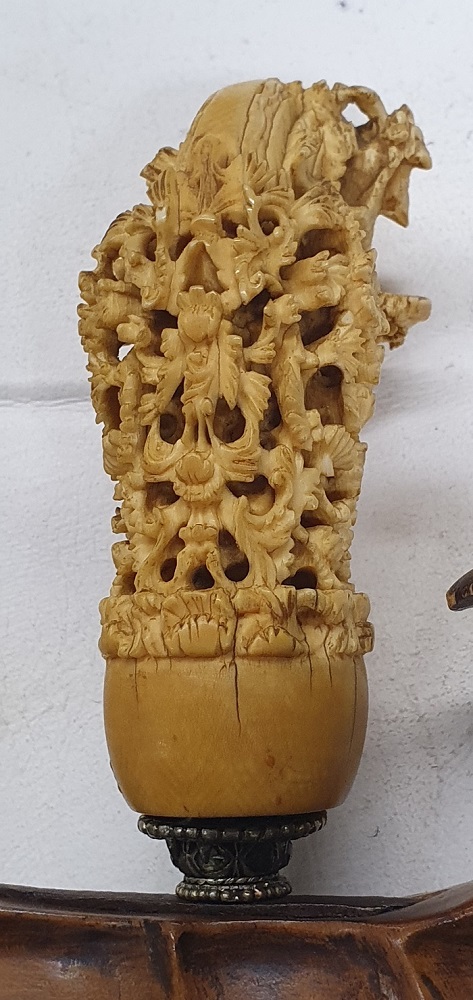
Keris Cirebon, Raja keris, agains witchcraft, for healing (lam alif), and protection against black magic.
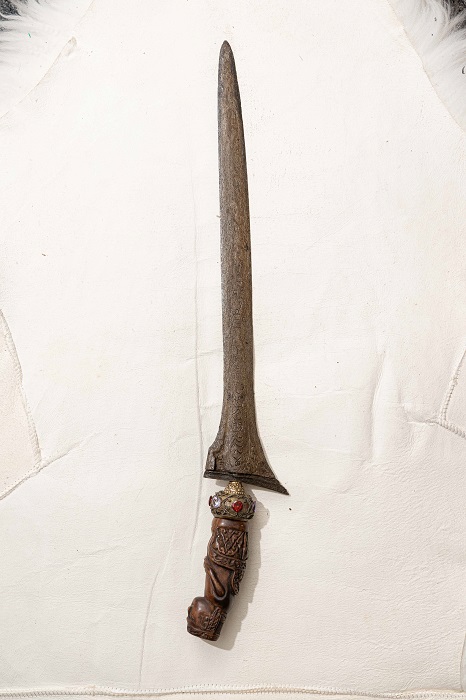
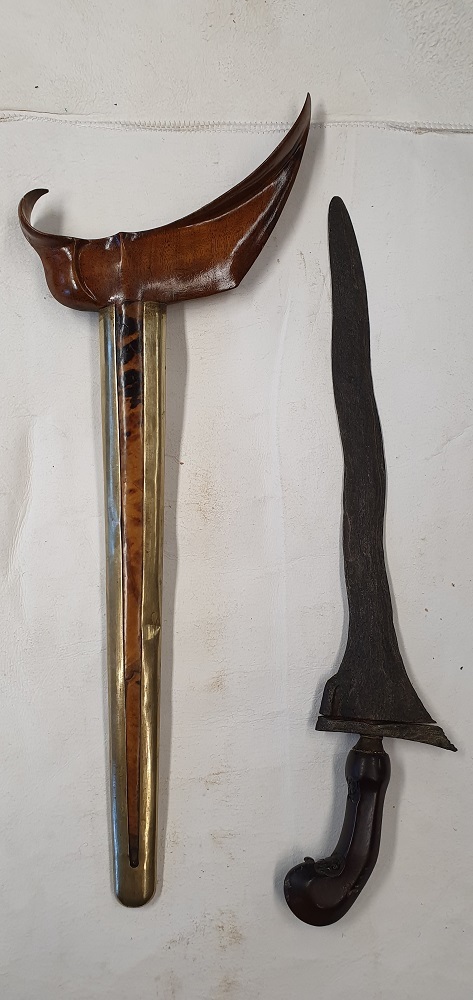
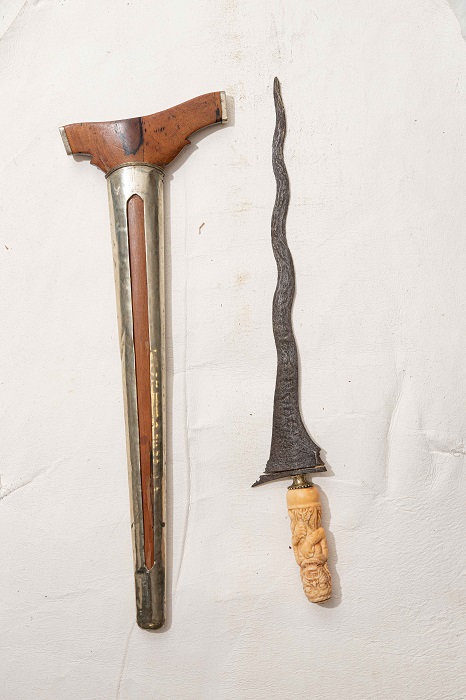
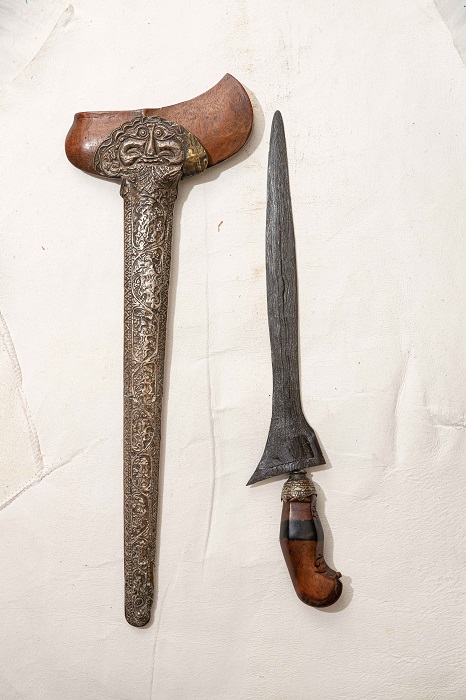
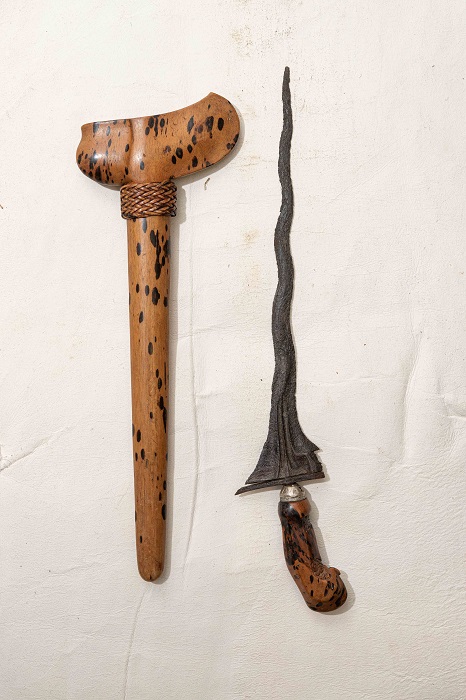
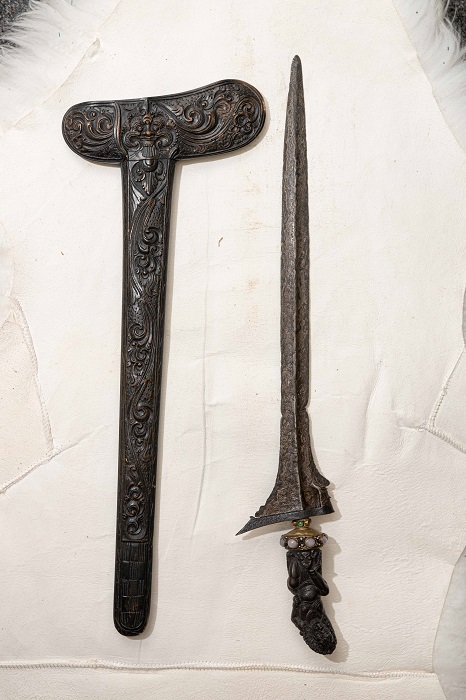
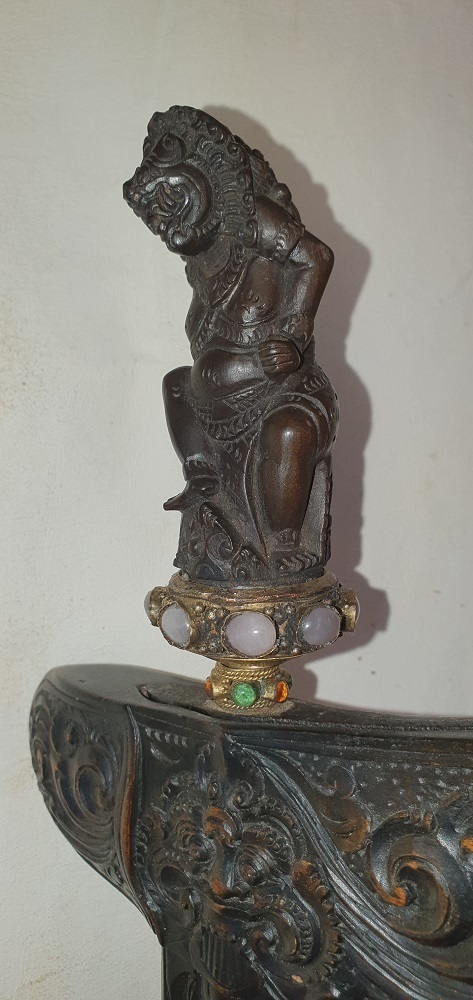
Keris east Java, pusaka heirloom, small amulet keris. Protection, ward of danger, protection.
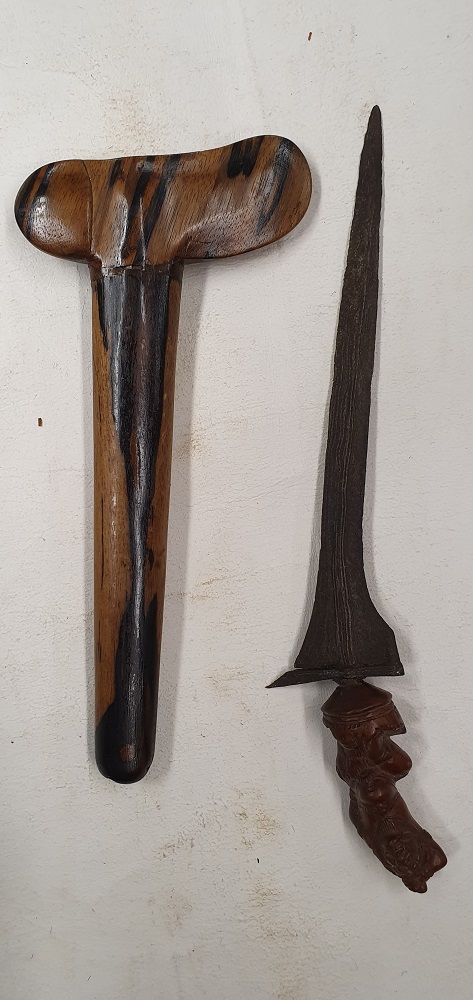
Keris name: Kiayi Angin
Pamor: Adeg Papat.
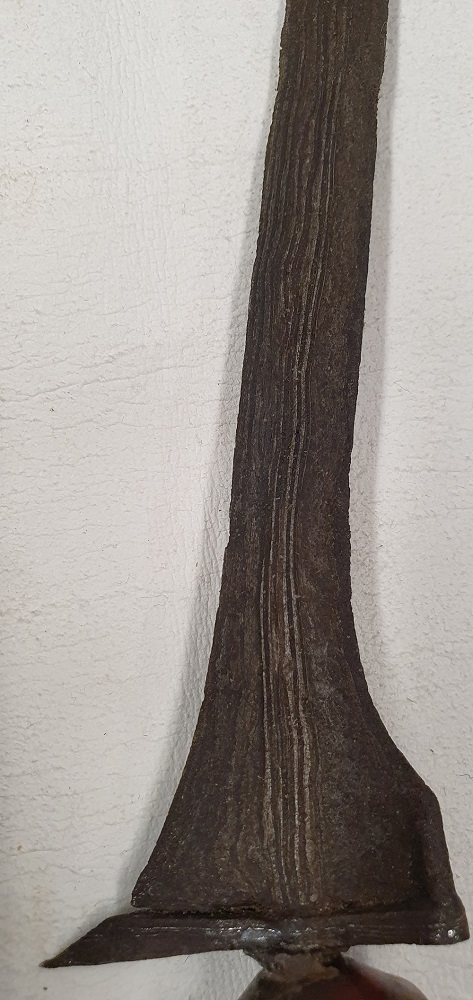
Old pusaka in recent sarong
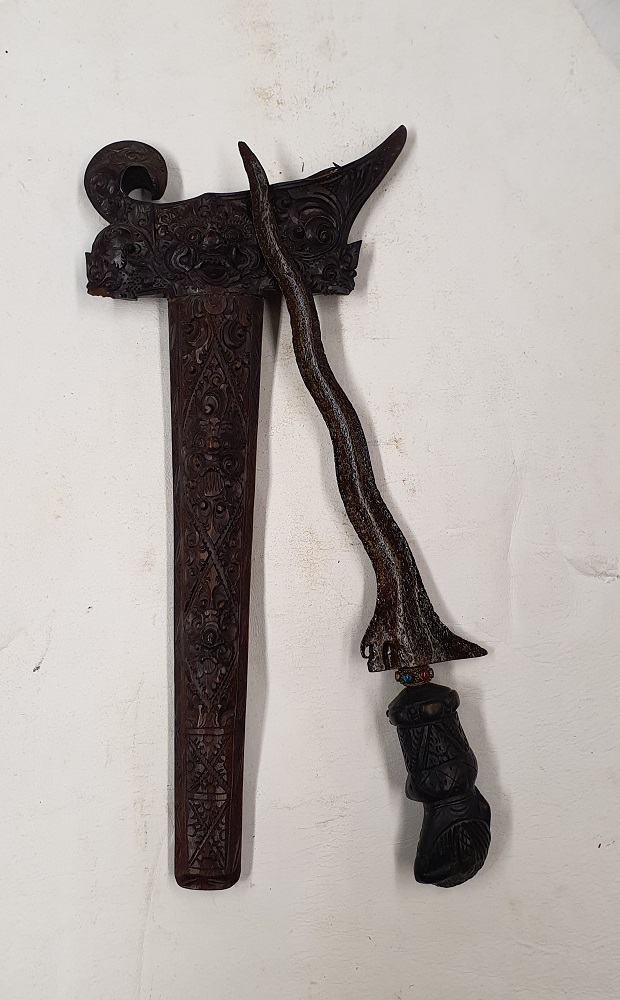
This is an example of how lots of pusaka's are kept, in a new dress, missing ganja, but comming from your father. These keris are still very valuable as heirloom, not as complete keris. I wil not change the dress or complete it with a ganja. I keep it like this...
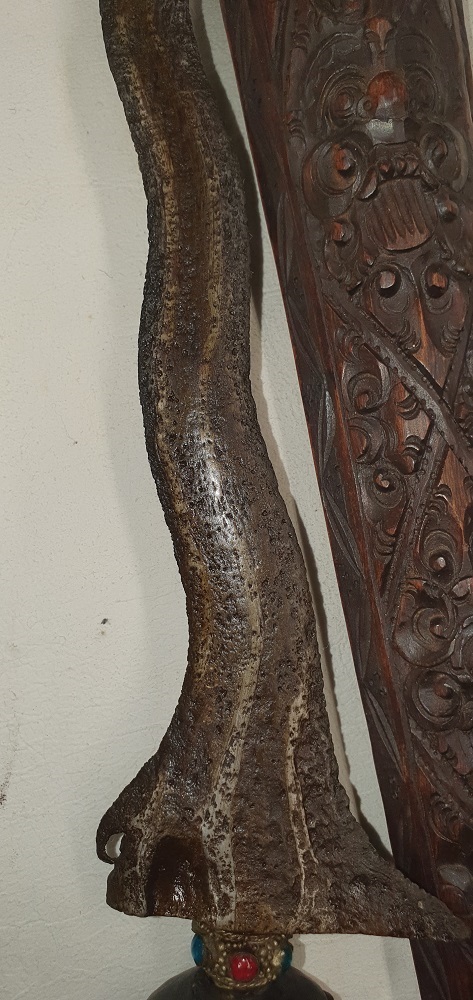
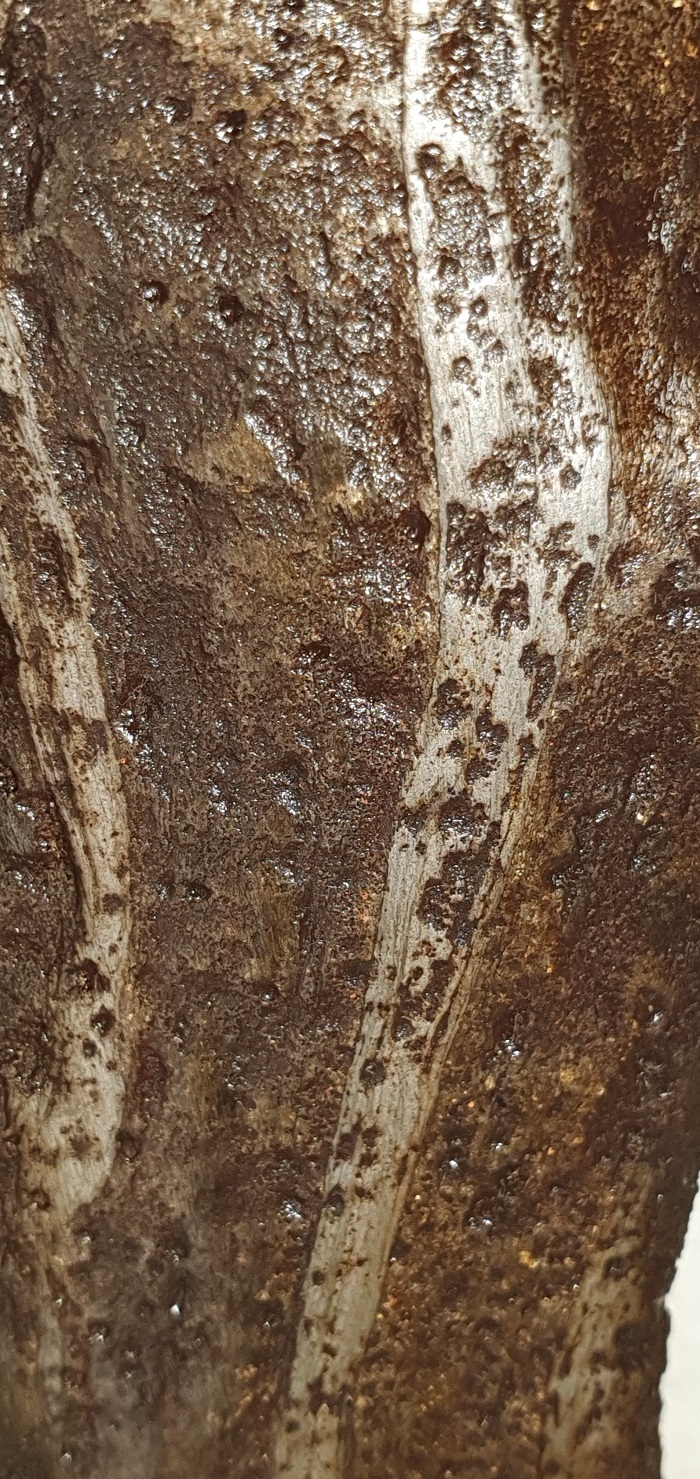
Kudjang
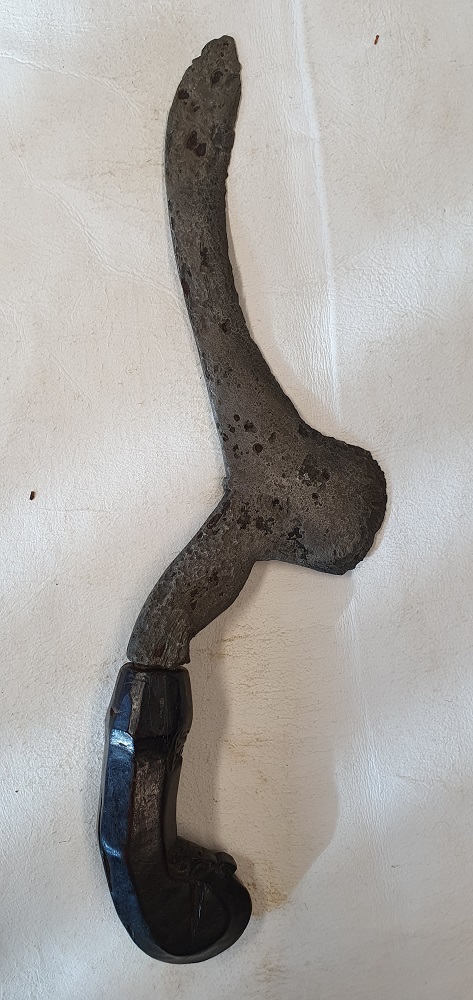
Kudjang from the Borobudur time 9th century.
Tangguh Kebudhan
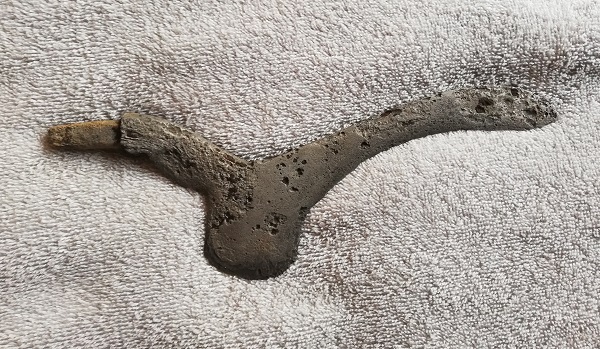
Fighting keris, Madura.
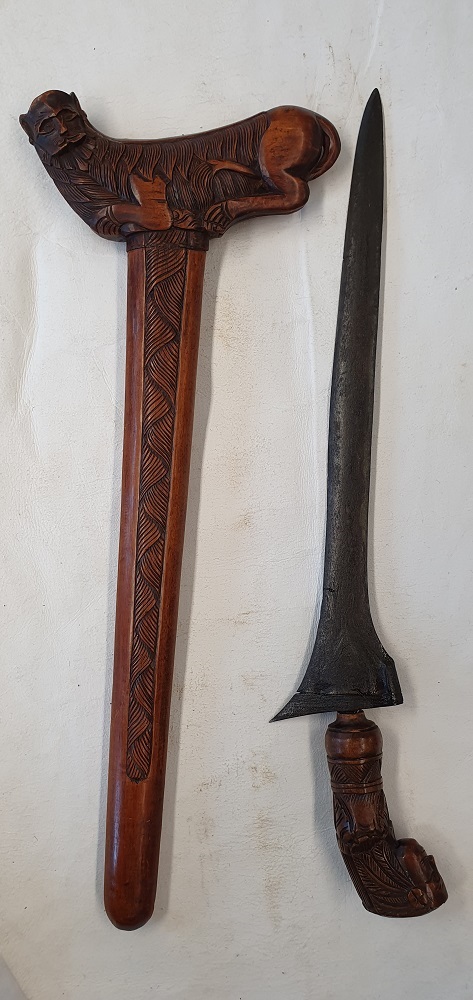
Fighting keris from Madura. This is absoluut the most copied warangka, made from heavy damascus steel.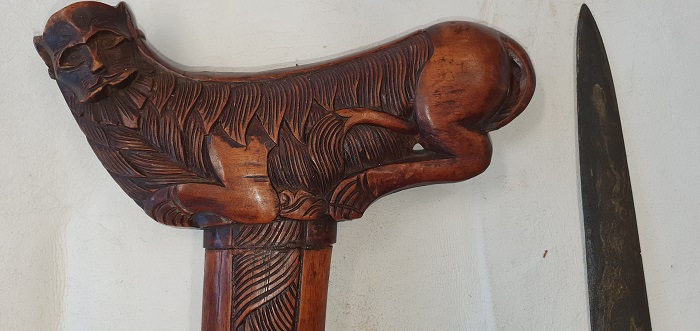
My Pusaka and their origins

My keris and pusaka keris
This is my collection of sacret heirlooms, traditionaly handed over as a spiritual gift!
You can subdivide my collection in Madurese, east Java, Blambangan. Yogjakarta and Sumatra.

Keris Madura, East Jawa
My most important keris, the keris from my father.
Keris east Java, Madura. Pusaka heirloom, For good Leadership, respect, protection of the family, spiritual development.

Keris name: Kiayi Senang Hati, the keris from my father..
Pamor: Ron Genduru, Bulu Ayam Wengkon.
Dapur: Tilam Upih
Tanguh: Blambangan 18th century
Hilt: Kembang Temu
Mendak: Angkup Randuh type silver carved


Keris east Java, pusaka heirloom, for protection. Rojogondolo. The spirit of this keris visits you in your sleep and gives you messages from above...

Keris name: Kiayi Nenek
Pamor: Beras Wutah, Rojo Gondolo
Dapur: Sempang 9 luk
Tanguh: Blambangan 16th 17th century
Hilt: Donoriko Ivory
Mendak: Angkup Randu Filigrain
.jpg)
.jpg)
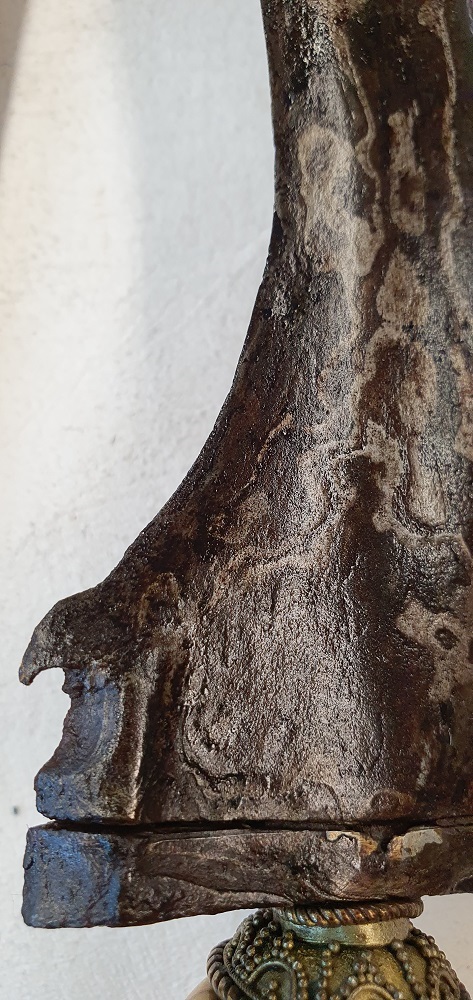
Hilt: Donoriko Ivory
Mendak: Angkup Randu Filigrain
.jpg)
.jpg)



Keris east Java, pusaka heirloom, to ward off unwanted events, against negativity, ghosts, dangerouse animals. This keris gives you spiritual power. The spirit of this keris travels. Very active keris.

Keris name: Kiayi Mimi
Pamor: Adeg
Dapur: Tumenggung
Tanguh: Blambangan 17th century
Pendok, Suassa
Hilt: Surakarta Yudowinatan shape
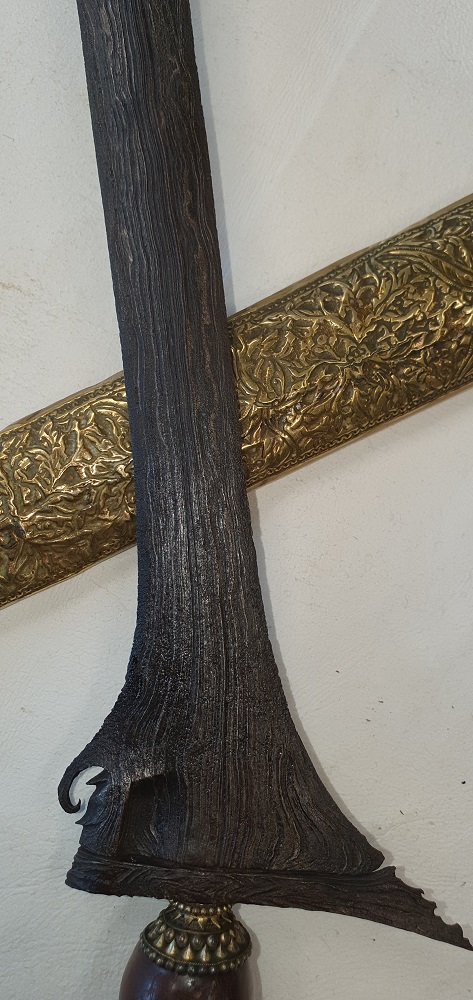
Keris east Java, ward off unwanted events and negativity. Protection agains attack.
Pendok, Suassa
Hilt: Surakarta Yudowinatan shape

Keris east Java, ward off unwanted events and negativity. Protection agains attack.

Keris name: Kiayi Angin2
Pamor:Adeg Wengkon
Dapur: Tilam Upih
Tanguh: Blambangan 18th century
Hilt east Java type Cecekan Krawangan with naturak kendit.
Pendok: silver
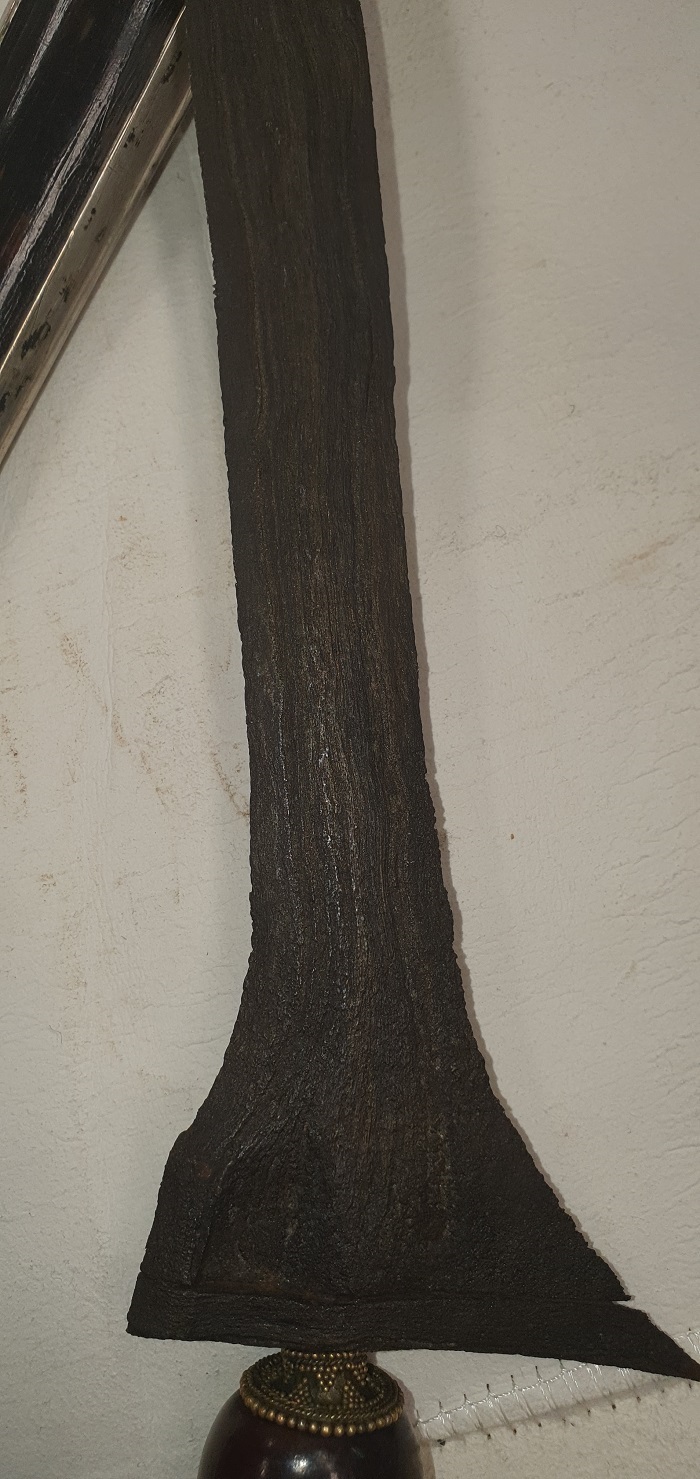
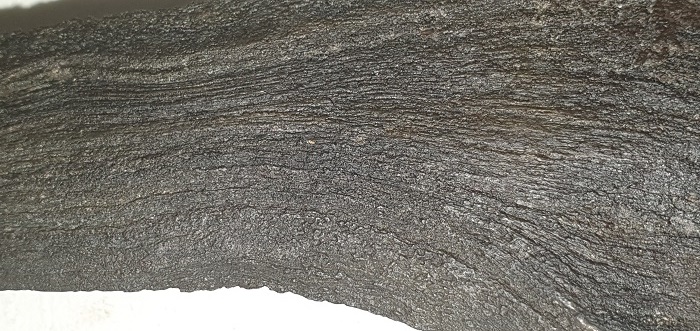
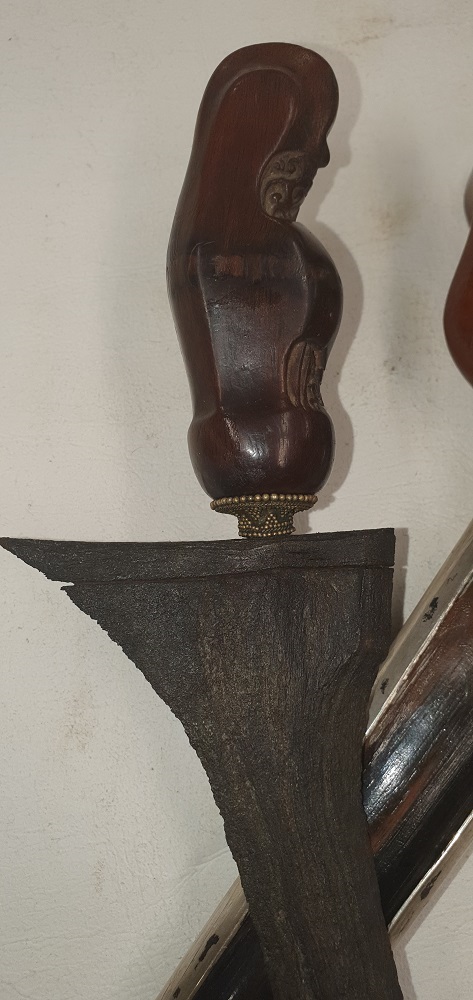
Keris mid Java, pusaka heirloom, spiritual keris, with a very active ghost inside this keris. This keris is always in a closed box.
Hilt east Java type Cecekan Krawangan with naturak kendit.
Pendok: silver



Keris mid Java, pusaka heirloom, spiritual keris, with a very active ghost inside this keris. This keris is always in a closed box.

Keris name: Kiayi Saka Swarga
Pamor: meteorit, very heavy because of the high amount of nickle in the blade.
Dapur: Jaran Guyang
Tanguh: Yogjakarta 18th century
Hilt: Yogjakarta style Tayuman
The ring suassa and a batu Panca Warna belongs to the keris.
Hilt: Yogjakarta style Tayuman
The ring suassa and a batu Panca Warna belongs to the keris.


Keris east Java, pusaka heirloom, High keris, 13 luk, nobility, good leadership, good relations with every one.

Keris name: Kiayi Pambantu
Pamor:Wiji Timun
Dapur: Parung Sari
Tanguh: Mataram Senopaten 16th century
Hilt: Jangelan type
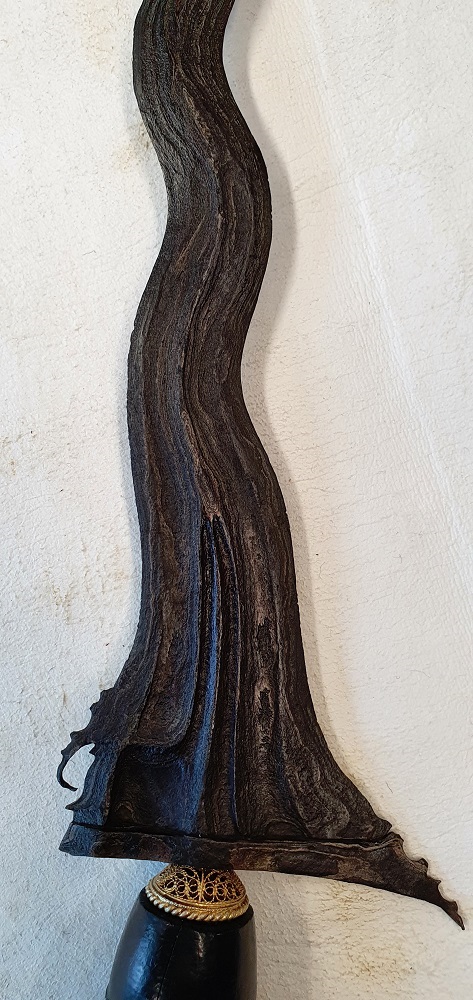
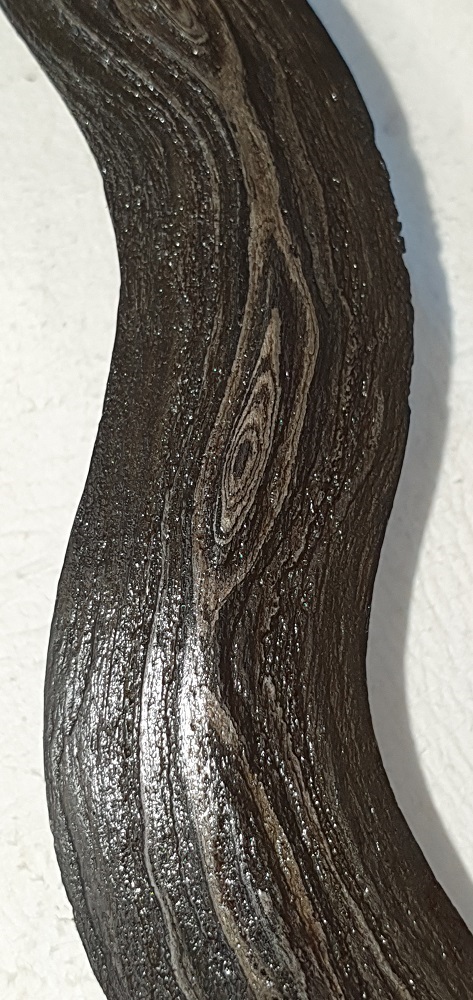
Keris east Java, pusaka heirloom. High keris from the nobility, the priayi, of east Java. Very spiritual keris.
Hilt: Jangelan type


Keris east Java, pusaka heirloom. High keris from the nobility, the priayi, of east Java. Very spiritual keris.

Keris name: Kiayi Slamet
Pamor: Pedaringan kebak
Dapur: Carita Daleman
Tanguh: Majapahit 15th century
Hilt: Donoriko Ivory
Pendok Silver
Mendak: Angkup Randu type gold filigrain
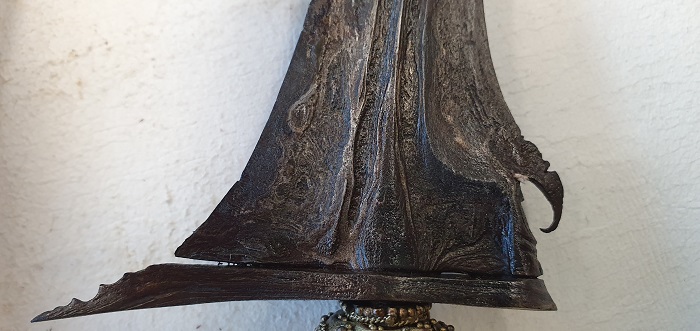

Hilt: Donoriko Ivory
Pendok Silver
Mendak: Angkup Randu type gold filigrain




Keris east Java, spiritual keris, Ratu Kidul, the queen of all the spirits.

Keris: Kiayi Nji Blorong
Pamor: Nji Blorong
Dapur: Nji Blorong
Tanguh: Mataram 18th century
Hilt: Ratu Kidul type with Kuda Sembrani
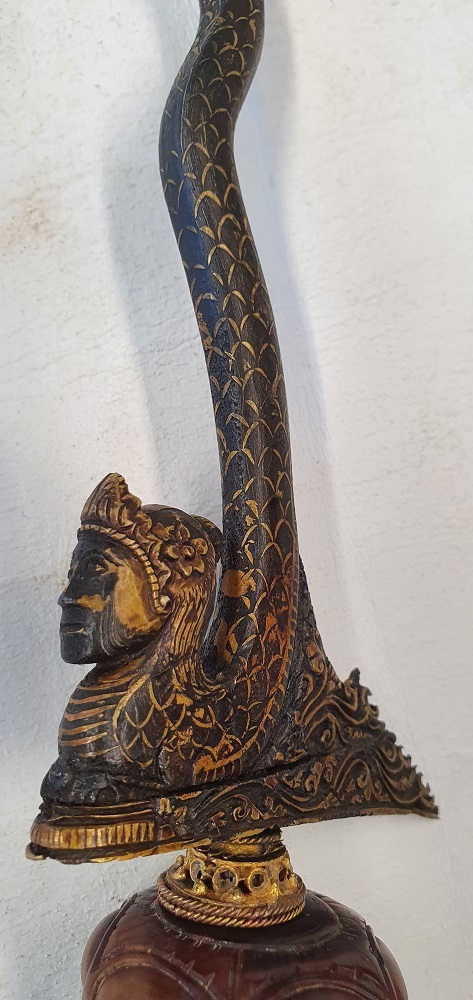
Hilt: Ratu Kidul type with Kuda Sembrani


Keris Yogjakarta, pusaka heirloom. High Keraton keris, from an army officer. Very active spiritual keris.

Keris name: Kiayi Bangsawan Tinggi
Pamor: layerd, the age made the pamor les visible.
Dapur: Pulang Geni
Tanguh: Majapahit 15th century
Pendok Gold
Hilt: Kagok, Narada Khanda type.
Pendok Gold
Hilt: Kagok, Narada Khanda type.



Keris Solo, pusaka heirloom. old spiritual keris for meditation and as oracle.

Keris name: Kiayi Jansen
Pamor: Nggajih
Dhapur: Sempana 7 luk
Tangguh: Pajajaran 12th century
Hilt Surakarta style Yudowinatan type with mendak and selut

Keris Yogjakarta, Pandawa Lima, the Pandawa brothers from the Mahabarata.

Keris name: Kiayi Slamet
Pamor: Pedaringan Kebak
Dapur: Pandawa Lima
Tanguh: Mataram Sultan Agung 17th century
Pendok Silver
Hilt: Jogjakarta style Tayuman type
Pendok Silver
Hilt: Jogjakarta style Tayuman type

Keris east Java. pusaka heirloom. Absorbs negative energy. Mistical keris.

Keris name: Kiayi Cemeng
Pamor: Kelengan
Dapur: Sanguh Tumpeng
Tanguh: Tuban 15th century
Hilt: east Javanese Nunggat Semi type
Warangka: Kayu pelet
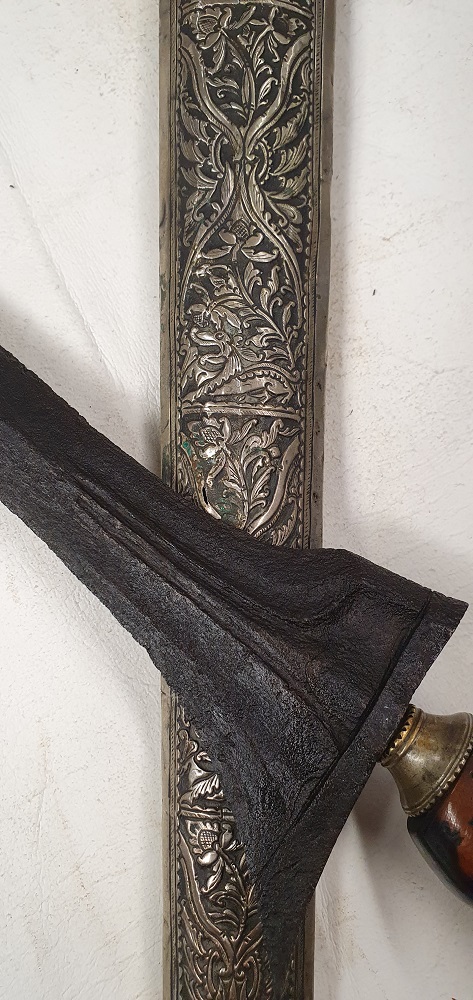
Keris east Java, pusaka heirloom, keris Patrem, A keris for good luck and protection, very active keris.
Hilt: east Javanese Nunggat Semi type
Warangka: Kayu pelet

Keris east Java, pusaka heirloom, keris Patrem, A keris for good luck and protection, very active keris.

Keris name: Kiayi Raden Aju
Pamor: Bendo Sagodo
Dapur: Tilam Upih
Tanguh: Segaluh 13th century
Hilt Ivory, kong bukong type
Pendok silver
Mendak silver
Warangka: Jurigan type, Madura.
Hilt Ivory, kong bukong type
Pendok silver
Mendak silver
Warangka: Jurigan type, Madura.


Keris east Java, Protection and good health. Magical powers. Protection in crisis.

Keris name: Kiayi Watu Permata
Pamor: Beras Wutah Meteorit
Dapur: Tilam Upih
Tanguh: Madura 16th century
Hilt: east Javanese Nunggat Semi type
Pendok: Silver, tortoise shell inlay.
Gemstone: Garnet.
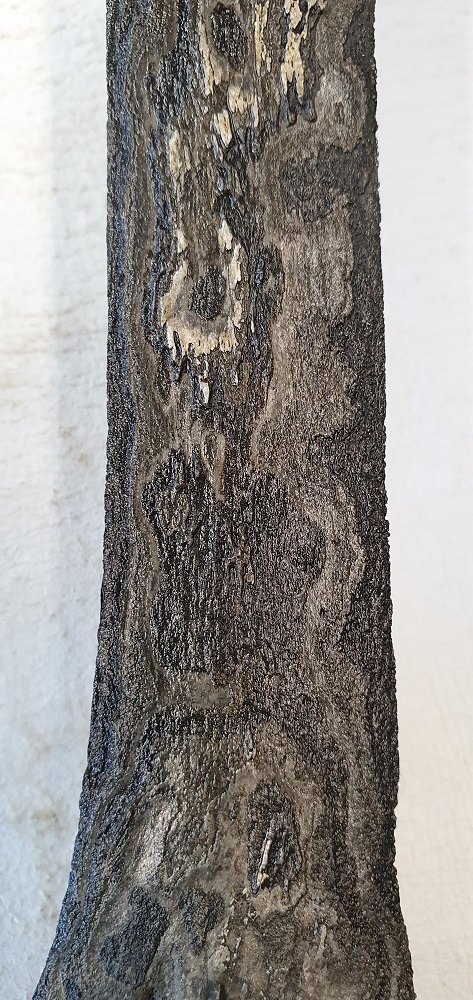
Keris east Java, good relations.
Hilt: east Javanese Nunggat Semi type
Pendok: Silver, tortoise shell inlay.
Gemstone: Garnet.

Keris east Java, good relations.

Keris name: Kiayi Tammens
Pamor: Wiyi Timun
Dapur: Sinom / Ikan Pari
Tanguh:Jawa Timor 18th century
Hilt Kembang Temu
Mendak: Randu type, filigrain.
Hilt Kembang Temu
Mendak: Randu type, filigrain.

Keris east Java, Leadership, good relations, spirituality. Gives magical powers.

Keris name: Kiayi Wedono Timor
Pamor:Beras Wutah
Dapur: Sempana
Tanguh:Madura 17th century
Hilt: Donoriko wood
Mendak: wood.
Pendok: Old fire gilded, not original, mid Java made to fit.
Hilt: Donoriko wood
Mendak: wood.
Pendok: Old fire gilded, not original, mid Java made to fit.

Keris Yogjakarta, kinatah mas, popularity, good health, safety, leadership.

Keris name: Kiayi Pelindung Tumpul
Pamor:Pedaringan Kebak, kinatah mas, gold wrought.
Dapur: Tilam Upih
Tanguh: Yogja 17th century HB 3
Pendok Suassa patern Semen Tritis
Hilt: Jogja.
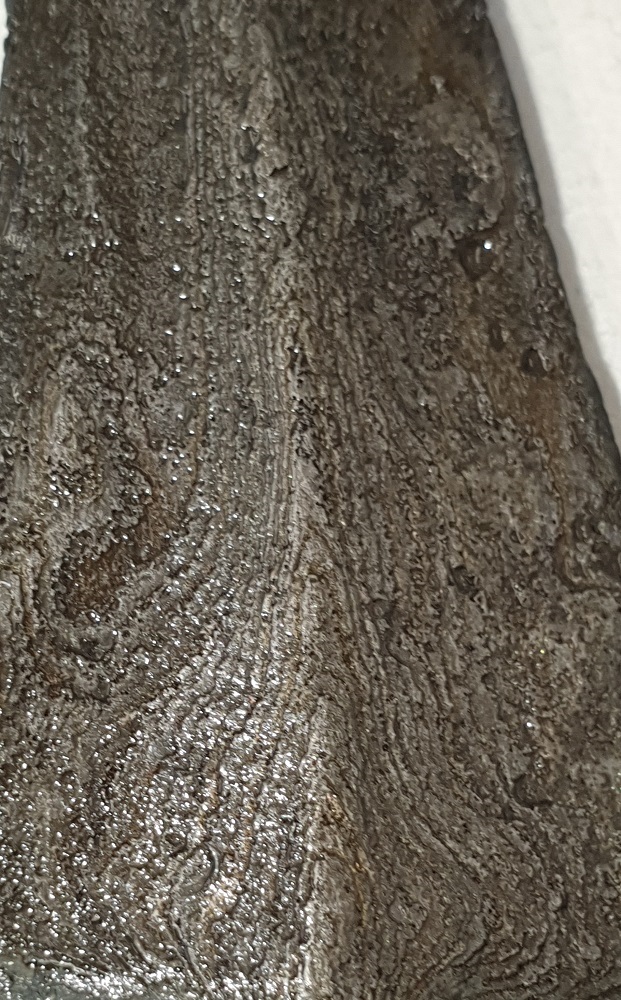
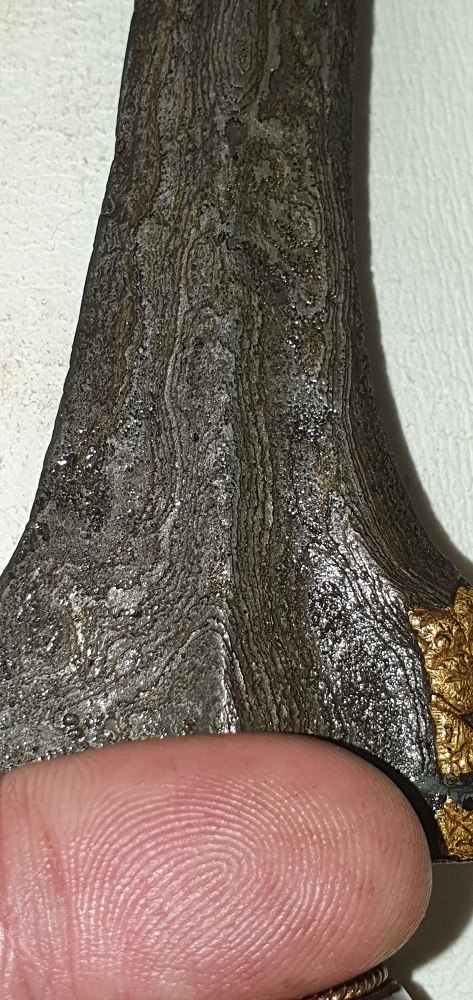
Pamor is smaller then fingerprint
Pendok Suassa patern Semen Tritis
Hilt: Jogja.


Pamor is smaller then fingerprint



Keris Solo, pusaka heirloom, gives positive magical power, good for protection. Very active spirit!

Keris name: Kiayi Mundharang
Pamor:Pedaringan Kebak
Dapur: Pasopati
Tanguh:Surakarta PB 4, 1830
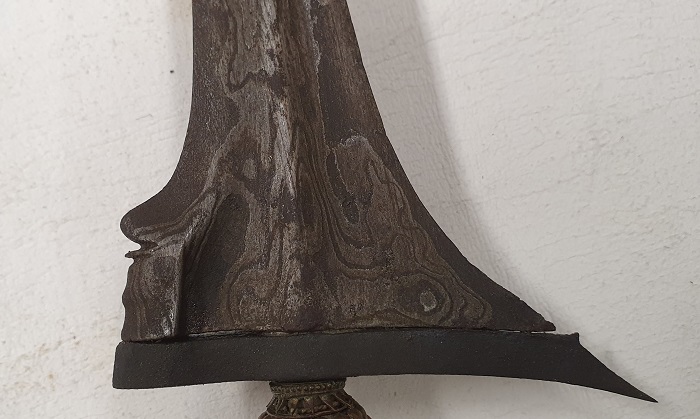


Keris east Java, spiritual power, protection, very active spirit. Gives determination and power.
Keris Jogjakarta, pusaka heirloom. For luck and good health

Keris name: Kiayi Begja
Pamor: Beras Wutah
Dapur: Tilam Upih
Tangguh: Jogjakarta 18th century
Hilt: Jogja style, Paku Alaman.

Keris Surakarta, pusaka heirloom. spiritual high keris 15 luk, gives great mistical power! A keris with 15 luk or more should surpass everything...

Keris name: Kiayi Om Herman
Pamor: pedaringan kebak
Dapur: Parung Sari 15 luk
Tangguh: Demak 16th century


Keris east Java, Goodluck, protection,

Keris name: Kiayi Kuda Malaekat
Pamor:Bendo Segodo
Dapur: Tilam Upih
Tanguh:Madura 17th century
Hilt Donoriko Ivory
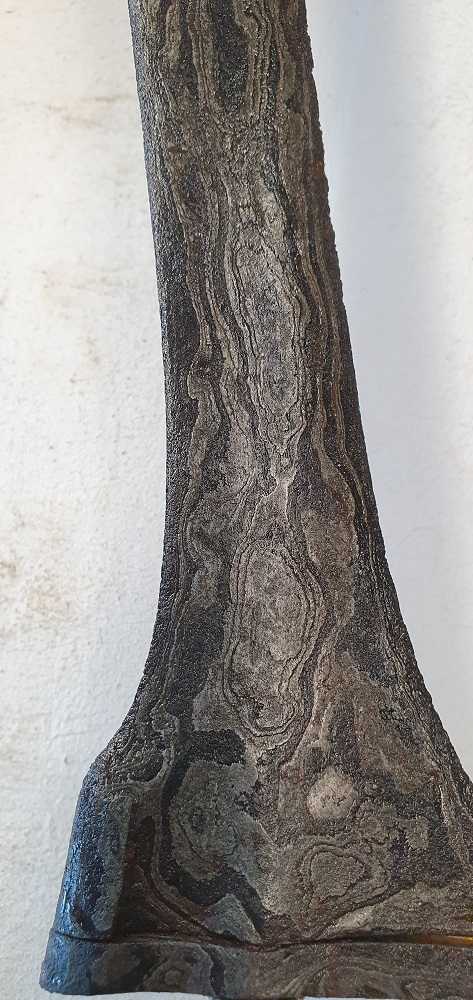
Hilt Donoriko Ivory


The lion

The angel and the horse...

Keris east Java, protection against negativity and enemies.

Keris name: Kiayi Jago Hitam
Pamor:Kelengan
Dapur: Jaran Gujang
Tanguh:Pajajaran 14th century
Pendok silver, gold plated.
Hilt: Donorico wood.
Warangka decorated with military awards.
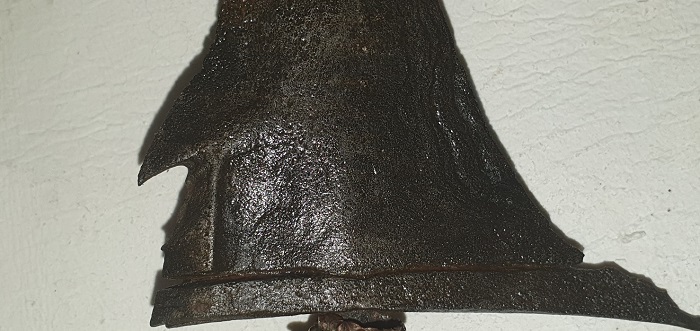
Pendok silver, gold plated.
Hilt: Donorico wood.
Warangka decorated with military awards.



Keris east Java, pusaka heirloom, high nobility keris. Kembang kacang bungkem.

Keris name: Kiayi Tujuh Supritah
Pamor:Segora Wedi
Dapur: Sempana 9 luk
Tanguh:Madura 15th century
Pendok Gold
Hilt: Donoriko Ivory
Mendak silver gemstones
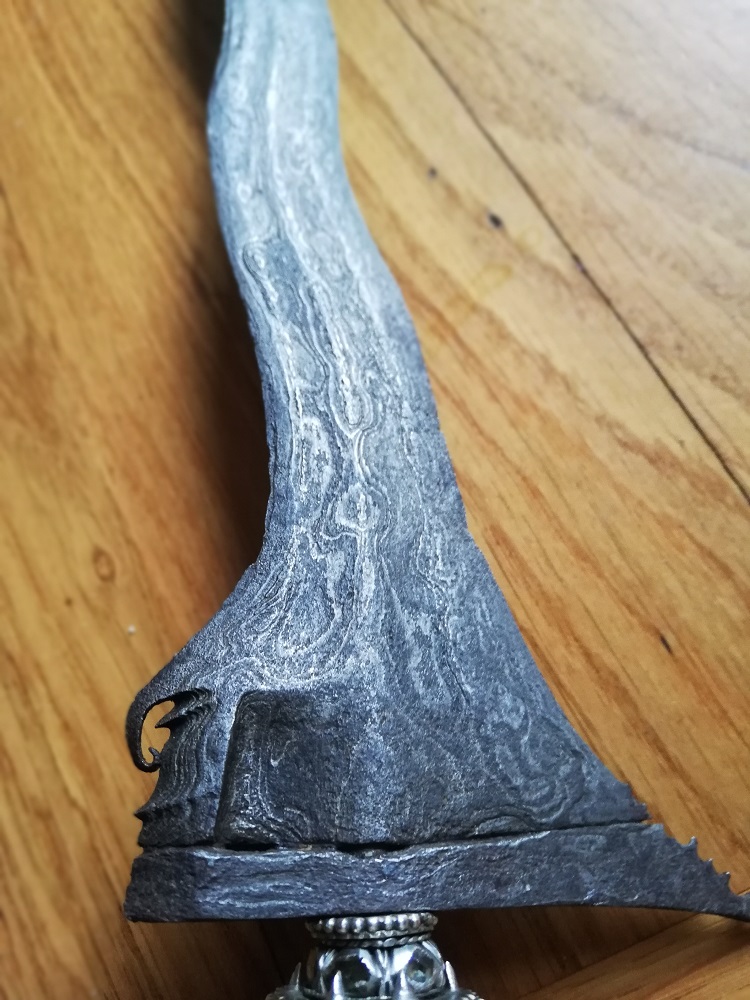
Pendok Gold
Hilt: Donoriko Ivory
Mendak silver gemstones



Keris Cirebon, Raja keris, agains witchcraft, for healing (lam alif), and protection against black magic.

Keris name: Kiayi Raja2
Pamor:Raja
Dapur: Tilam Upih
Tanguh:Cirebon 15th century
.jpg)
Keris east Java, spirituality. Singosari keris.
.jpg)
Keris east Java, spirituality. Singosari keris.

Keris name: Kiayi Shakti
Pamor: Kelem
Dapur: Betok luk
Tanguh: Singosari 13th century
Pendok brass, Tortoise shell inlay.
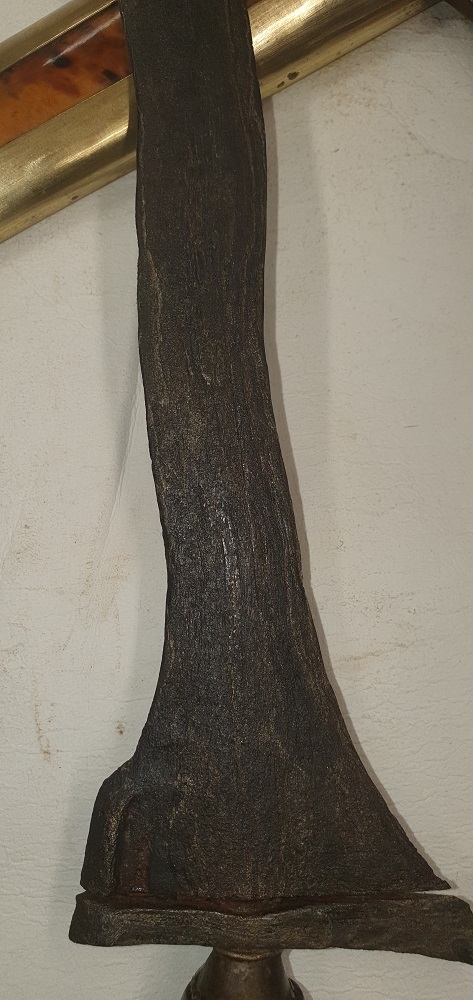
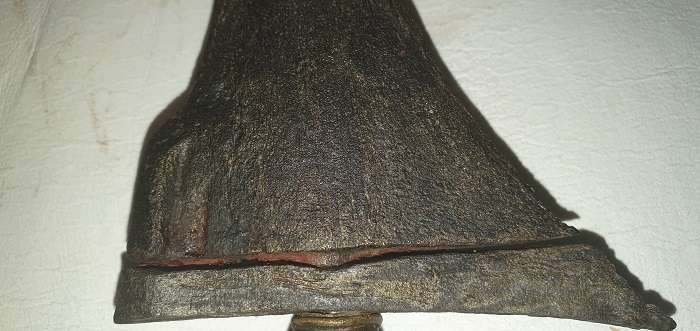
Keris east Java, complicated mistical high keris. Contains an old spirit...
Pendok brass, Tortoise shell inlay.


Keris east Java, complicated mistical high keris. Contains an old spirit...

Keris name: Kiayi Gaja Lawas
Pamor:
Dapur: Sempana
Tanguh: Majapahit 15th century
Hilt Raksasa type, bone.
Pendok silver
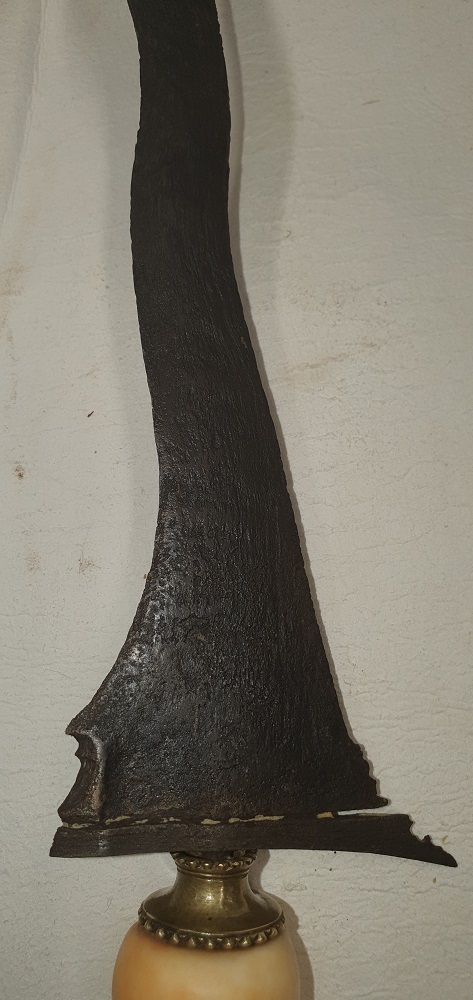
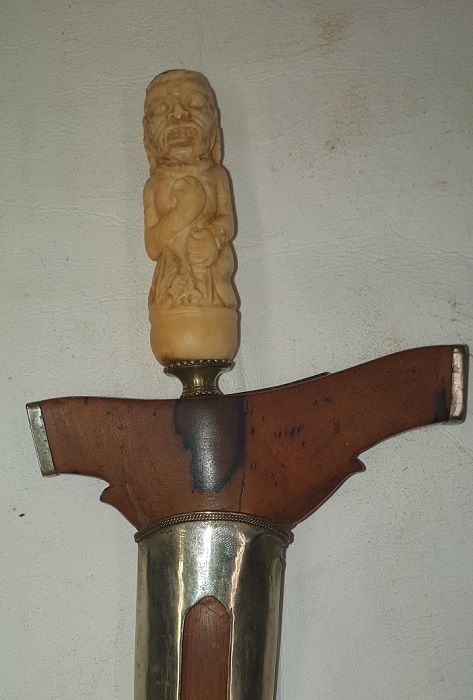
Keris east Java, pusaka heirloom, against black magic, and for good leadership. High keris.
Hilt Raksasa type, bone.
Pendok silver


Keris east Java, pusaka heirloom, against black magic, and for good leadership. High keris.

Keris name: Kiayi Ilmu Hitam
Pamor:Pandit Bala Pandita
Dapur: Tilam Upih
Tanguh:East Java 15th century
Pendok: Topengan Bonaspati.
Hilt: East Javanese Nunggak Semi type, kendit
Mendak Selut Silver.
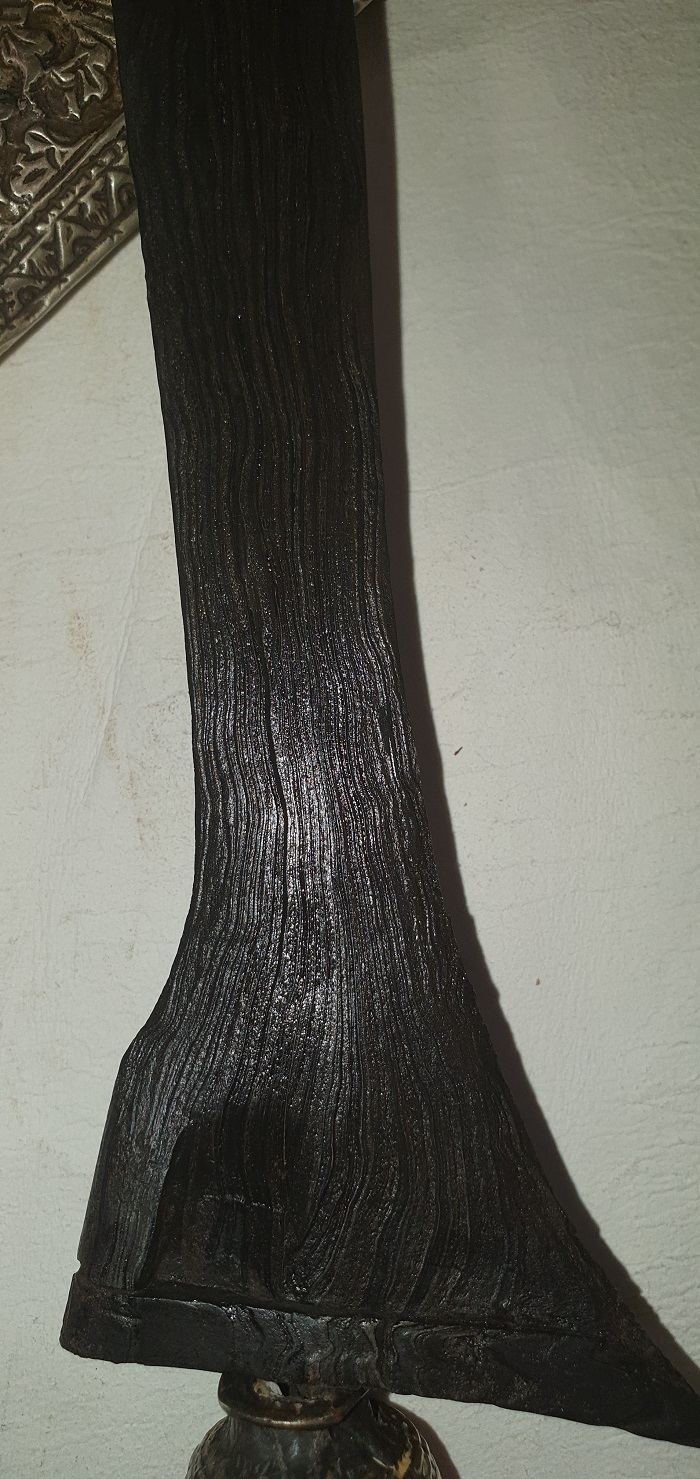
There was a text with this keris:
Keris Majapahit, spiritual power. Very old energy.
Pendok: Topengan Bonaspati.
Hilt: East Javanese Nunggak Semi type, kendit
Mendak Selut Silver.

There was a text with this keris:
"Yasya sarvē samārambhāh kāmasaṅkalpavarjitaḥ jñānāgnidagdhakarmāṇaṁ tam ahuh paṇḍitaṁ budhaḥ."
The keris also has a combong, a misty opening in the middle, intended to suppress negative thoughts in people / spirits and to generate positive thoughts.
Very grateful that this keris came my way!
This saying comes from the Babagavad gita, Chapter 4, Verse 19. Translated
The soul, a small part of God that is an ocean of bliss, naturally seeks bliss for itself. Covered by the material energy, however, the soul falsely identifies with the material body. In this
ignorance, it performs actions to attain bliss from the world of matter. Because these actions are motivated by the desire for sensual and mental pleasure, they bind the soul in karmic
reactions.
On the other hand, when the soul is enlightened with divine knowledge, it realizes that the bliss it seeks will not be achieved through the objects of the senses, but in loving service to
God. It then strives to perform every action for the pleasure of God. Whatever you do, whatever you eat, whatever you offer as an offering to the sacred fire, whatever you give as a gift, and
whatever cuts you make, oh son of Kunti, do them as an offering to me. " (Bhagavad Gita 9.27) Because such an enlightened soul renounces selfish actions for material pleasures and dedicates
all actions to God, the works performed do not produce karmic reactions. They are said to be burned in the fire of divine knowledge.
Keris Majapahit, spiritual power. Very old energy.

Keris name: Kiayi Titik Ireng
Pamor:layerd
Dapur: Parung Sari
Tanguh:Majapahit 15th century
Hilt: Nunggak Semi type east Java.
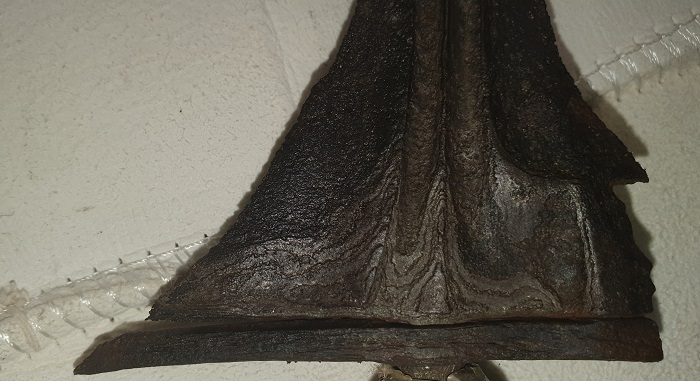
Keris Bali
Hilt: Nunggak Semi type east Java.

Keris Bali

Keris name: Kiayi Barong
Pamor:Pedaringan Kebak
Dapur: Pasopati
Tanguh: Bali 16th century
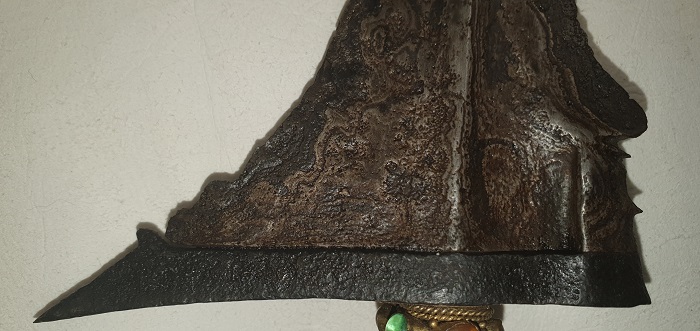


Keris east Java, pusaka heirloom, small amulet keris. Protection, ward of danger, protection.

Keris name: Kiayi Angin
Pamor: Adeg Papat.

Old pusaka in recent sarong

This is an example of how lots of pusaka's are kept, in a new dress, missing ganja, but comming from your father. These keris are still very valuable as heirloom, not as complete keris. I wil not change the dress or complete it with a ganja. I keep it like this...


Kudjang

Kudjang from the Borobudur time 9th century.
Tangguh Kebudhan

Fighting keris, Madura.

Fighting keris from Madura. This is absoluut the most copied warangka, made from heavy damascus steel.

The protectors of the holy heirlooms and my house
Tombak, the tombak has a much bigger ceremonial function as the keris.

Tombak, the tombak has a much bigger ceremonial function as the keris.

Tombak, the original bedroom tombak of Sultan HB VII
Name tombak: Kiayi Pelindung
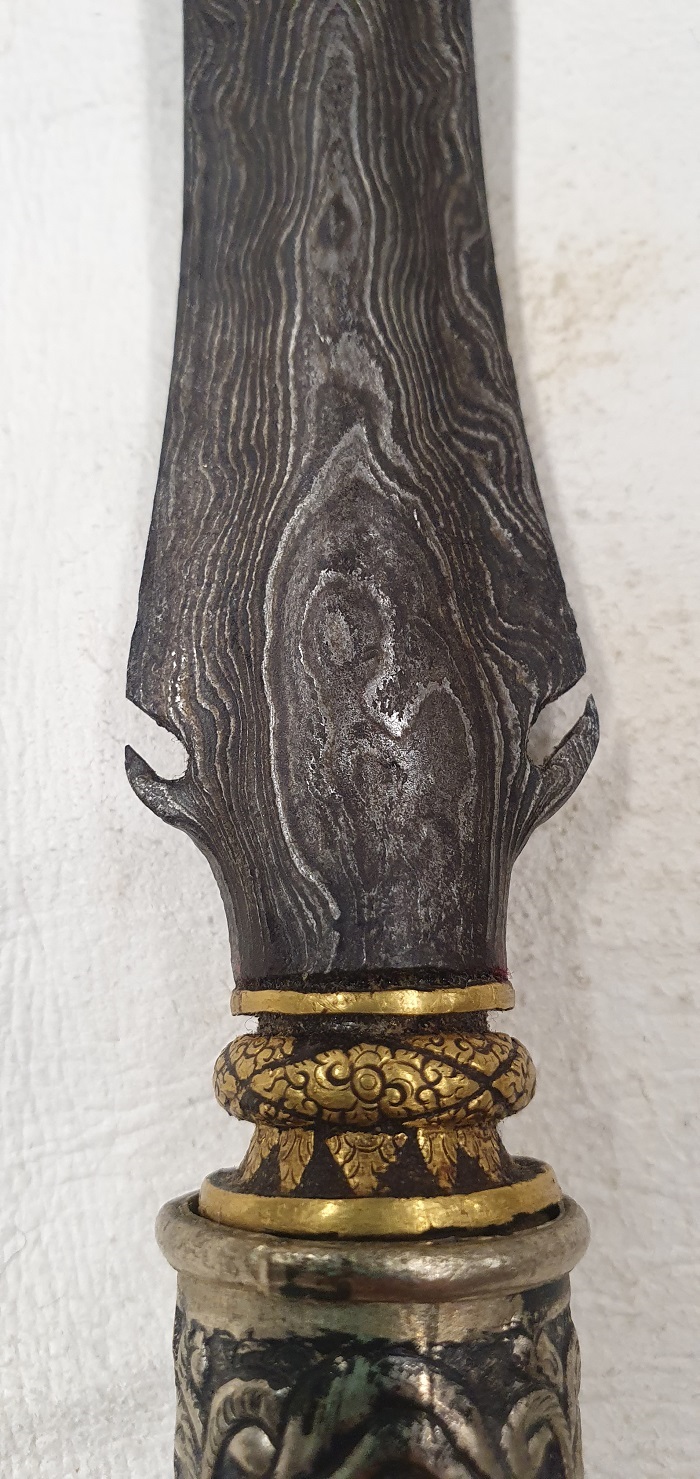
Tombak Pataka
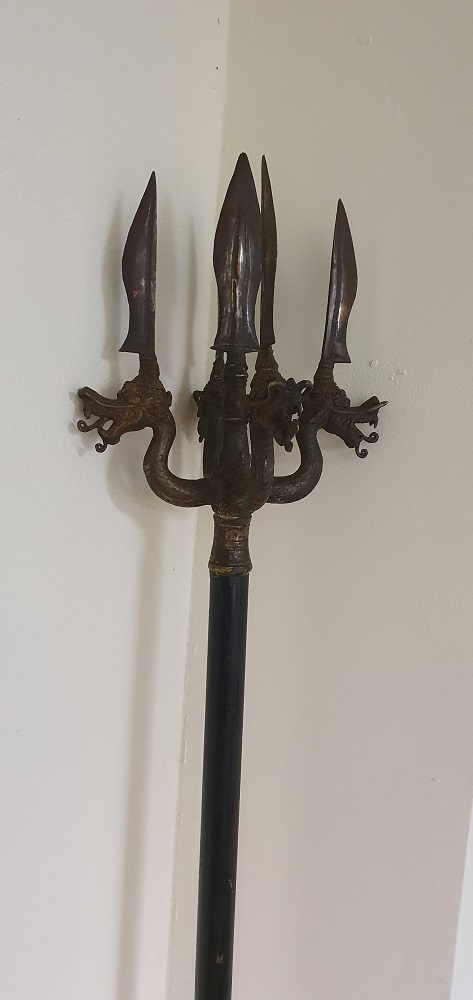
Trisula, the weapon of lord Shiva
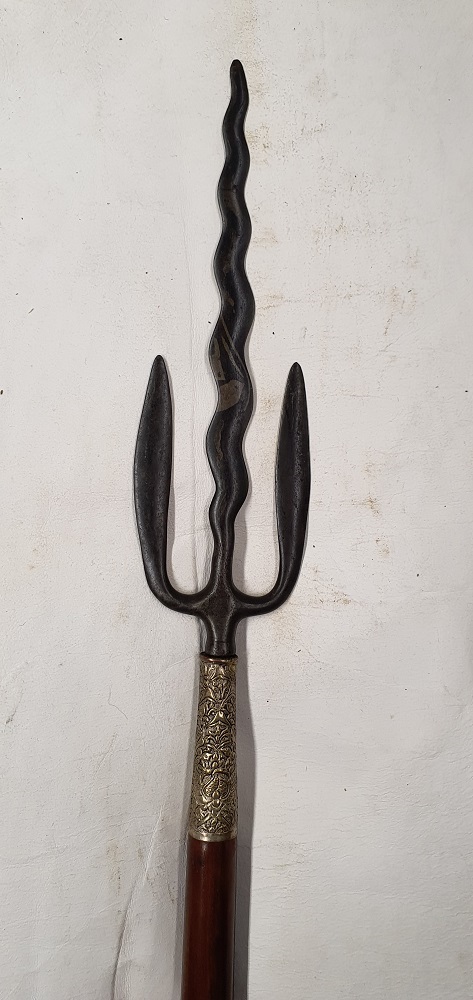
Name tombak: Kiayi Pelindung

Tombak Pataka

Trisula, the weapon of lord Shiva

The Gada, the weapon of lord Wishnu and the weapon of the temple guards the Dvarapala
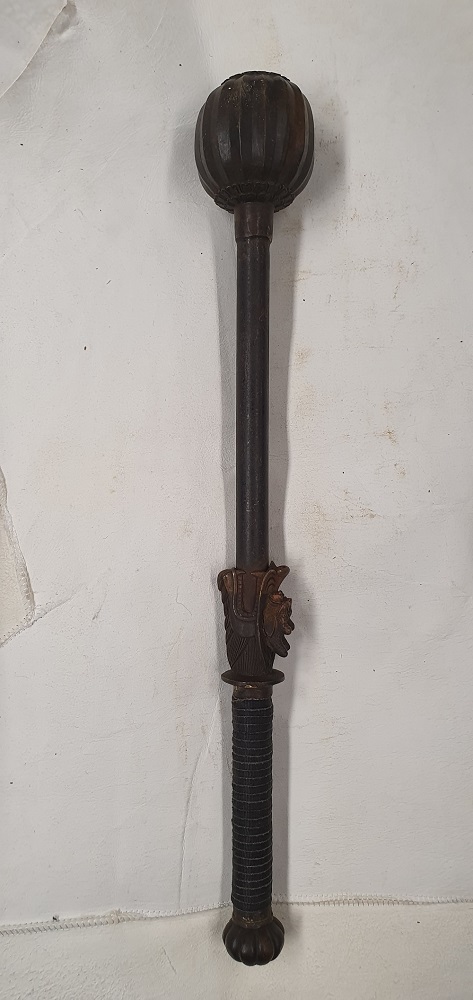



The guard and the protector of the keris and the tombak, the Payung Pusaka
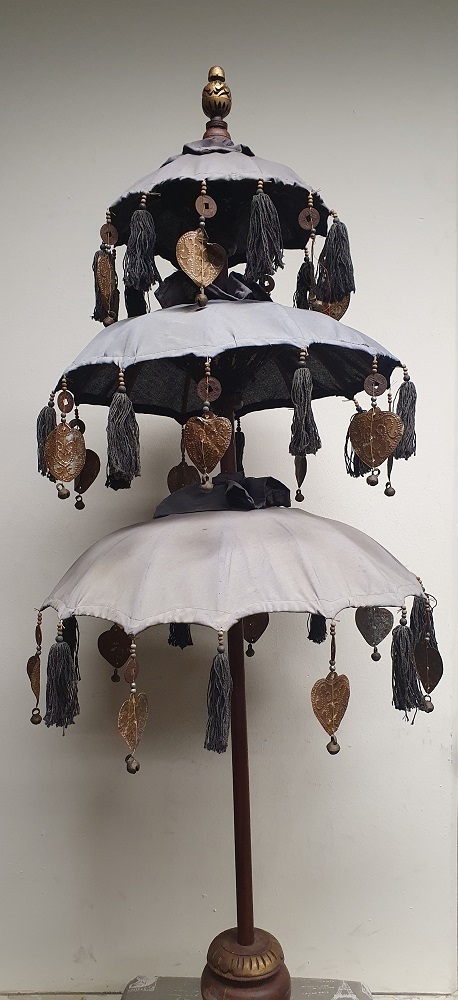

My Pusaka and their origins

Keris 1 and 2 are my first pusaka, Yin and Yang, the keris i got from my father.
Keris 3 is from a descendant from the priaji from Panarukan, uncle Eugene.
Kudjang 4 was a birthdaygift from Richard and Willemijn de Rooij.
Keris 5, 6 and 7 are from a descendant from Raden Mas Setjo di Redjo, brought to the Netherlands by his 3rd doughter.
Keris 8 and 9 are from a father in law.
Keris 10 is a own pusaka.
Keris 11 is from a descendant from the priaji from Panarukan, kept in Teuge.
Keris 12 is given as pusaka, comming from Jacolien van Breemen uit Den Bosch
Keris 13 is given as pusaka, comming from Marjanne uit Almere
Keris 14 is given as pusaka by Henk Brouwer
Keris 15, 16 and 17 are given as pusaka comming from family Jansen, heirloms from their father.
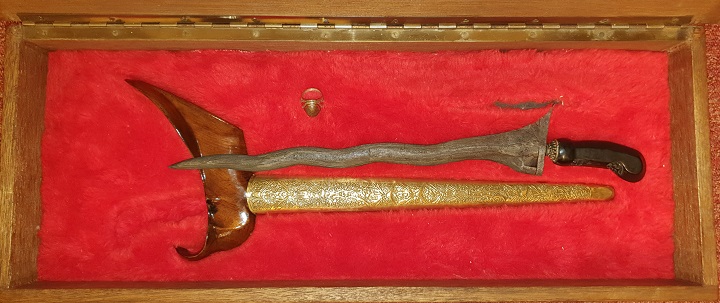
Keris 18, a pusaka given by Stephen Gharzi, Pencak Silat Guru from Rotterdam.
Keris 19, a keris received by mas kawin from Leenderd in Zutphen.
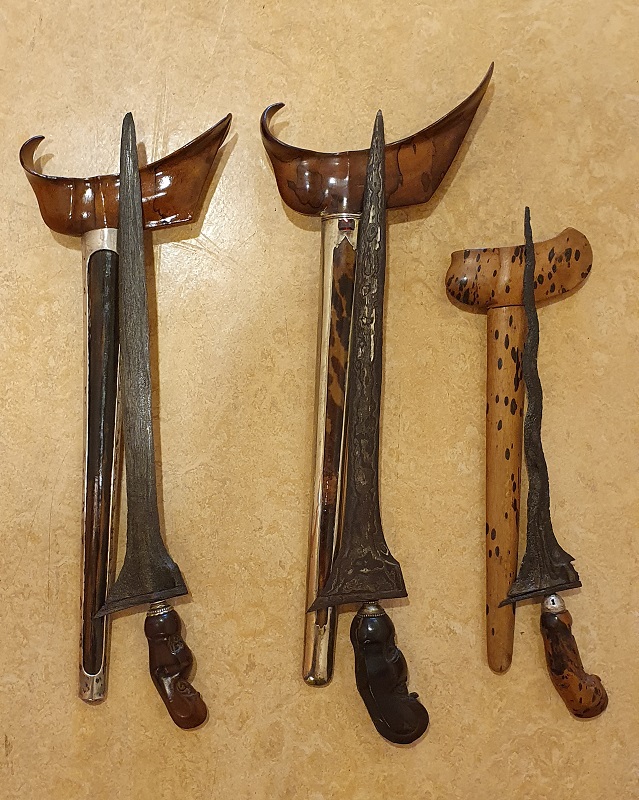
Keris 20, 21, 22, east Javanese Keris pusaka from Jan Zwemmer, received by mas kawin from his son Mr C. Zwemmer.
Keris 23, verkregen via mas kawin van Ellen en Martin de Munck.
Keris 24, een fantastische keris Kyai Mundharang, van een Indische familie uit Naarden. Blade is around 1840 PB IV, Dapur Mundharang, Pamor Pedaringan Kebak. (source Philip Hartmann!)
Keris 25, Mooie Oost Javaanse keris, verkregen via mas kawin van Herman de Klerck. Meegenomen door zijn oom Kaptein Melief van de grote vaart.
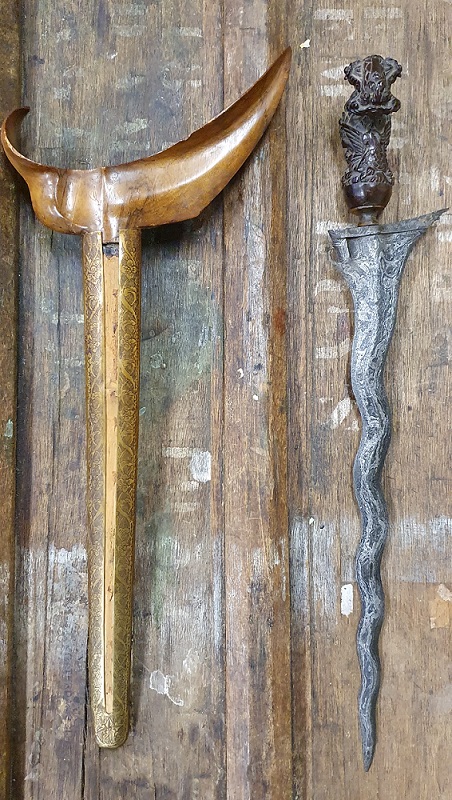
Keris 26 Nog een fraaie oost Javaanse keris verkregen van Frans de Klerck, ook via zijn oom Kaptein Melief van de grote vaart.
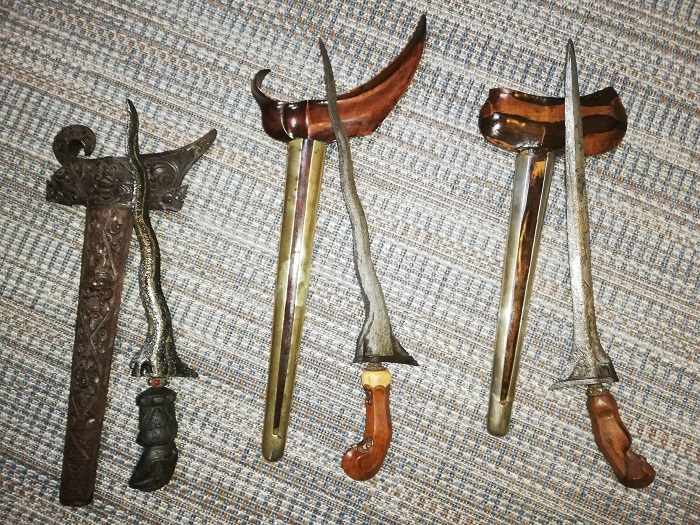
3 very powerfull pusaka keris from the familie Jansen.
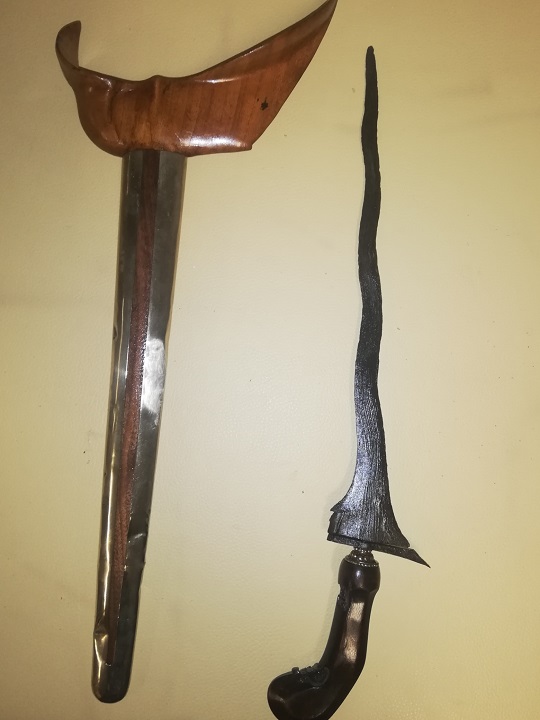
An Adeg keris from Henk Brouwer
1.jpg)
An old Pusaka from Jacolien van Breemen.
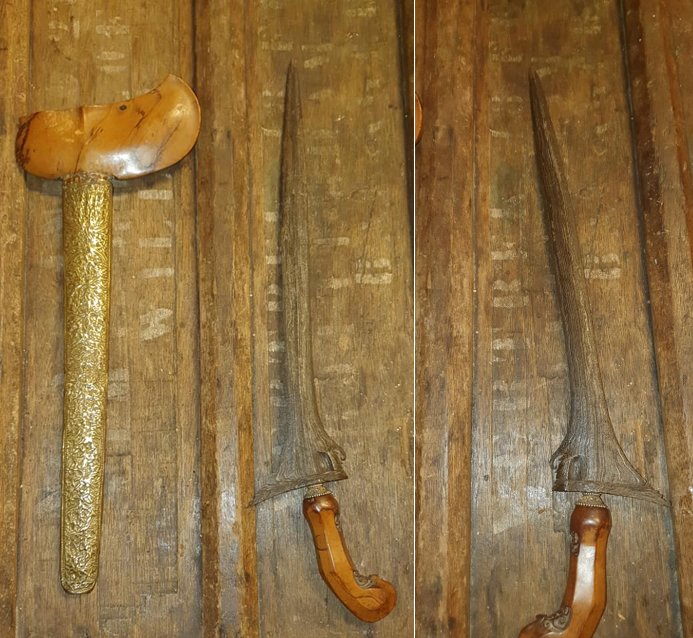
Beautiful keris from Marjanne from Almere.
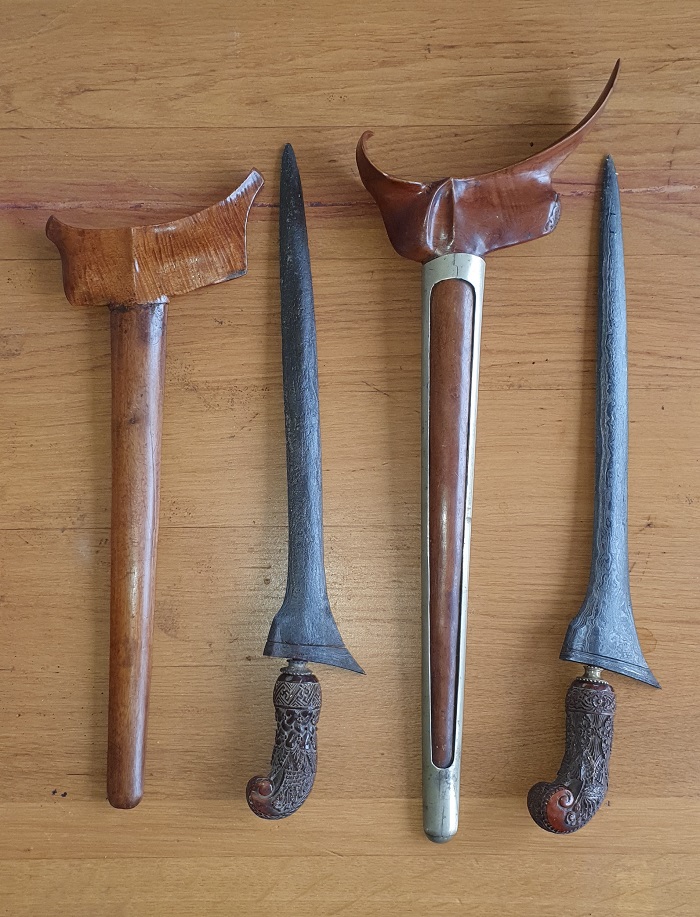
Some falily pusaka, back home, from Hein and Jolanda.
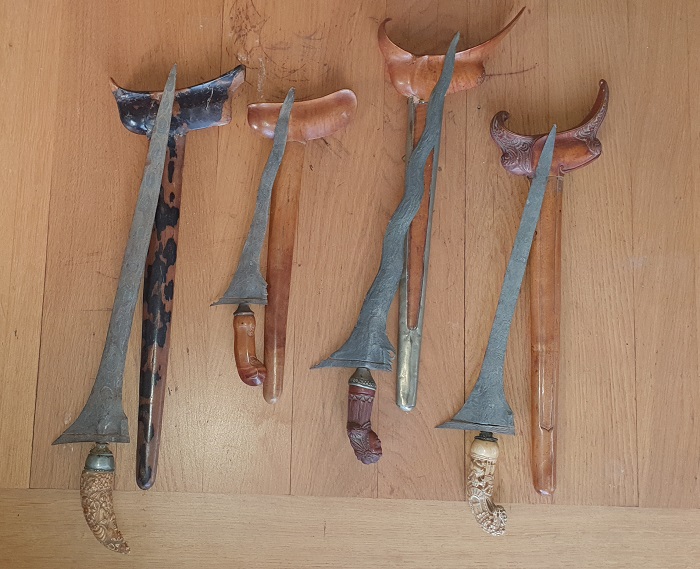
So glad that also these family keris found their way back home from Jan de Nooij.
 Jeroen en Mieke
Jeroen en Mieke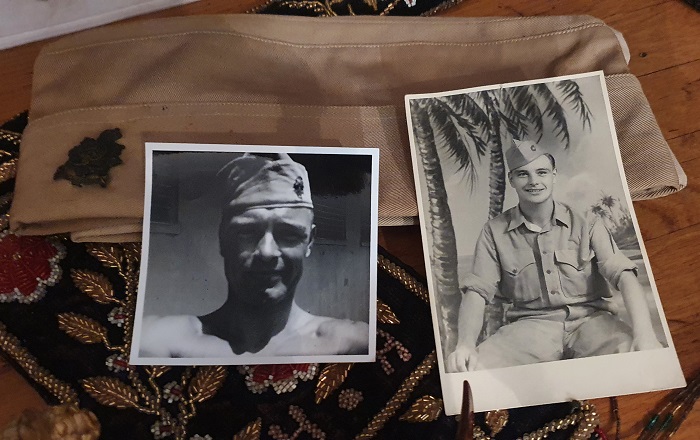
Geweldige foto van hun vader als KLer in Indonesië
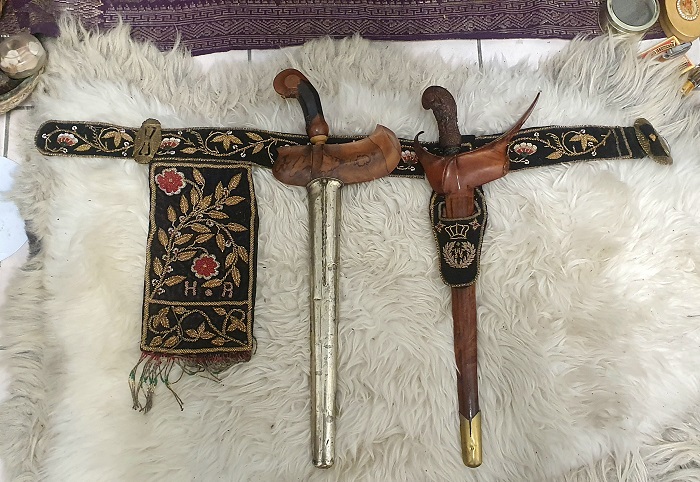
Reunited again with lost family, from Jeroen and Mieke.
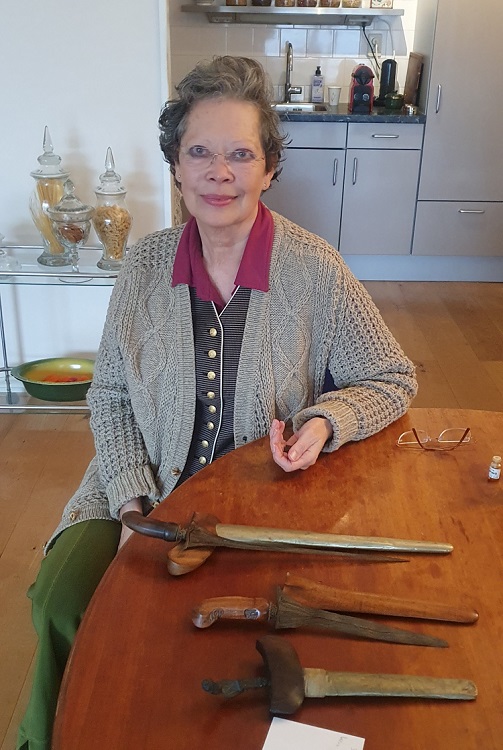
De bijzondere kerissen van Maud, zeer waardevolle schenkingen!
Zo kreeg ik een mail van Hugo Kamps, hij wilde de kerissen schenken die na het overlijden van zijn moeder op zolder waren gevonden. Een tijd kapsule met heiligdommen van Lampung.
Hugo herinnerde nog dat zijn vader, een ijzervreter die vrijwillig naar Sumatra was gegaan, probeerde een keris op te hangen. De keris was er niet mee eens en viel ineens van de muur en kwam precies tussen zijn tenen terecht en bleeft in de grond steken. De vader, die wist van de mystieke keris, na jaren in Indonesie, besloot daarop de voorwerpen in de kist te doen en ze nooit meer aan te raken....
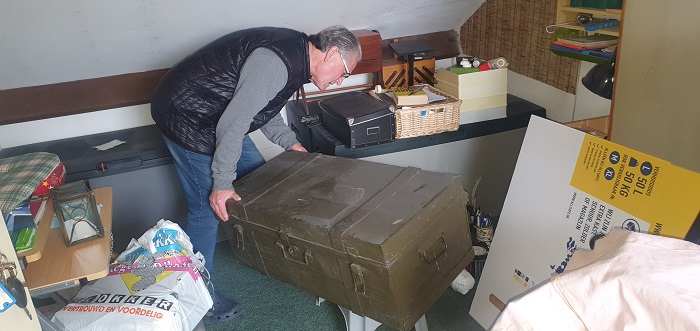
De kist is na komst in Nederland opslot gegaan en sinds dien on aangeraakt gebleven
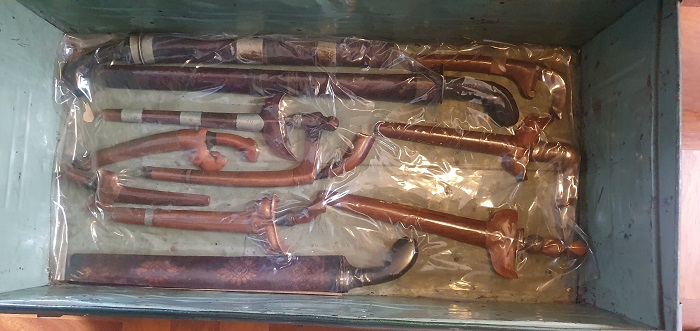
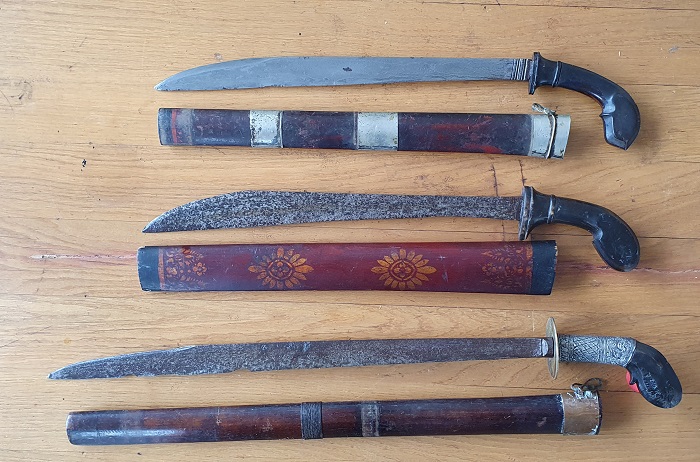
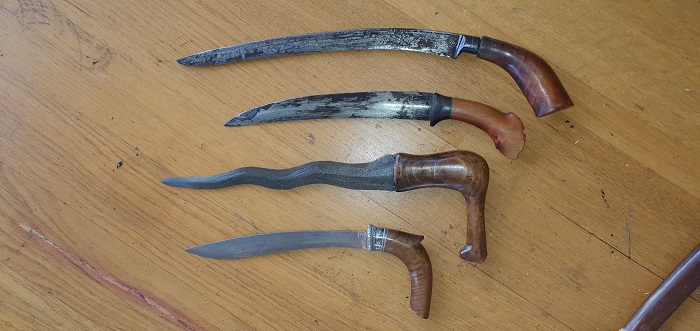
De vloek van de Javaan. Zo kreeg ik een email van Ron Jurgens, hij wilde kerissen schenken van zijn vader, dhr Jurgens die op12 november 1947 met de SMN de GROOTE BEER naar Indonesië vertrok.
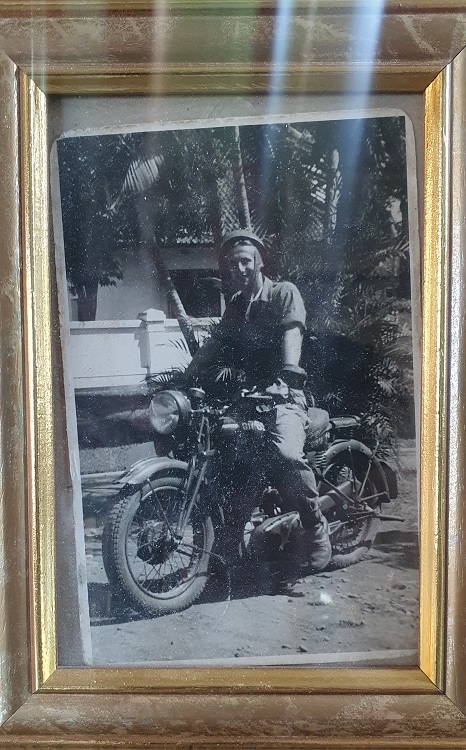
Toen ik de kerissen zag herkende ik direct de aankleding, toeristen kerissen gemaakt voor de verkoop, leuk als soevenier...
Ron vertelde me welk ongeluk de kerissen hadden gebracht, en toen de vader de kerissen aan zijn zoons schonk gebeurde het zelfde....ongeluk onder de broers...
De Javaan die ze verkocht, wist dat deze kerissen ongeluk brachten, en heeft opzettelijk het stuk toeristen ijzer verwisseld met deze echte pusaka kerissen in de schede gedaan, met het doel de eigenaar en de kinderen op een spirituele manier te betoveren. De verhalen zijn zoals bekend, zware mishandeling met oa brandplekken, en tegenspoed zoals hoord bij zulke kerissen
De Linker keris heeft van de gelige vlekken in het ijzer wat wijst op besi kuning, heilig ijzer!
De rechterkeris heeft lange lijnen over het blad, het element lucht, zeer aktieve kerissen die veel onderhoud nodig hebben anders gaat het spoken... Geef je de kerissen geen voeding, dan nemen ze de energie van hun omgeving, vaak met ziekte tot gevolg!
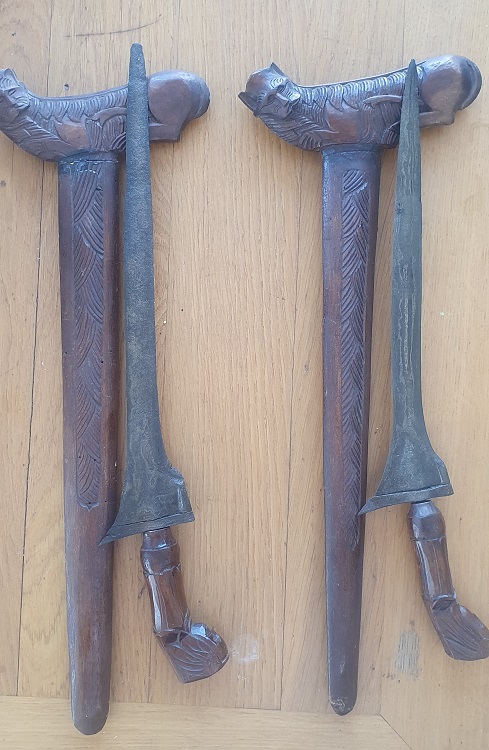
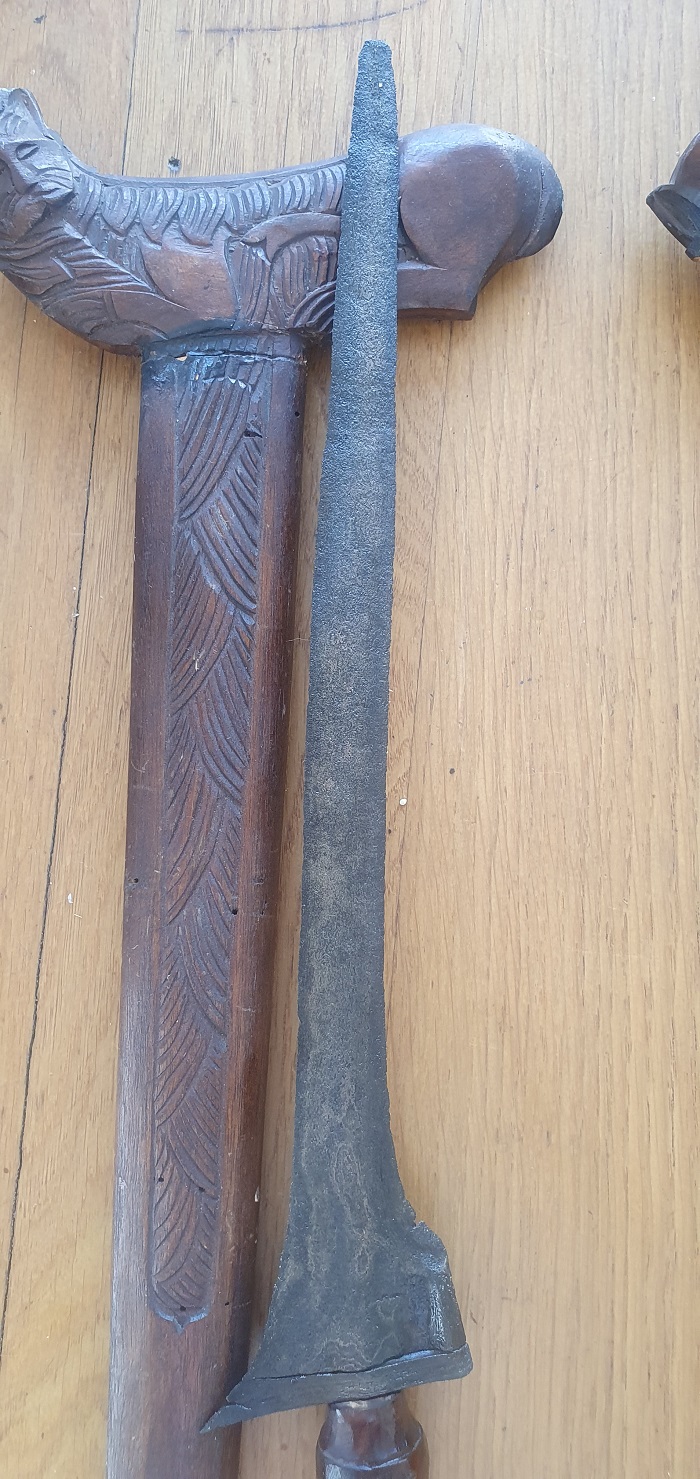
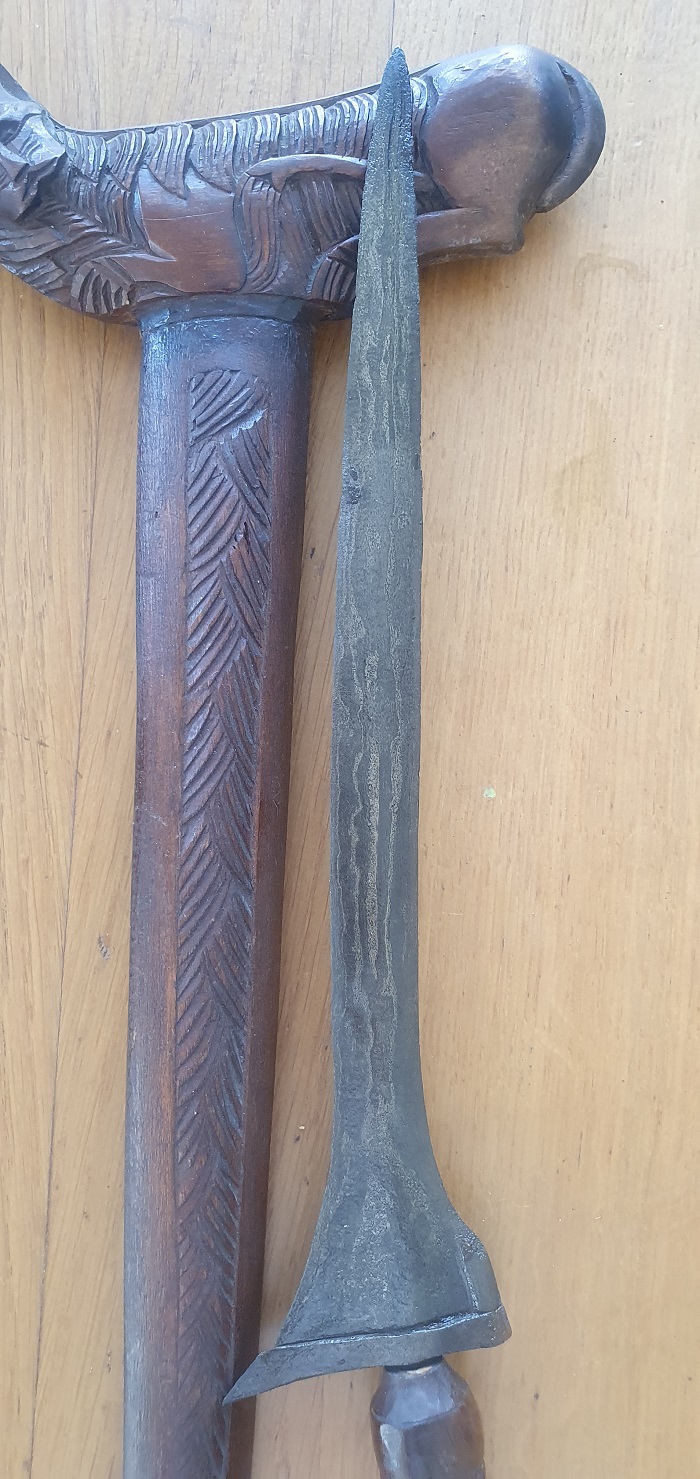
Pusaka keris, received from a family in Amersfoort:
A keris tempur, fighting keris and a keris Mojopahit
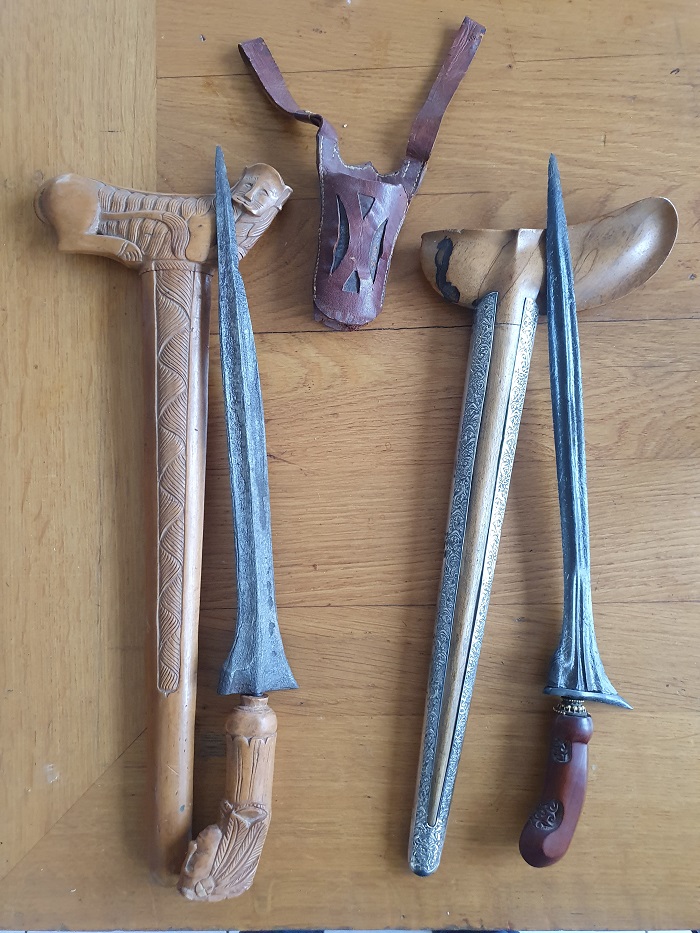
Keris pusaka
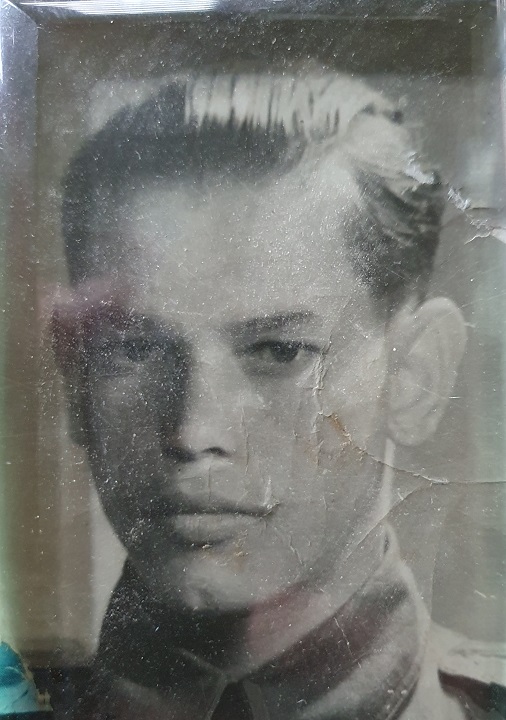

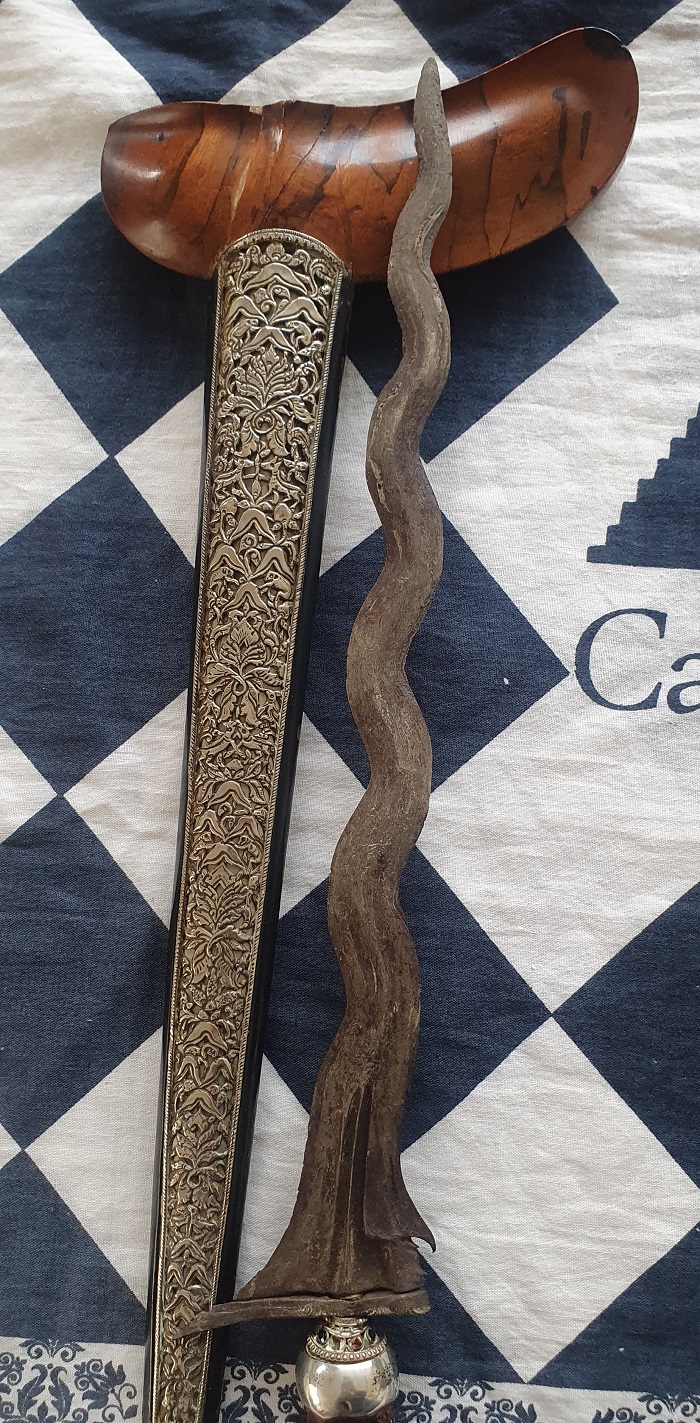
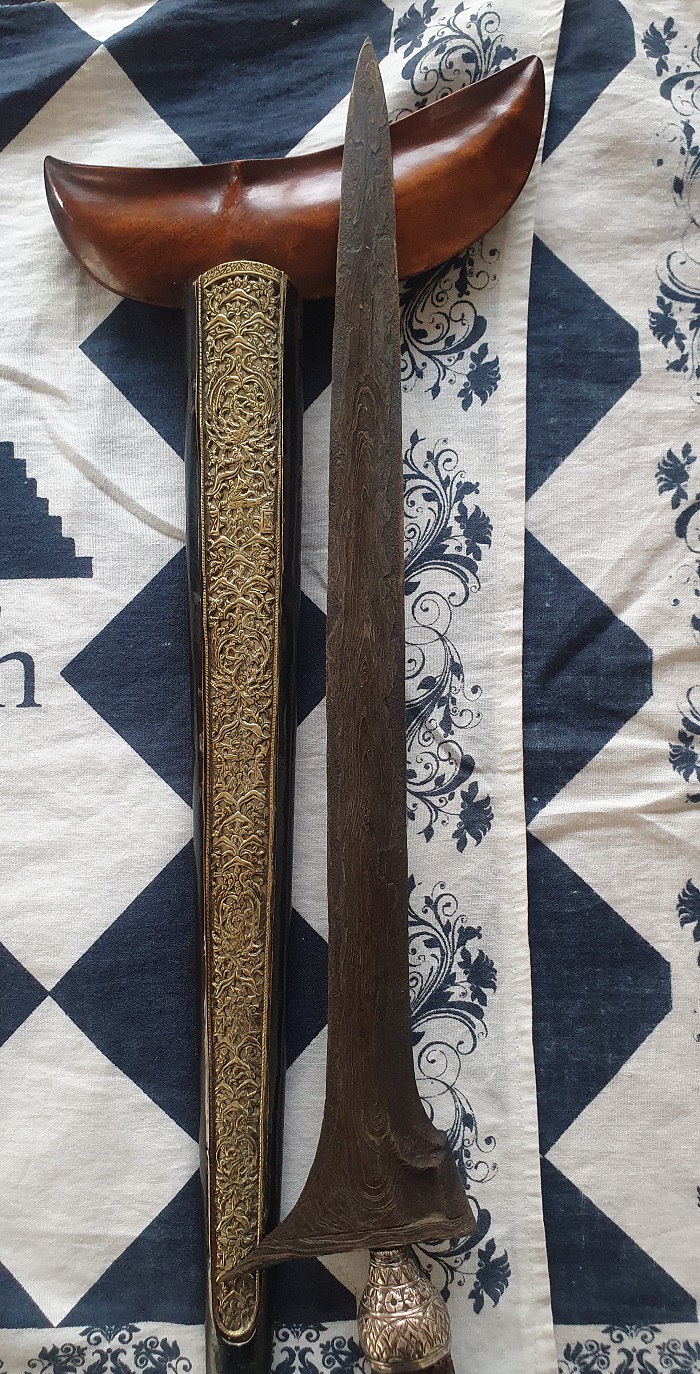
Wranka Wulan Tumanggal
Zo kreeg ik een email van mevr. A. Meeusen. Ik had voor de Corona crisis al een kontakt met mevr. Meeusen ivm het onderhouden van haar kerissen, maar het voelde toch niet goed, het gevoel was of ze
geremd werd door de keris en pedang. Omdat de kerissen zich nooit tegen haar gekeerd hadden besloot ze toch om de kerissen naar een goed dres te brengen. Ze voelde toch ook wel een ongemak als ze
op zolder was bij de kerissen.
Toeval of niet, ik was in dezelfde stad als waar mevr. Meeusen woonde op bezoek bij een vriend...
Toen ik de kerissen schoonmaakte kwam het geheim naar boven, er stond een Naga op het blad, de koning van de onderwereld, en het pamor was buntel majit, lijkwade... Bron Internet:
"Veel kerissen kenners zijn van mening dat dit pamor motief een minder goede magische kracht heeft. Als men er niet geschikt voor is kan het de bezitter rampen en onheil bezorgen. Het is
daarom verdtandig vooraf deskundigen te informeren of het wel of niet geschikt is om te bezitten."
